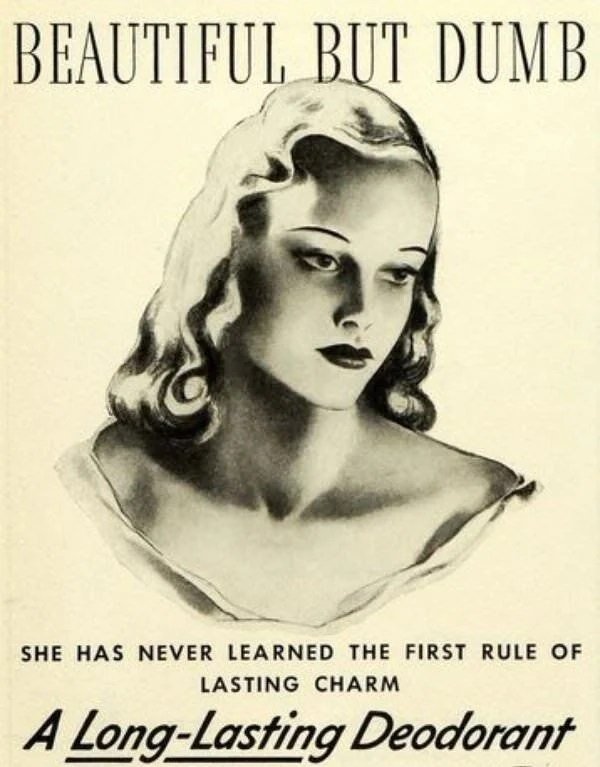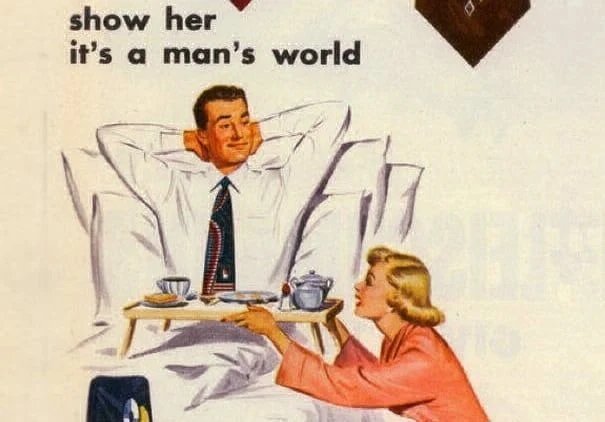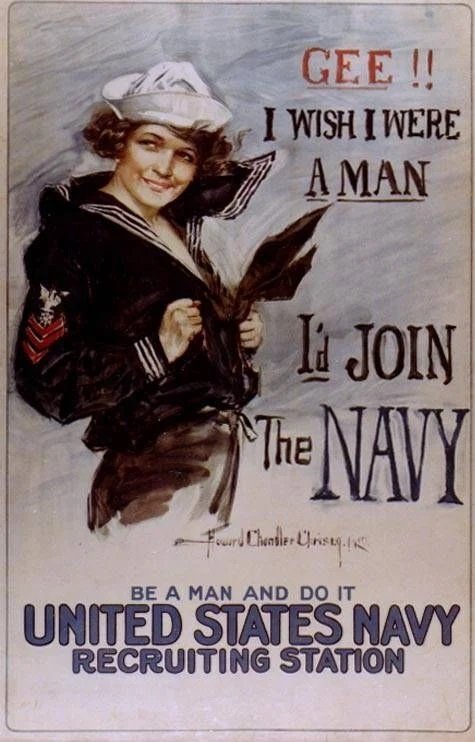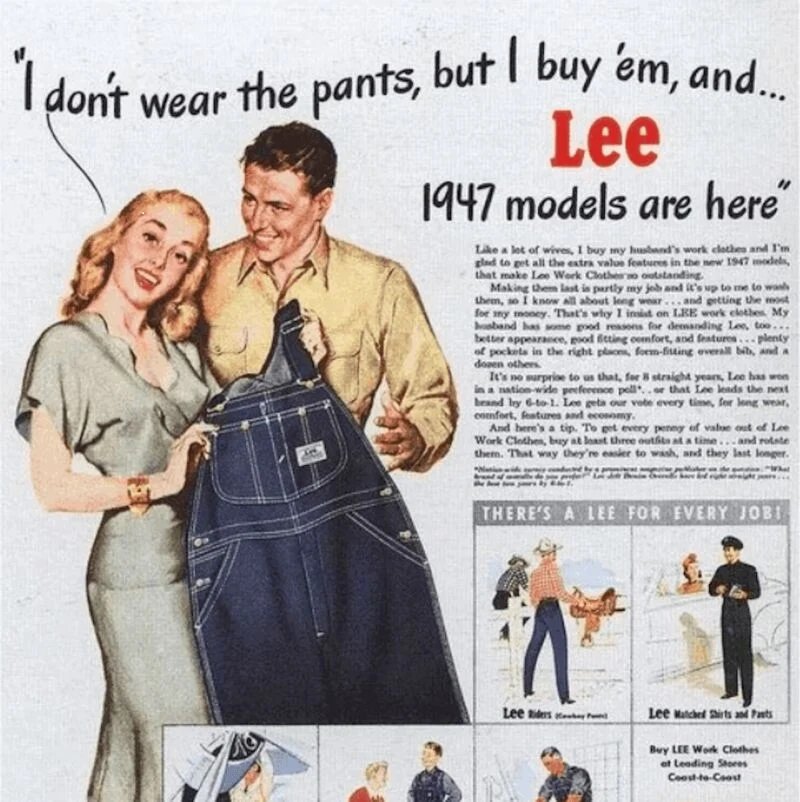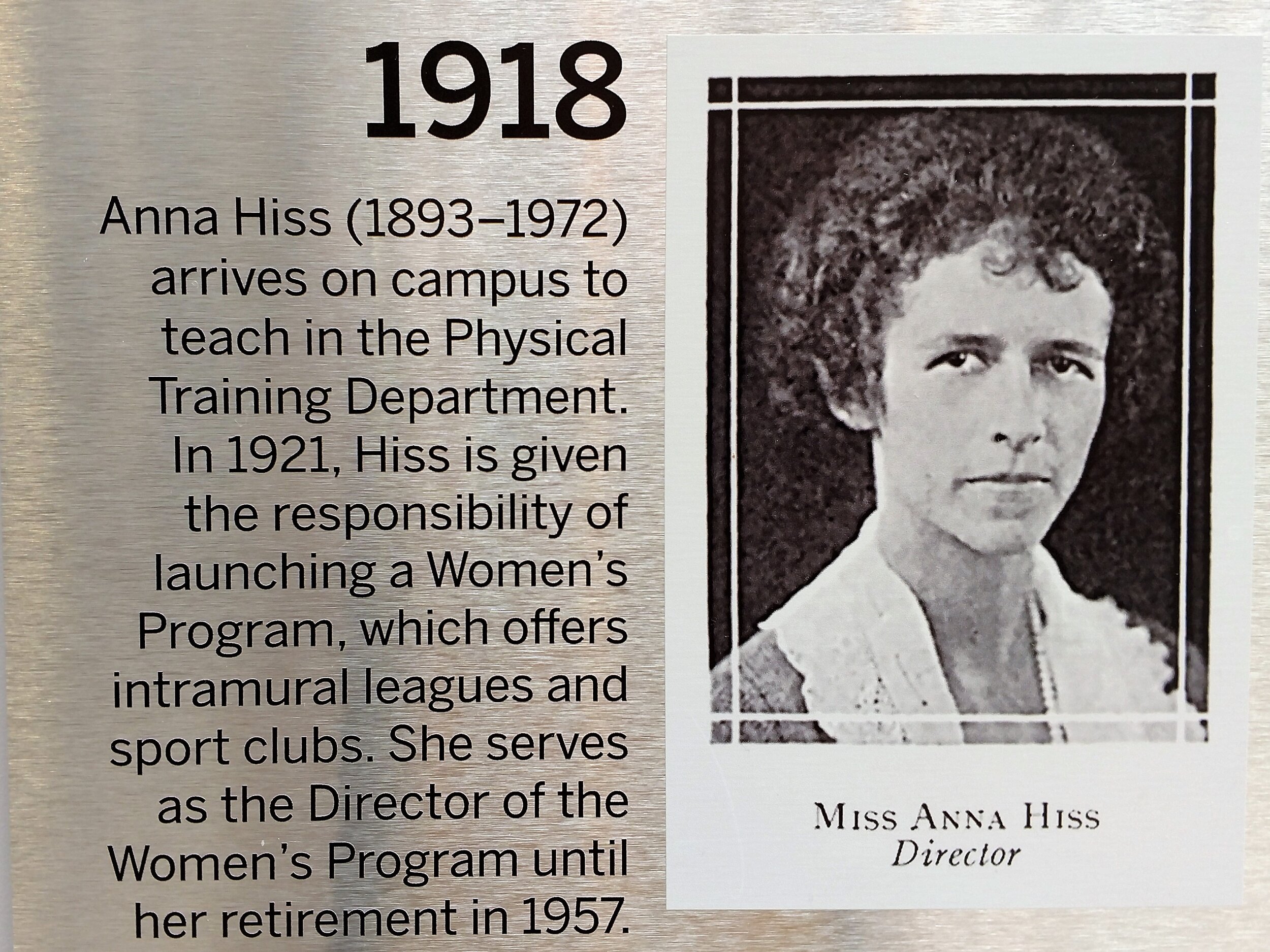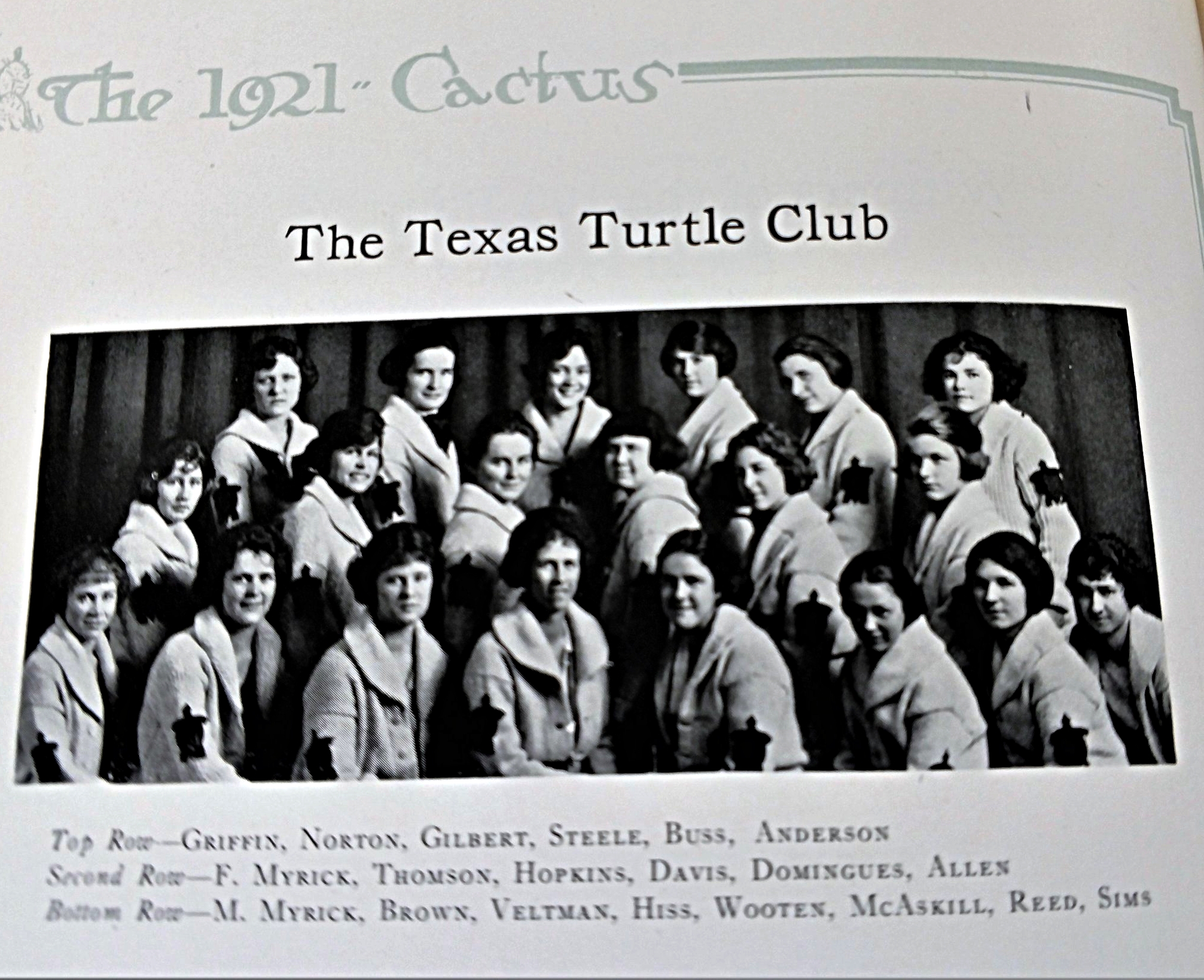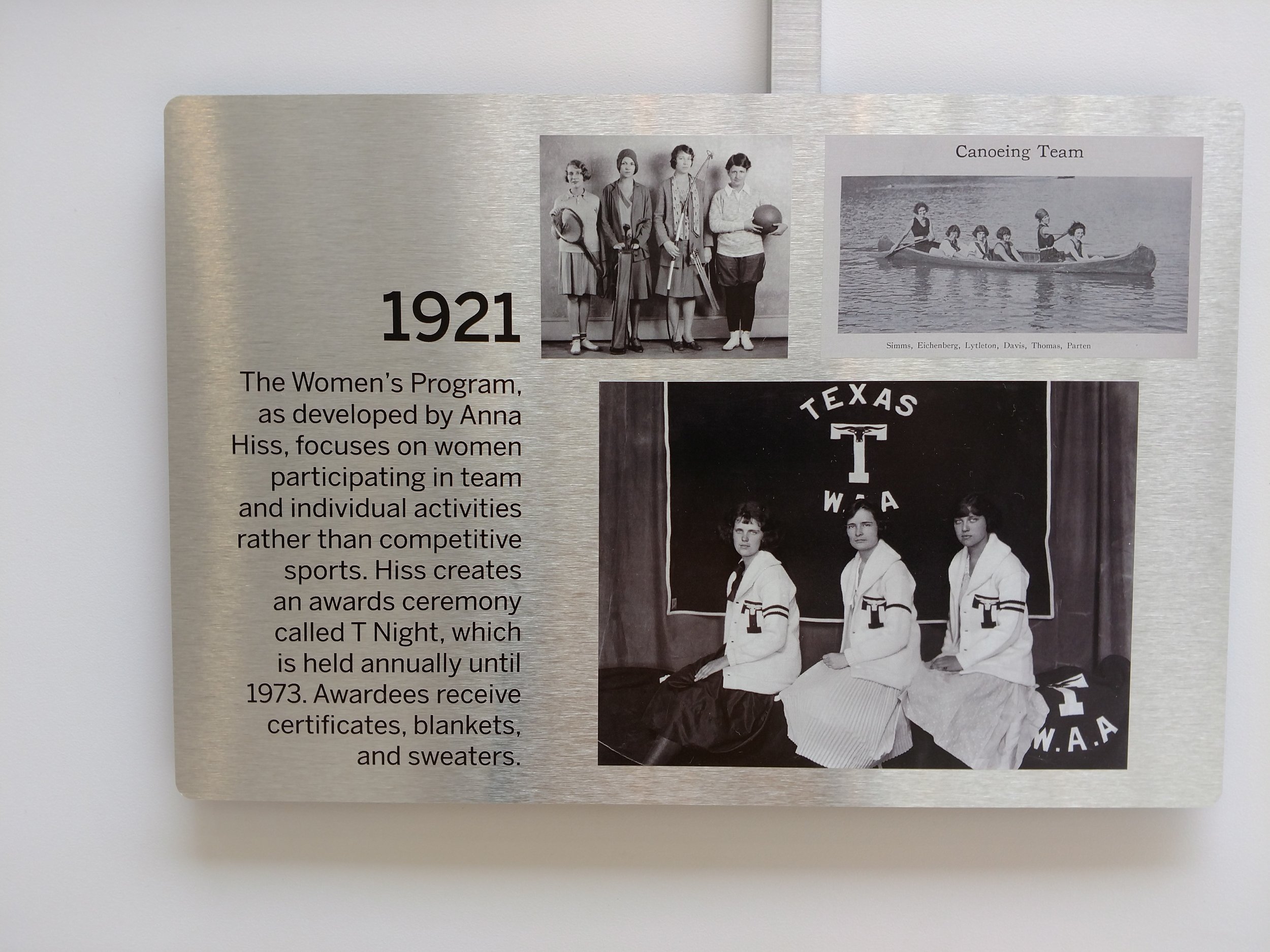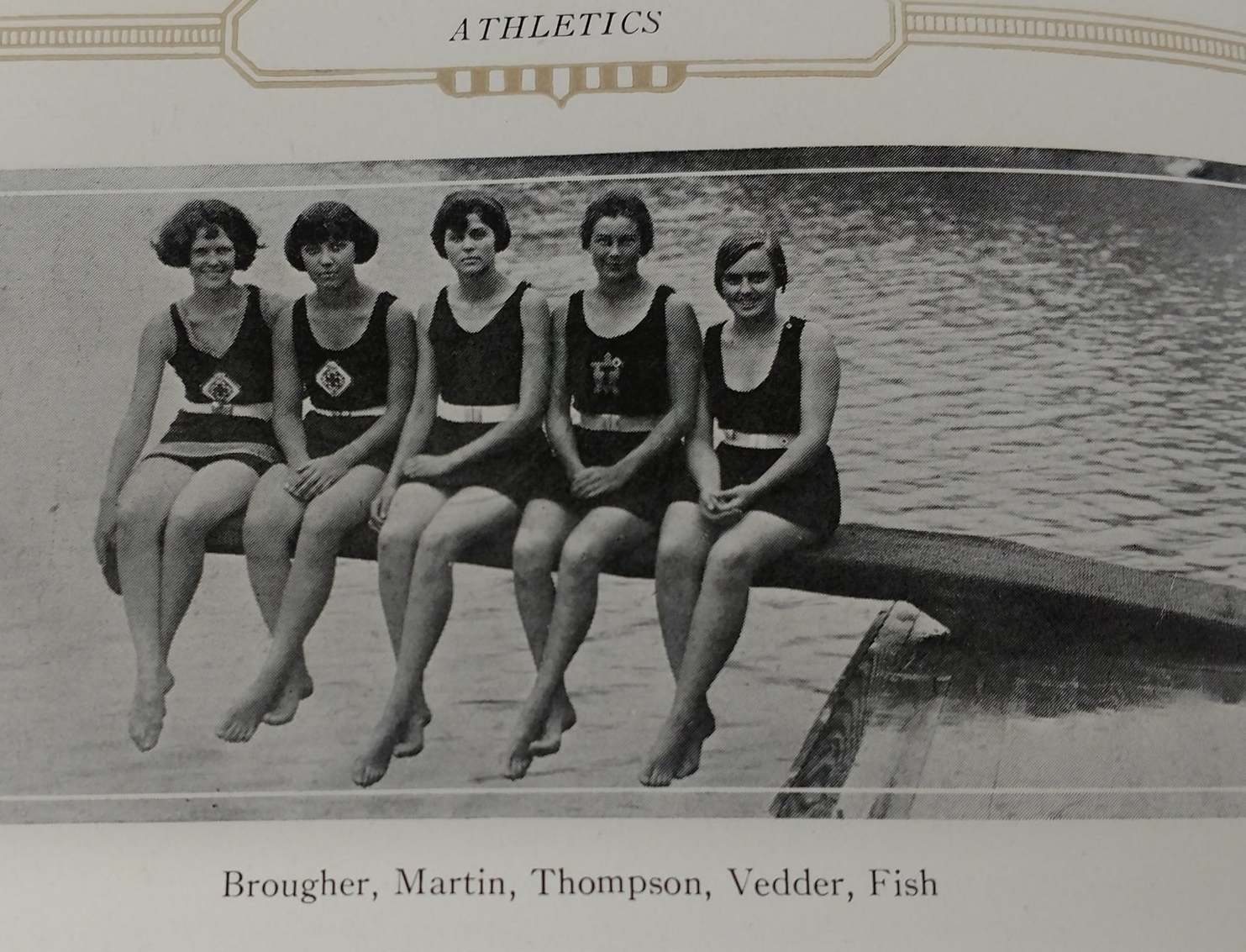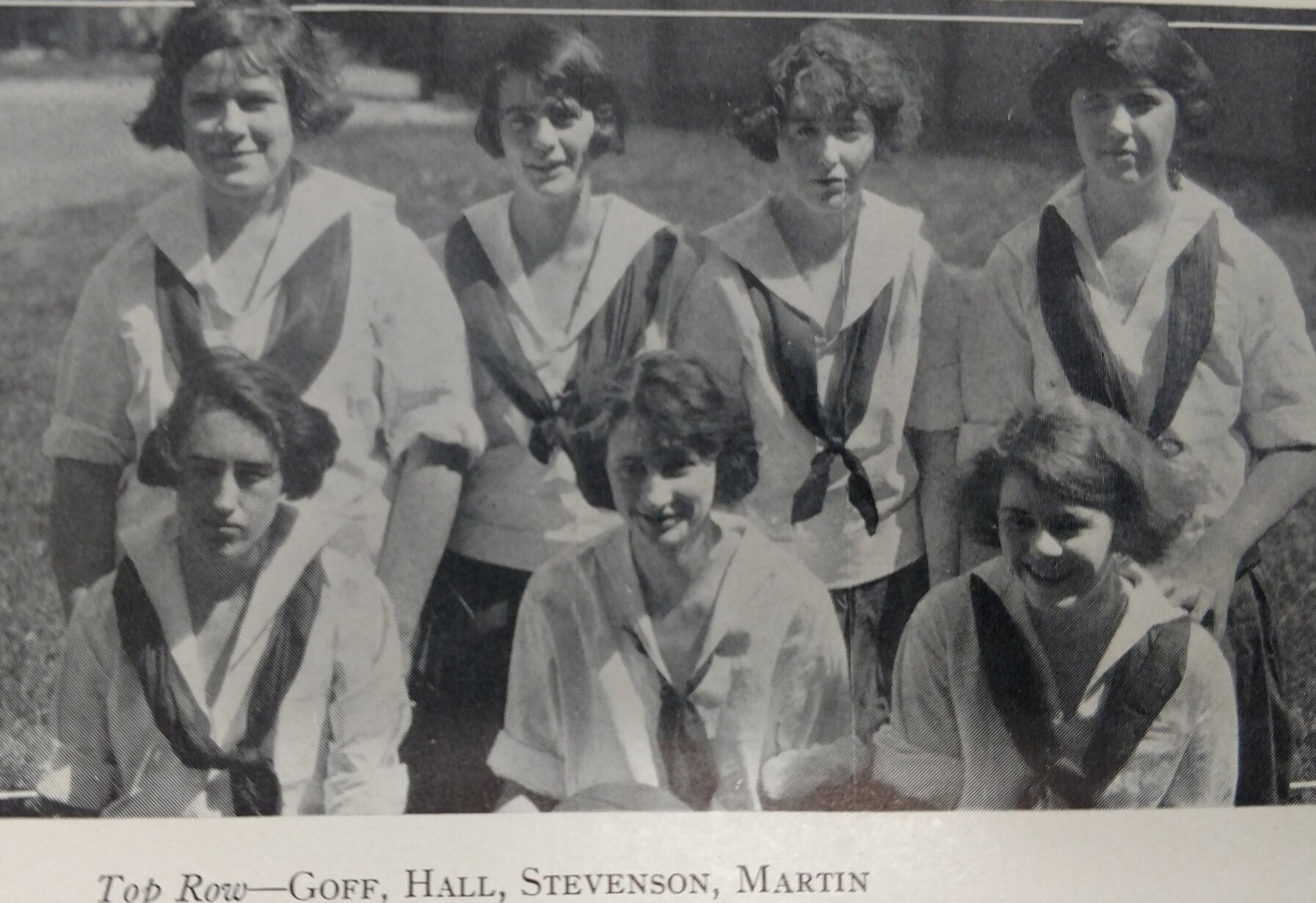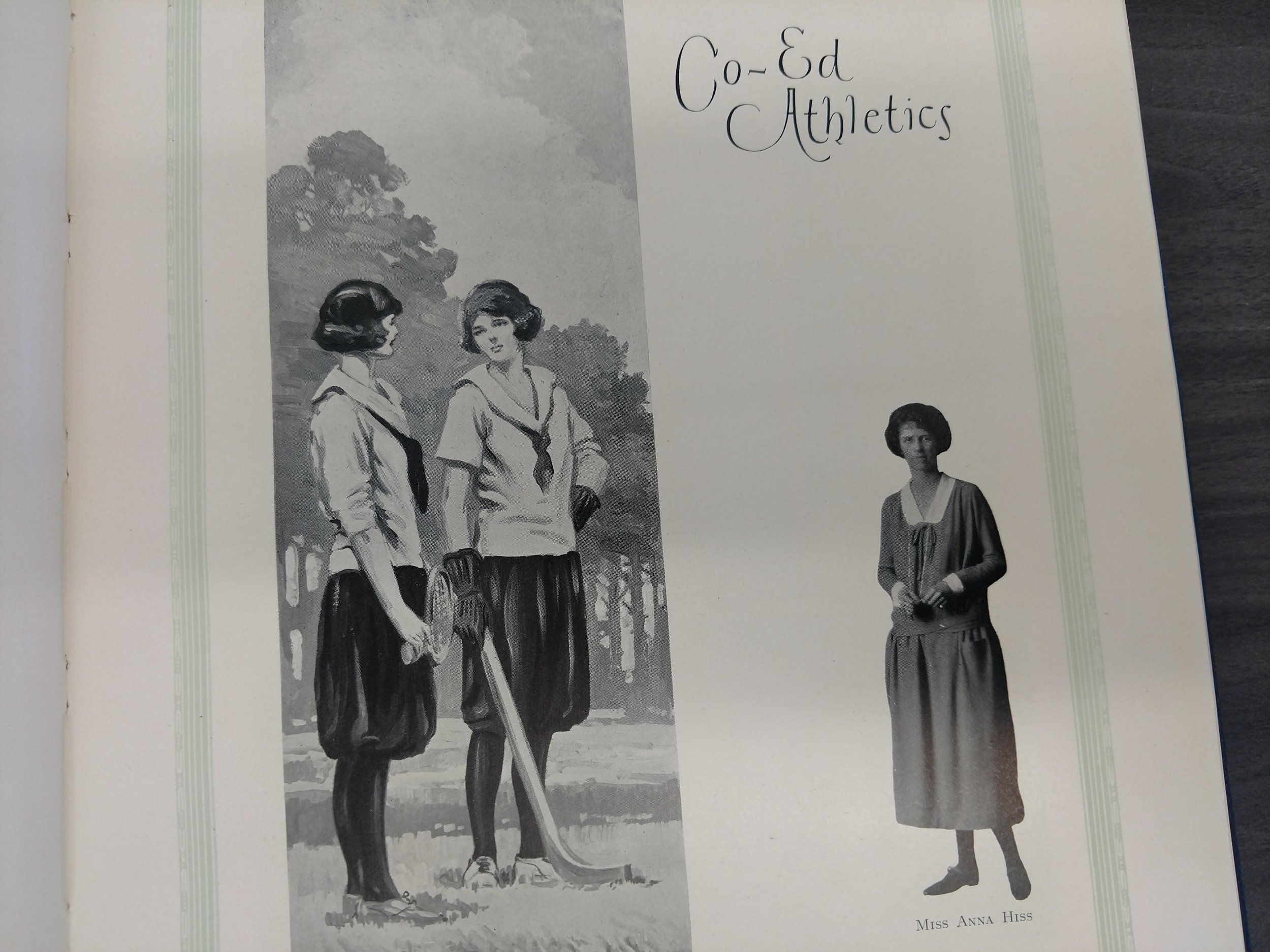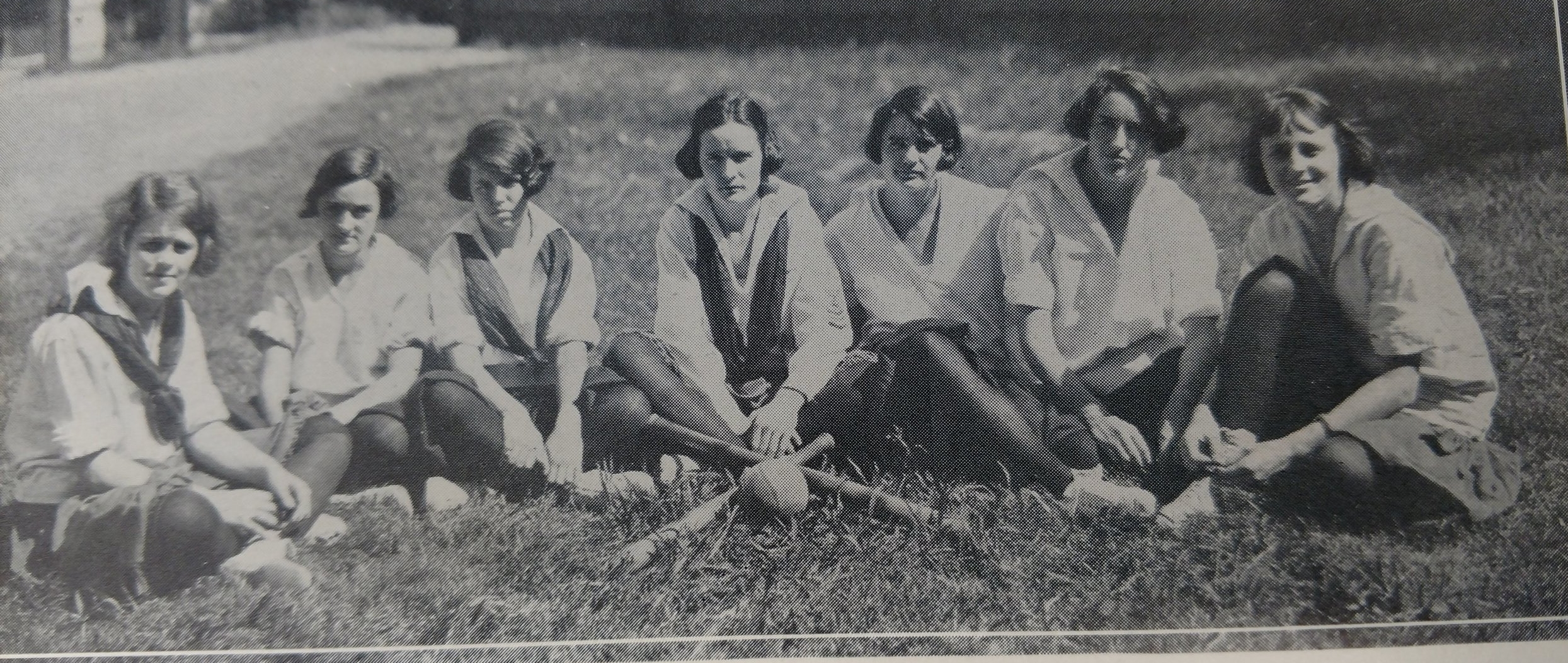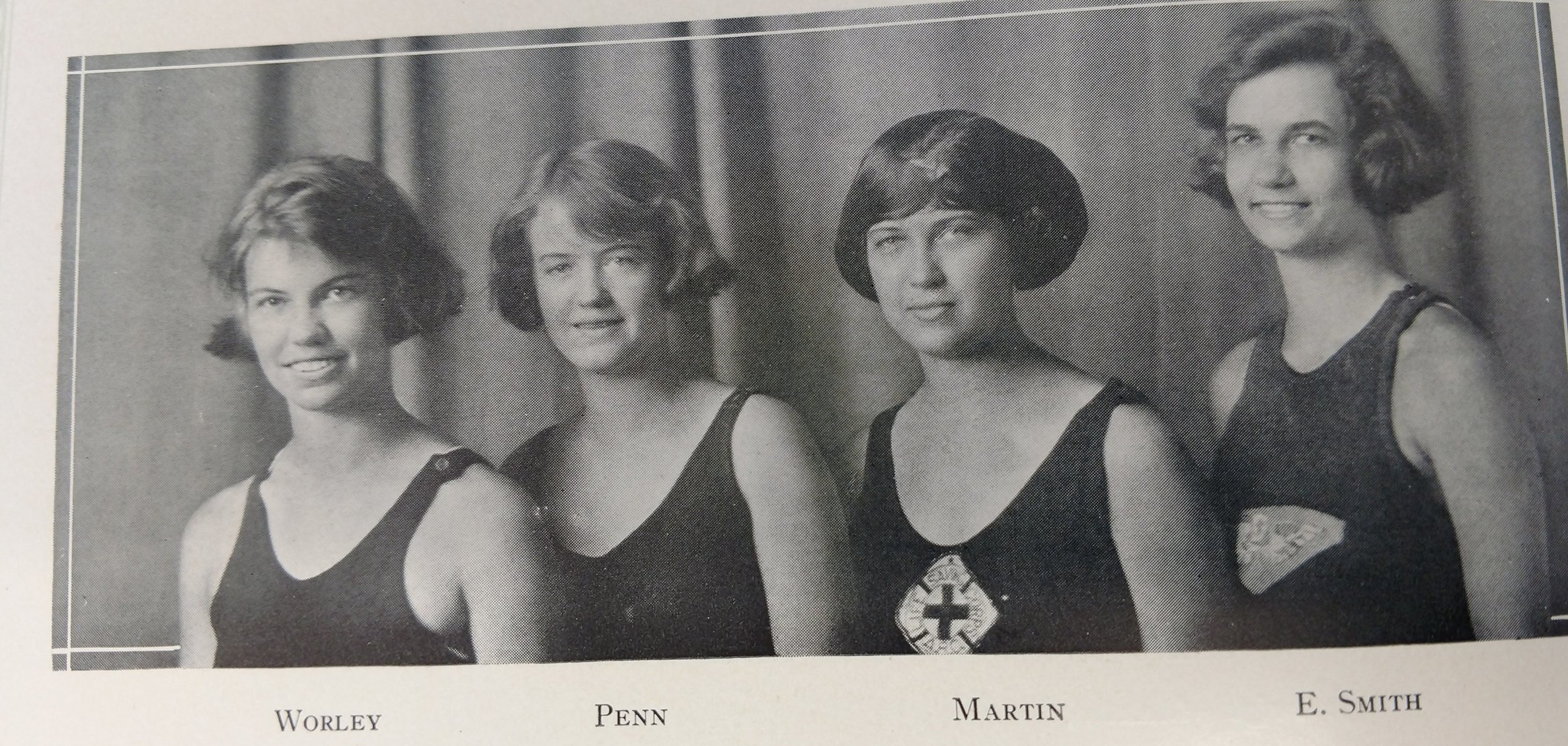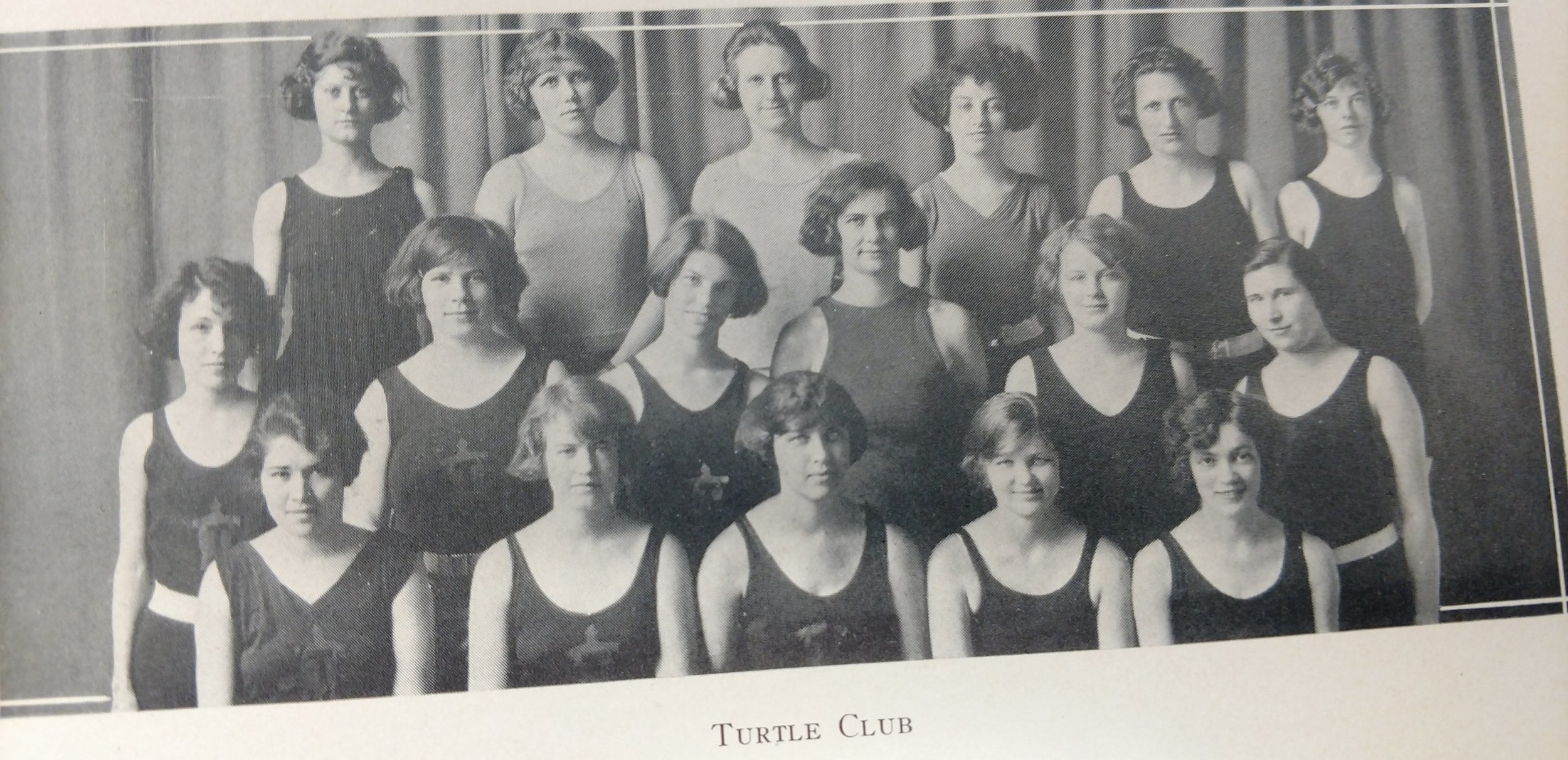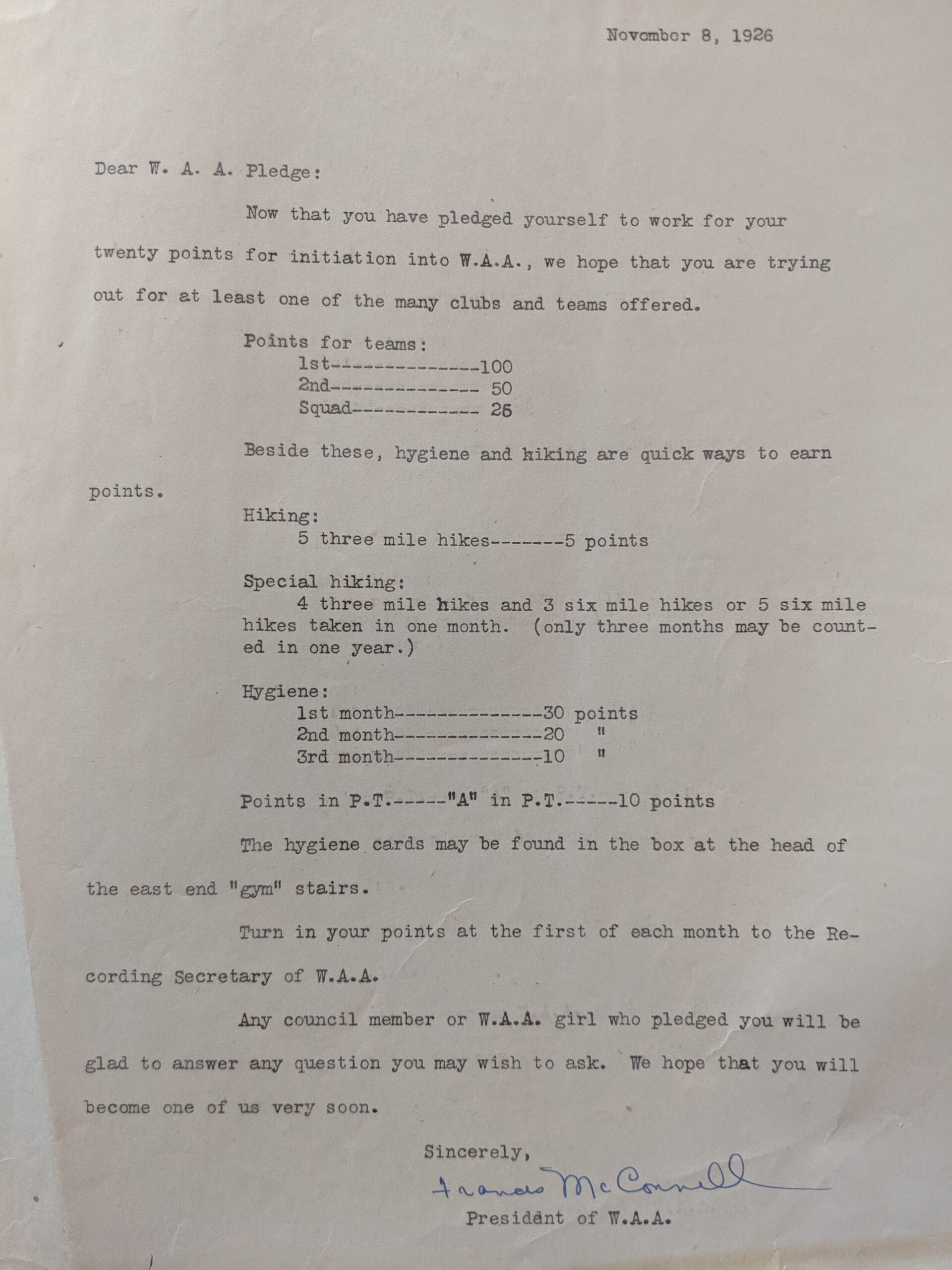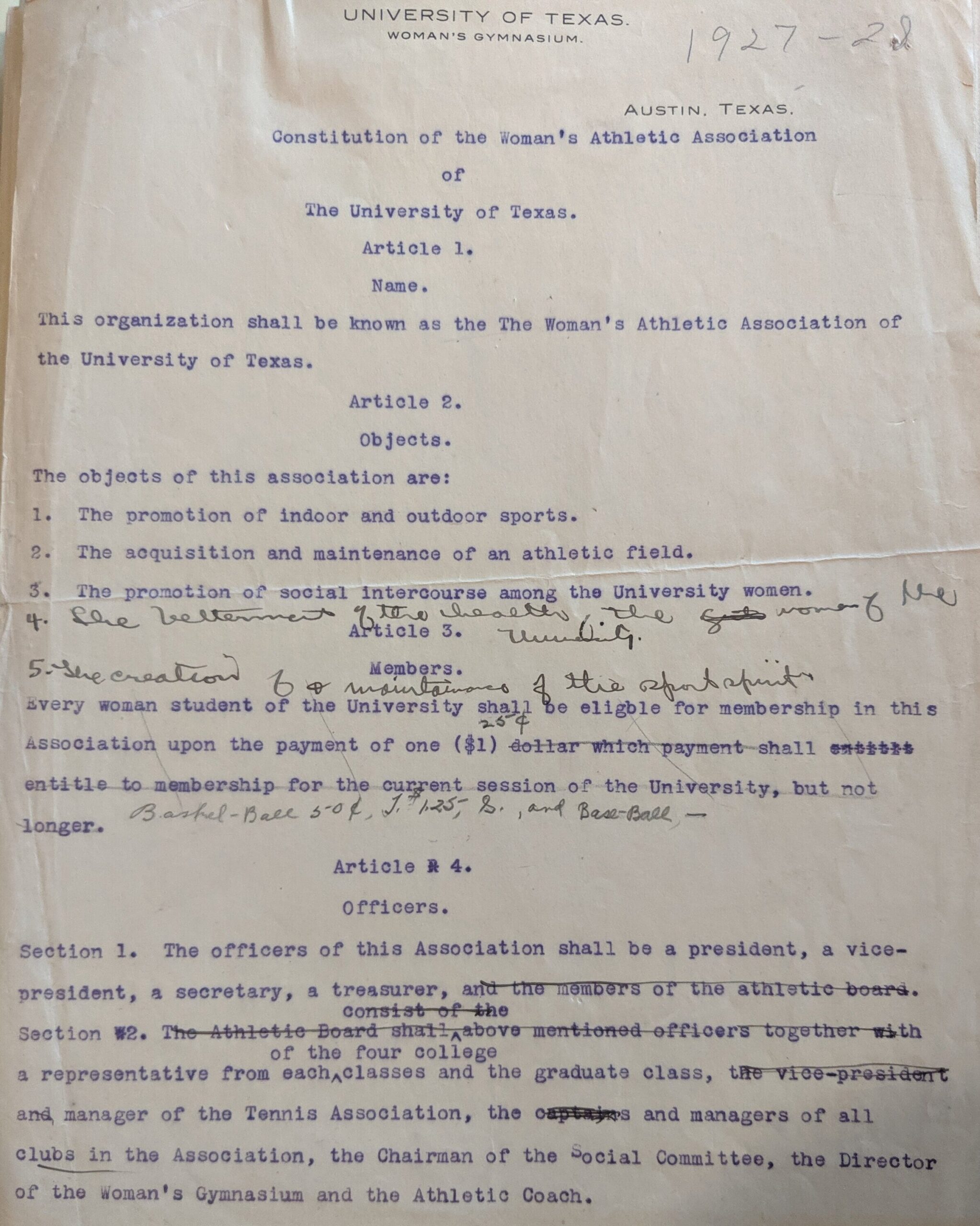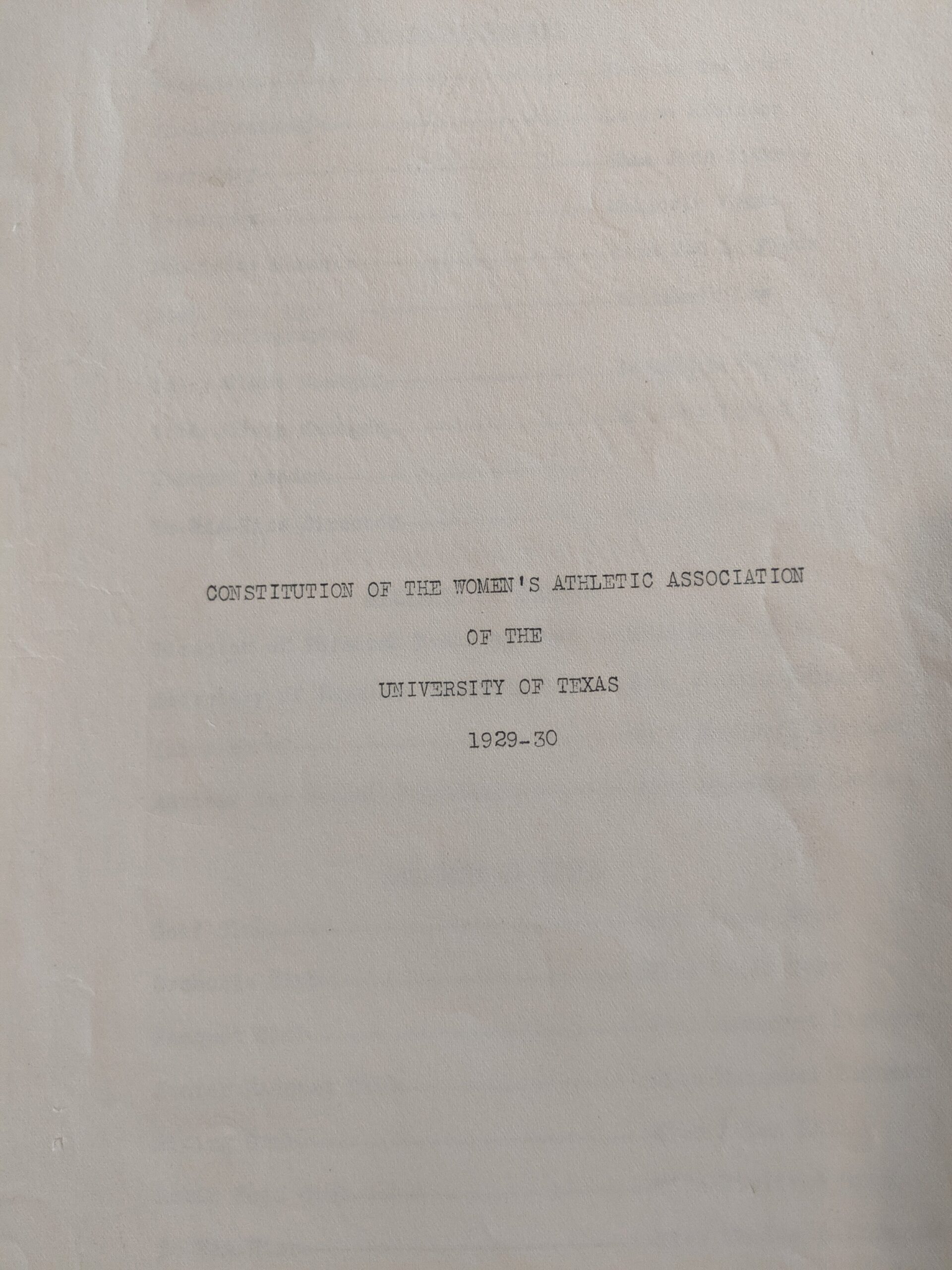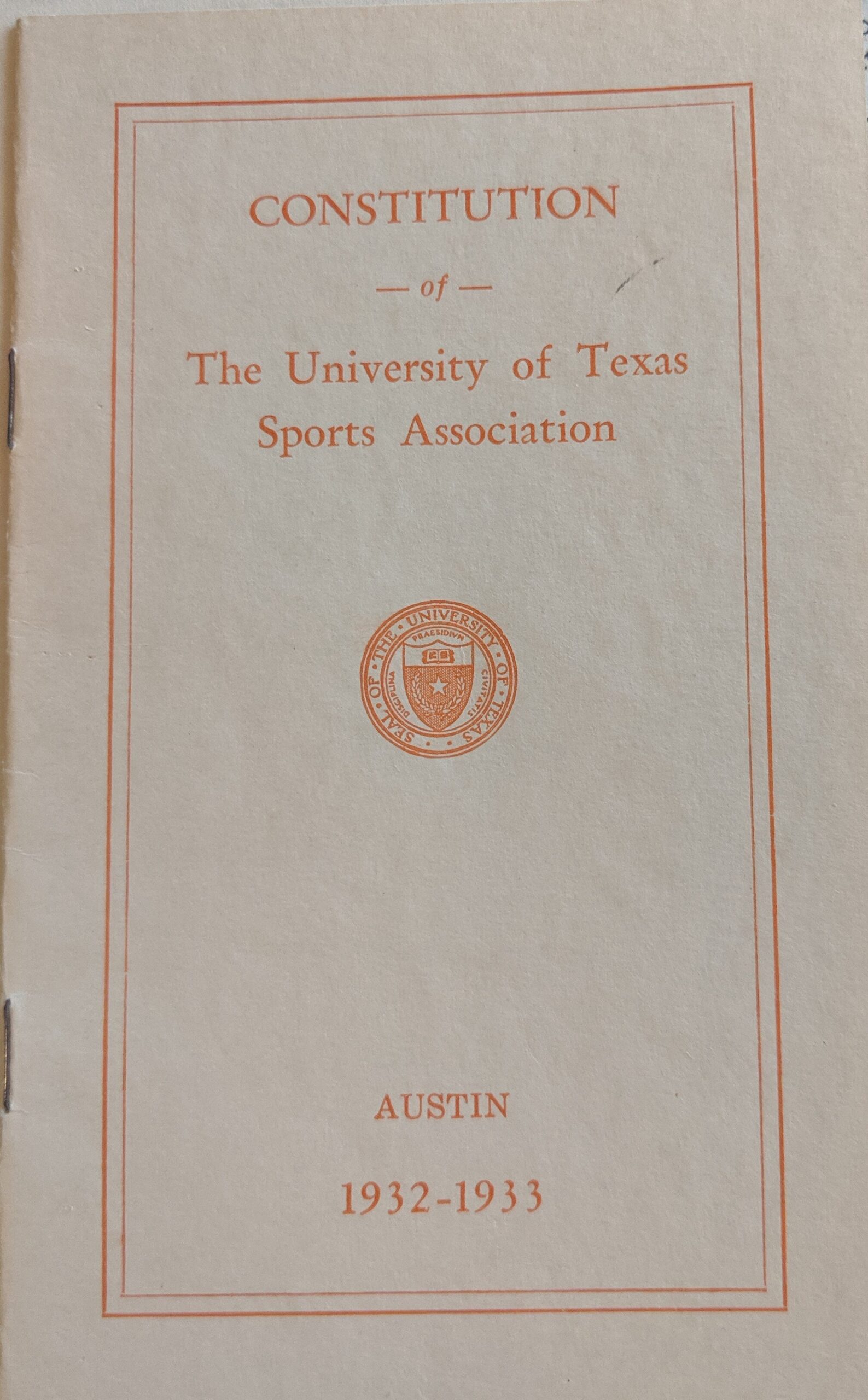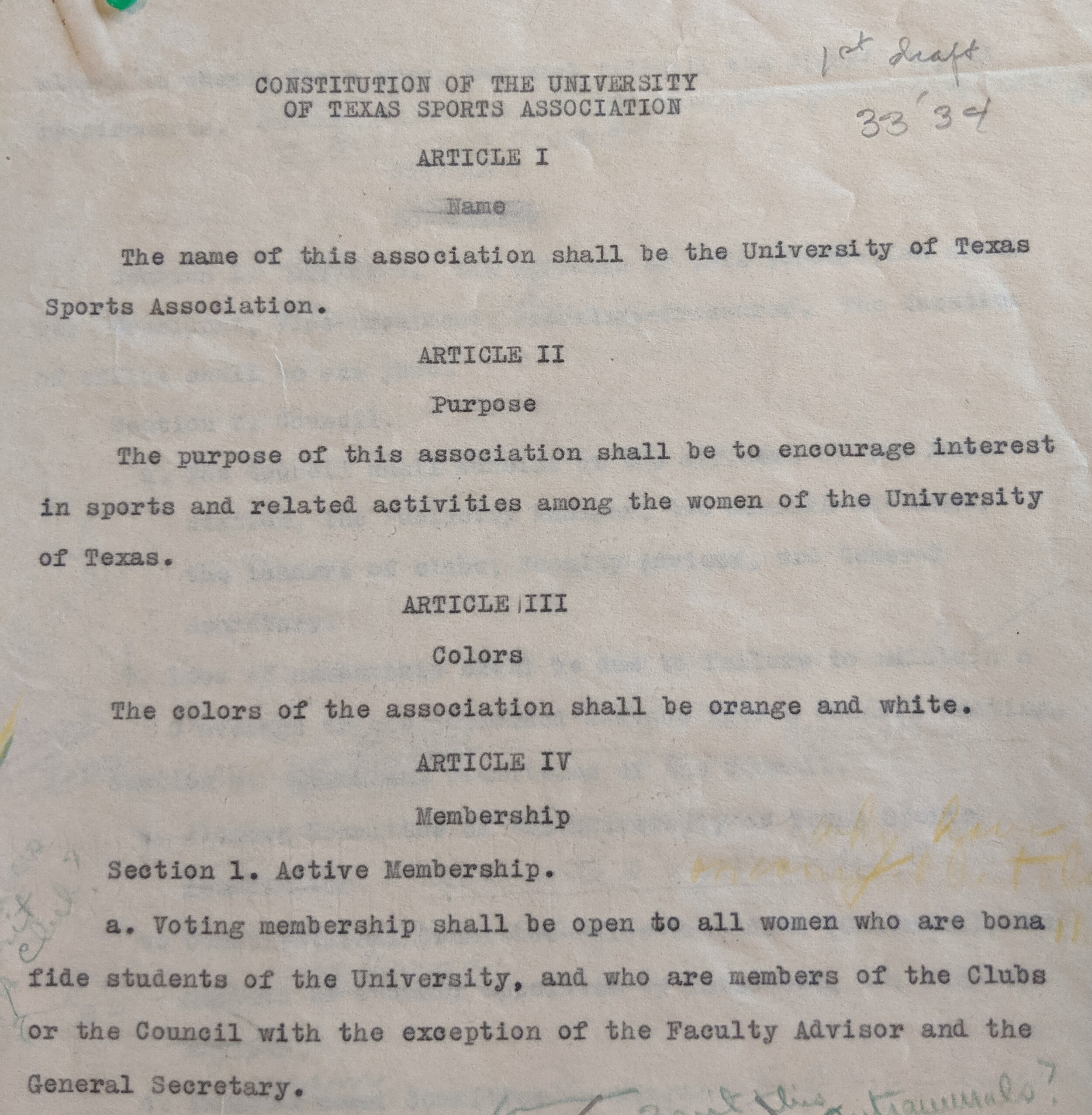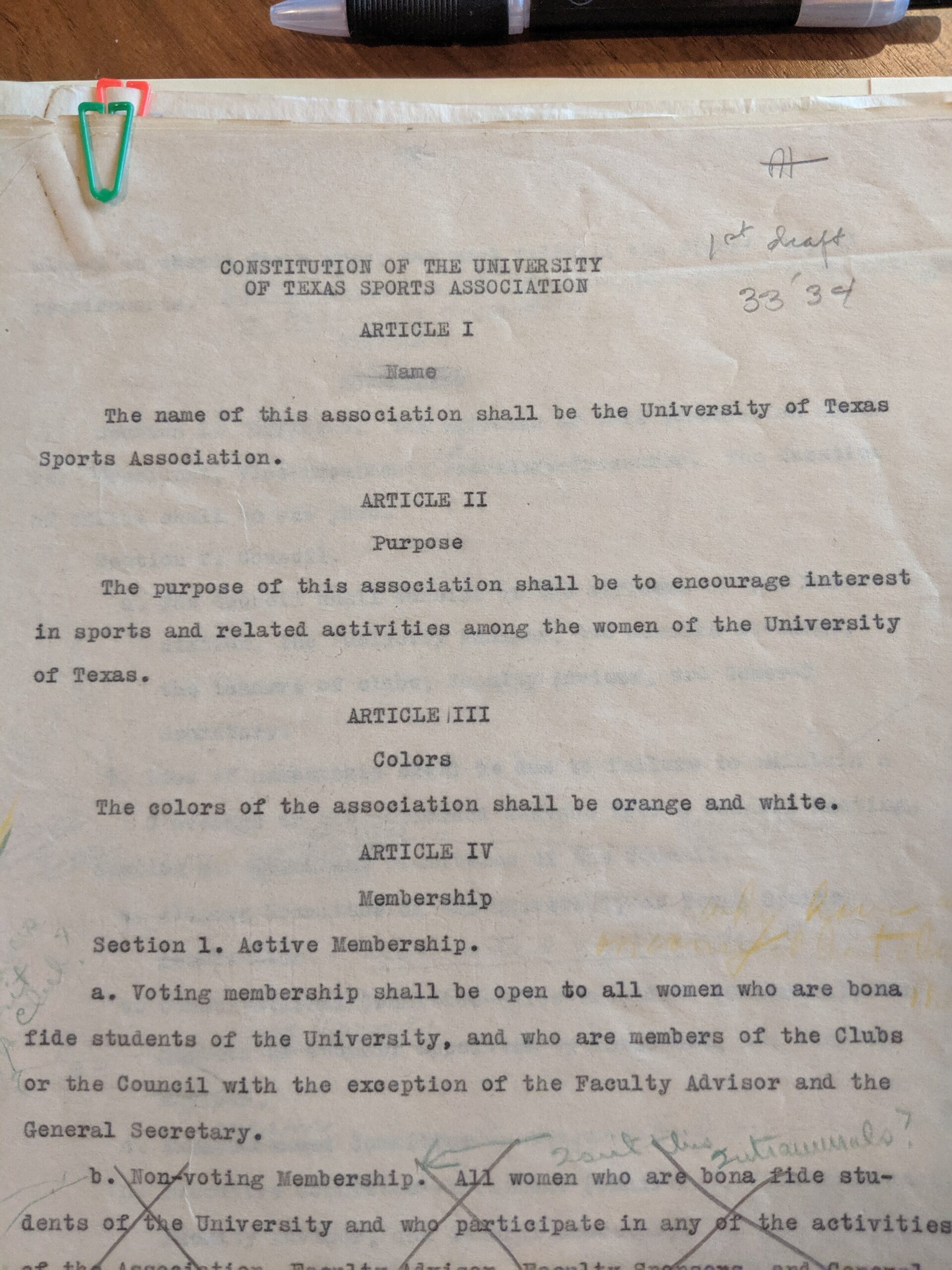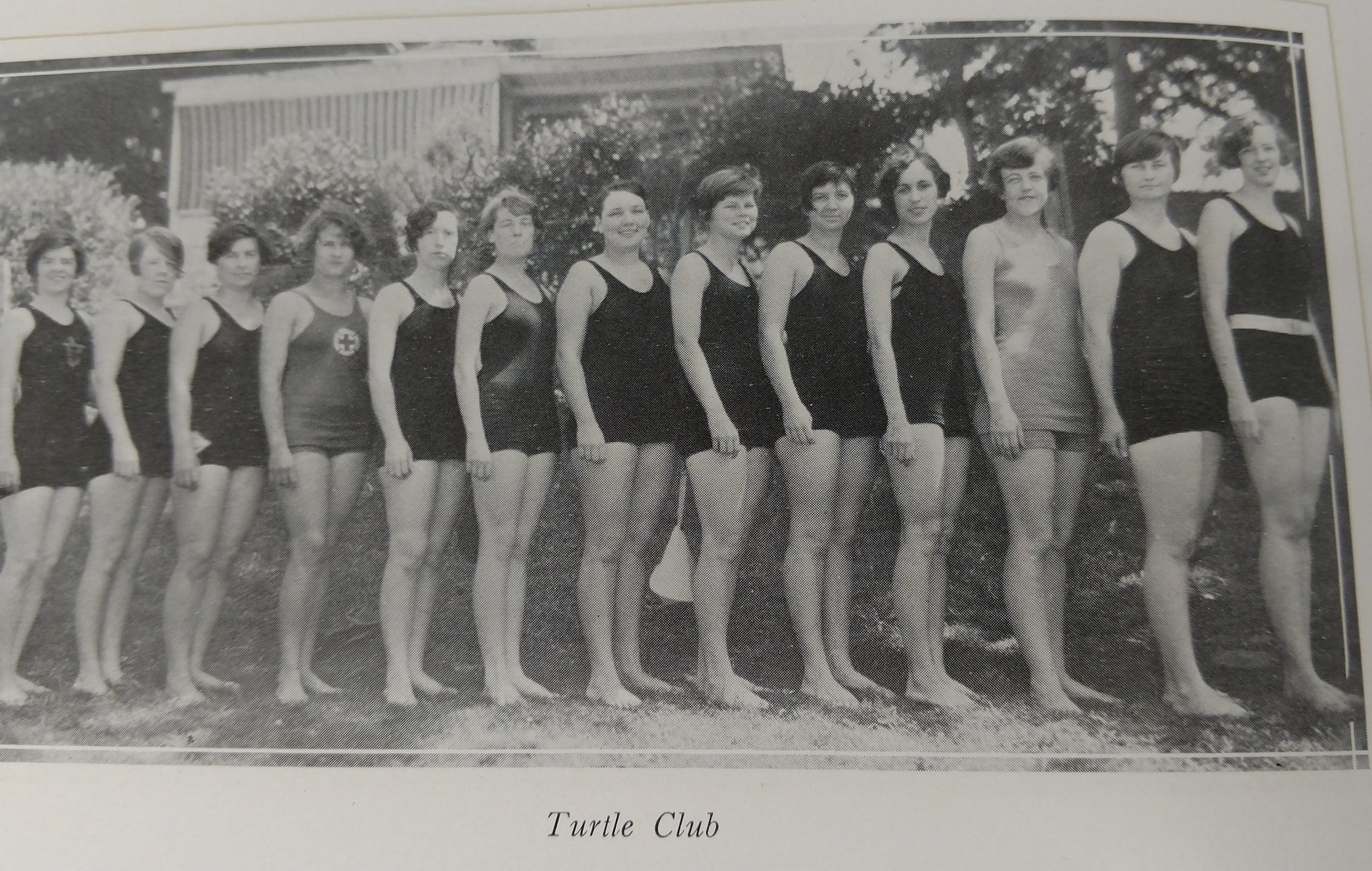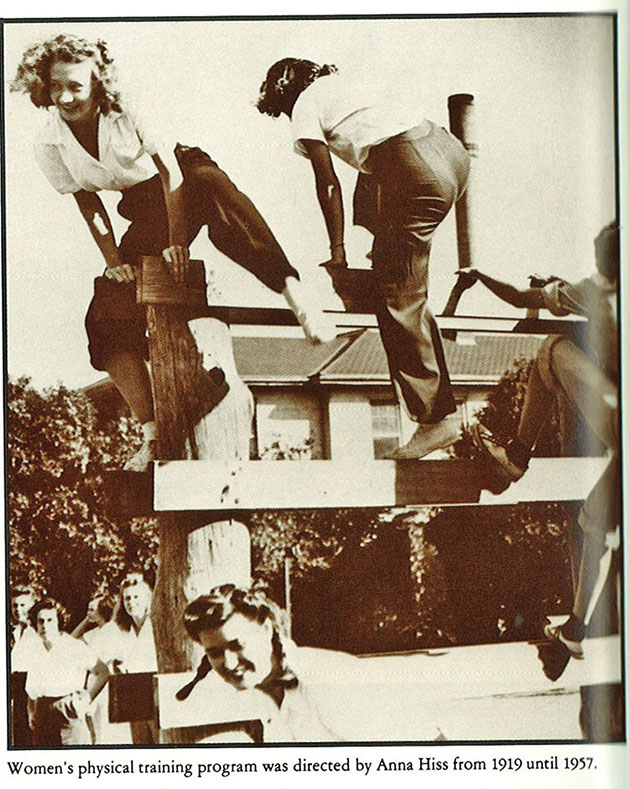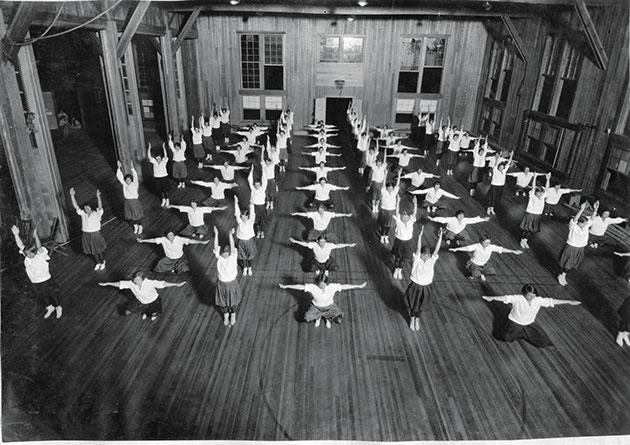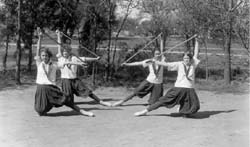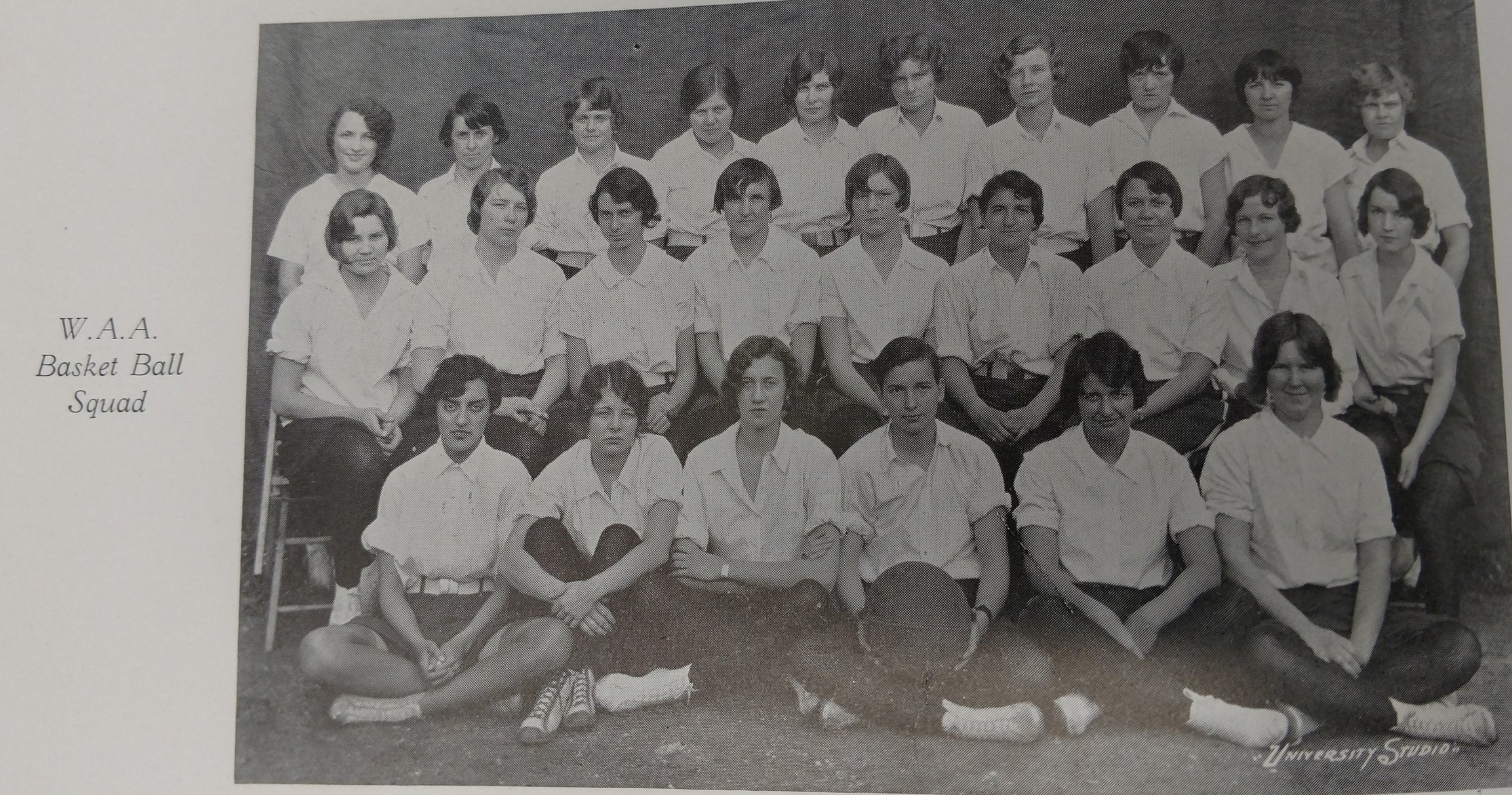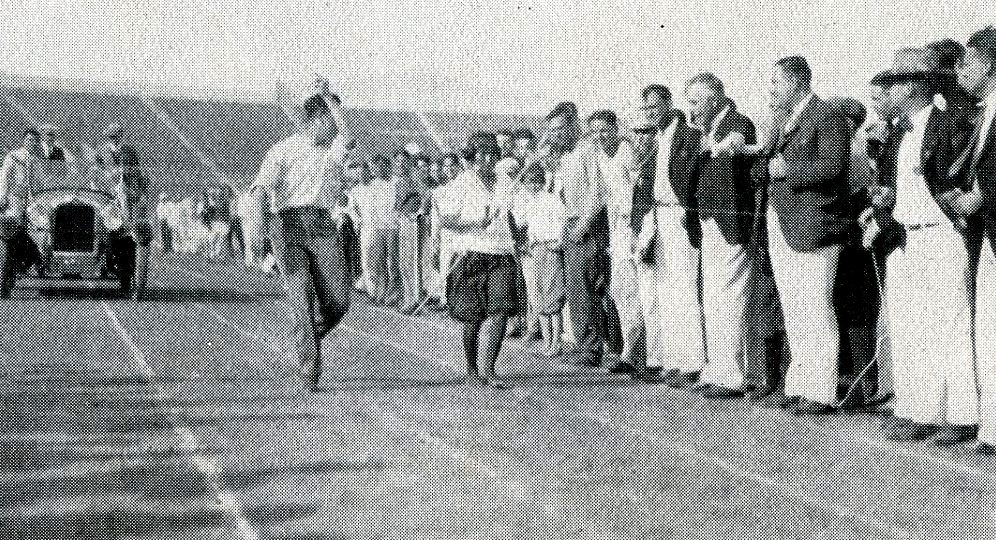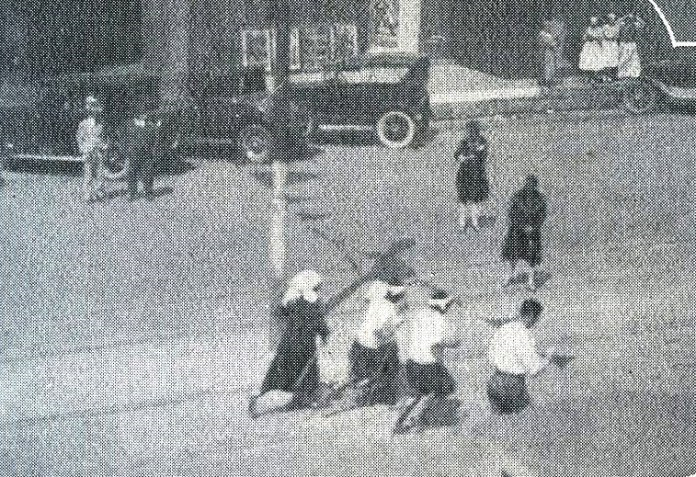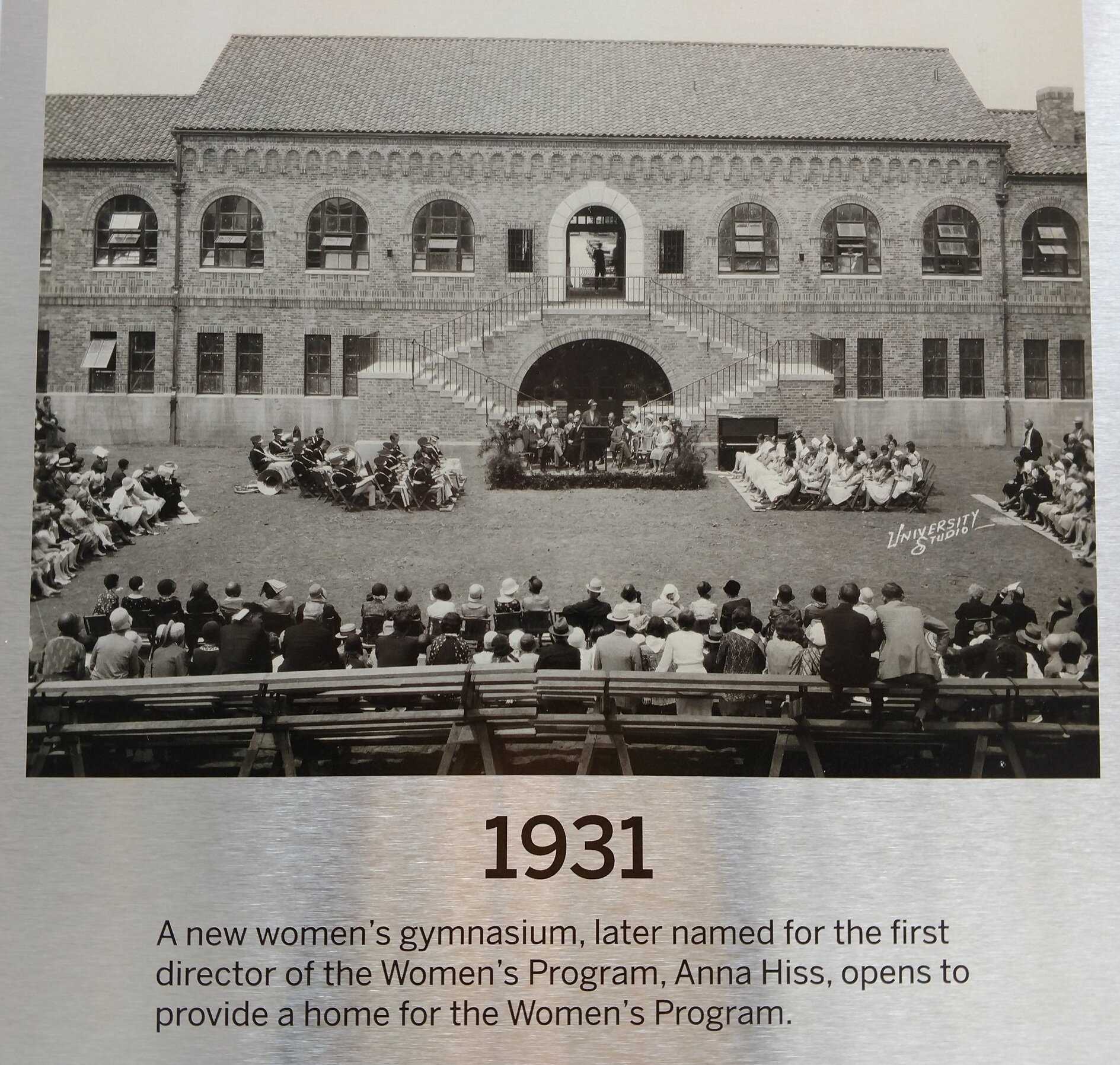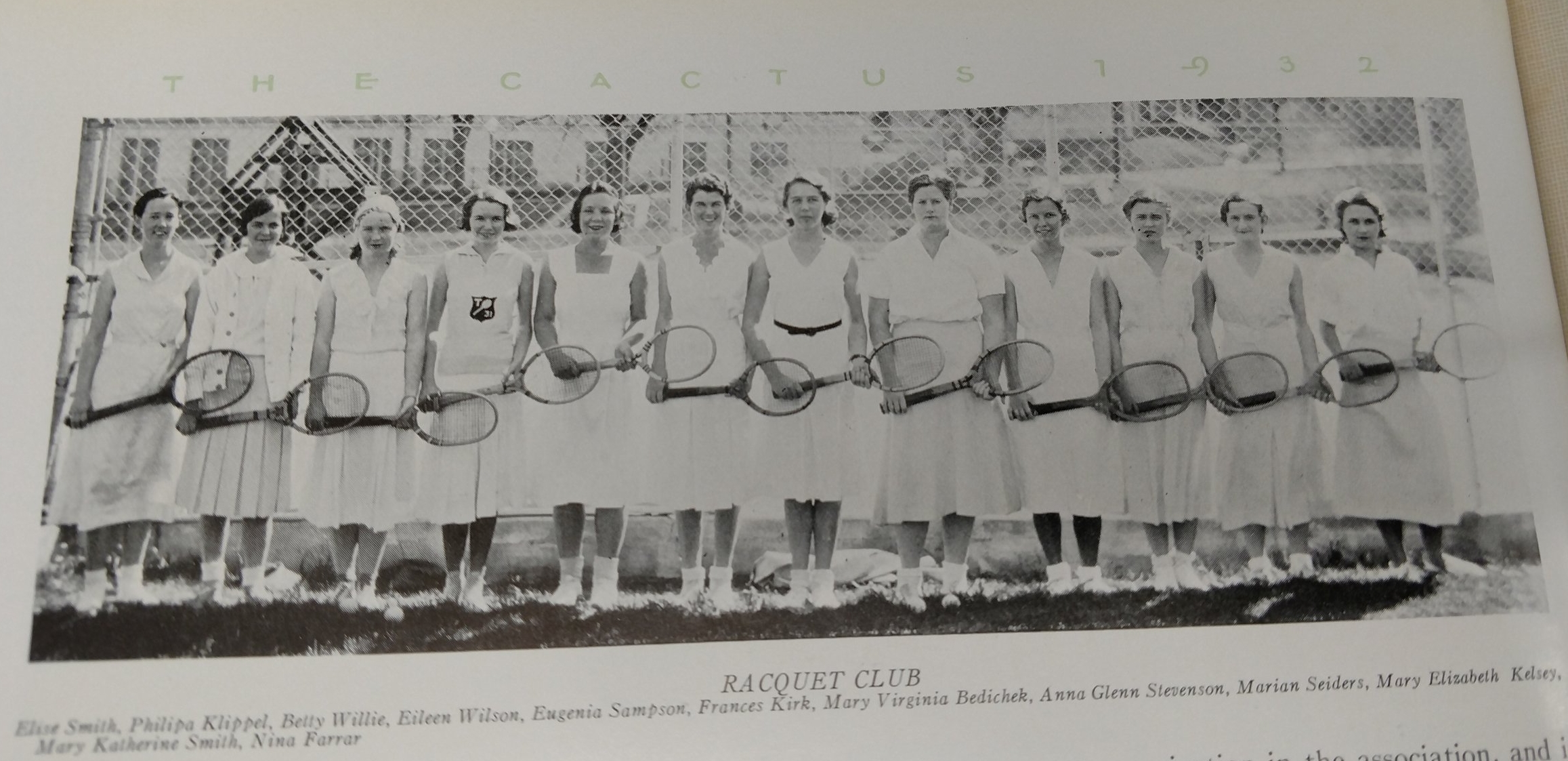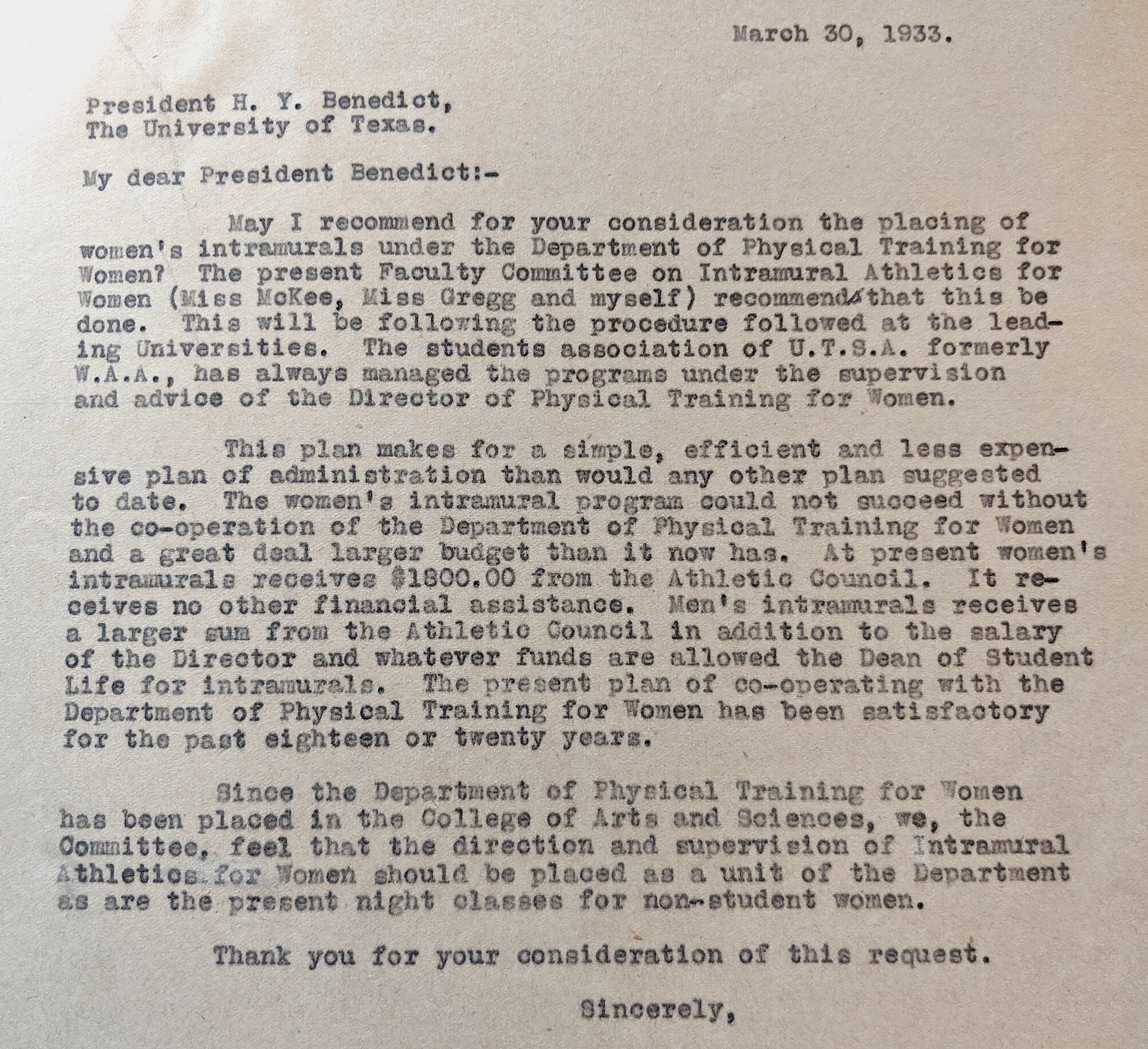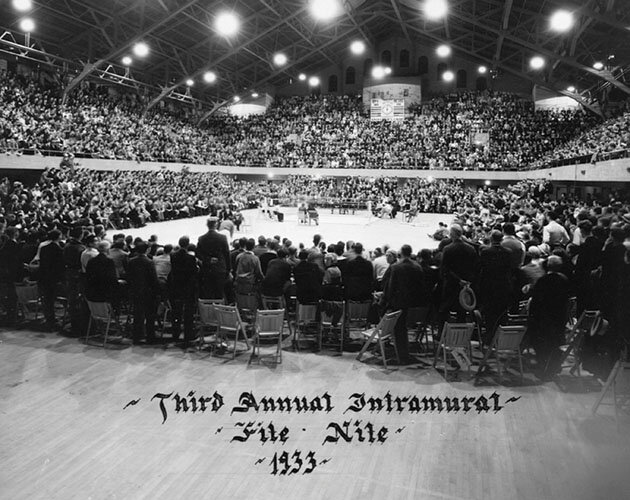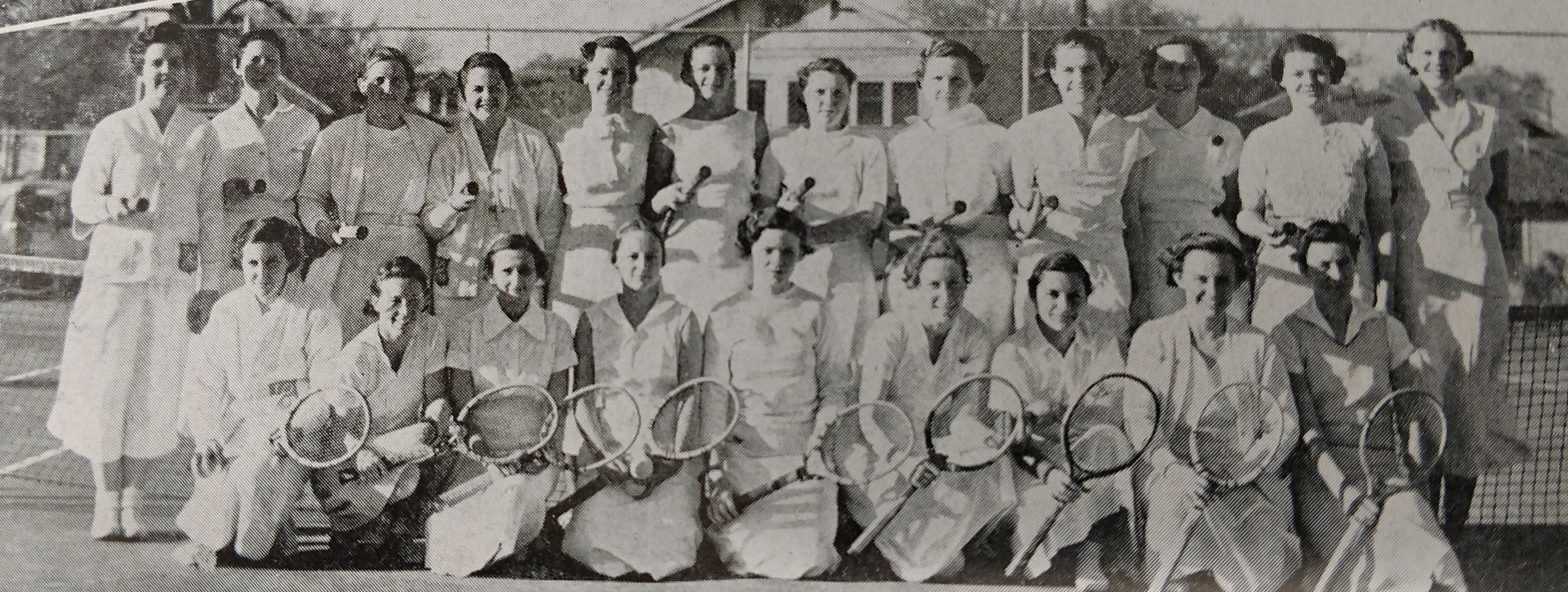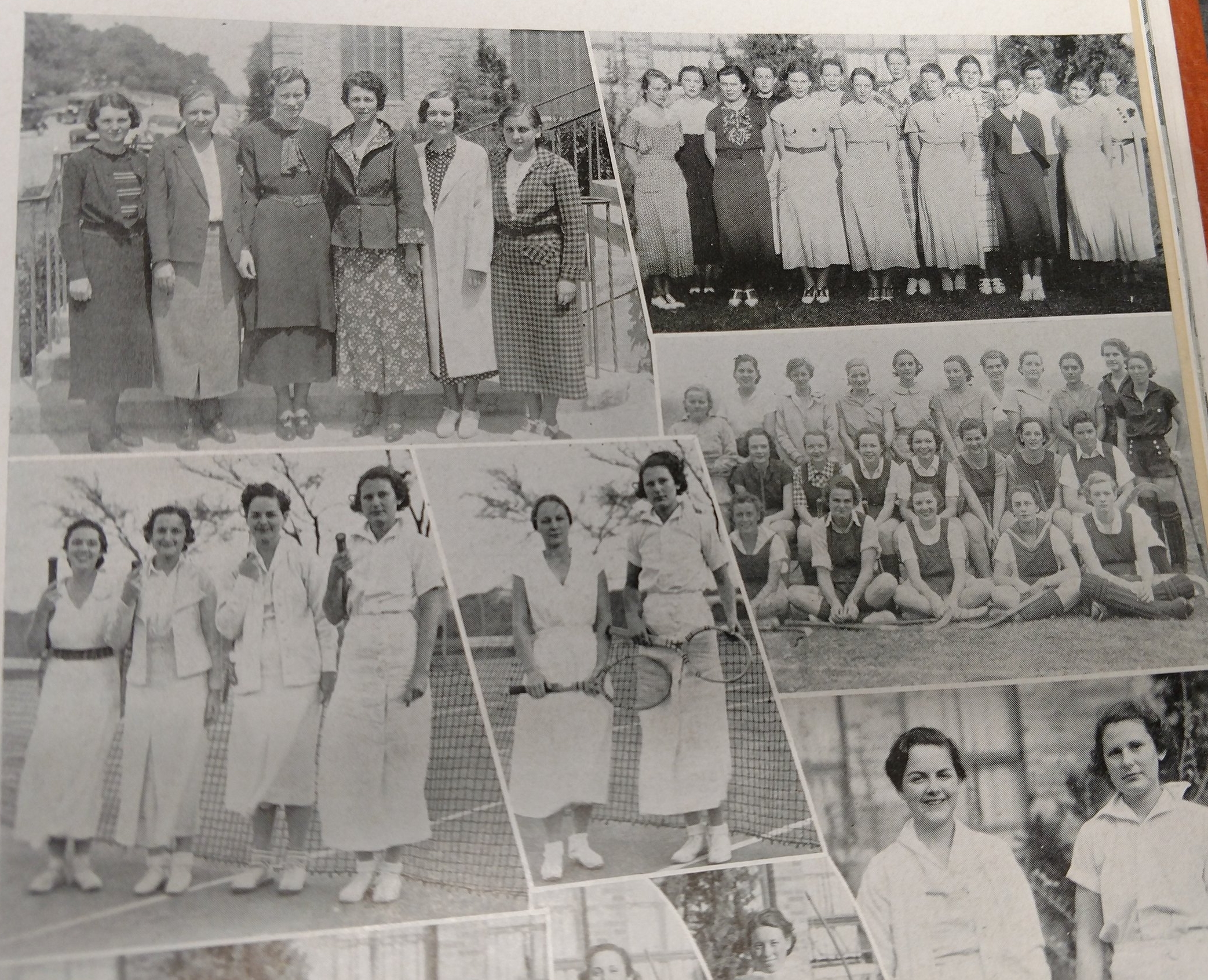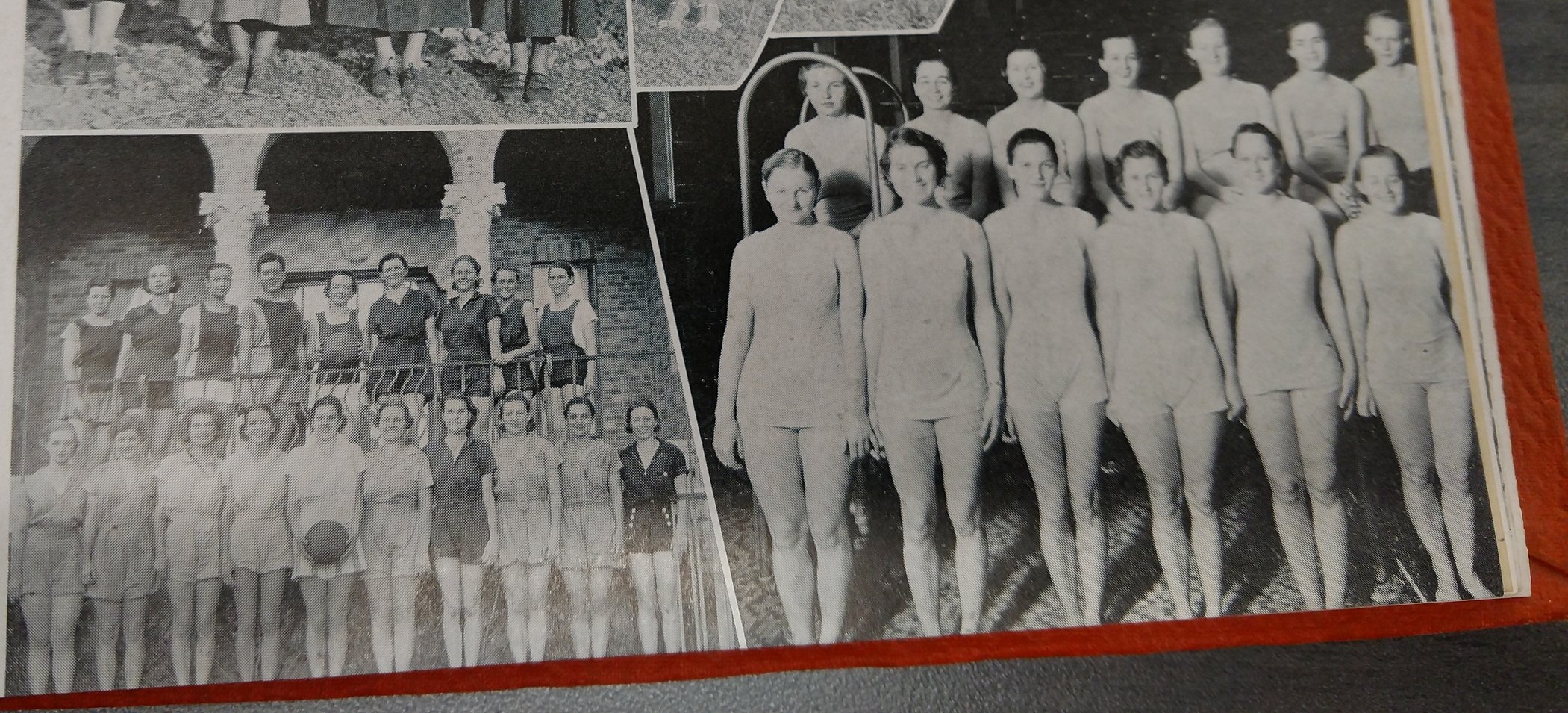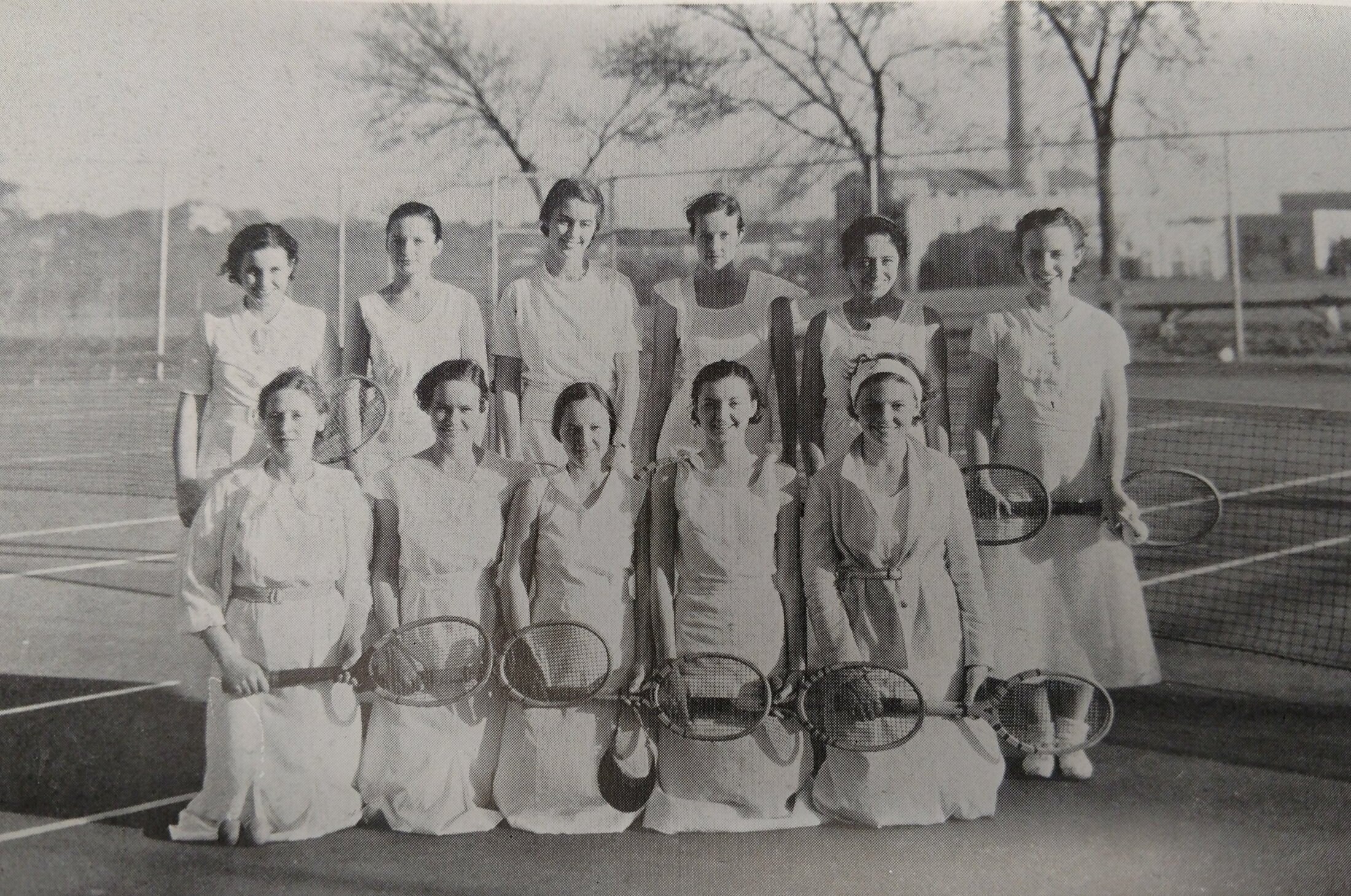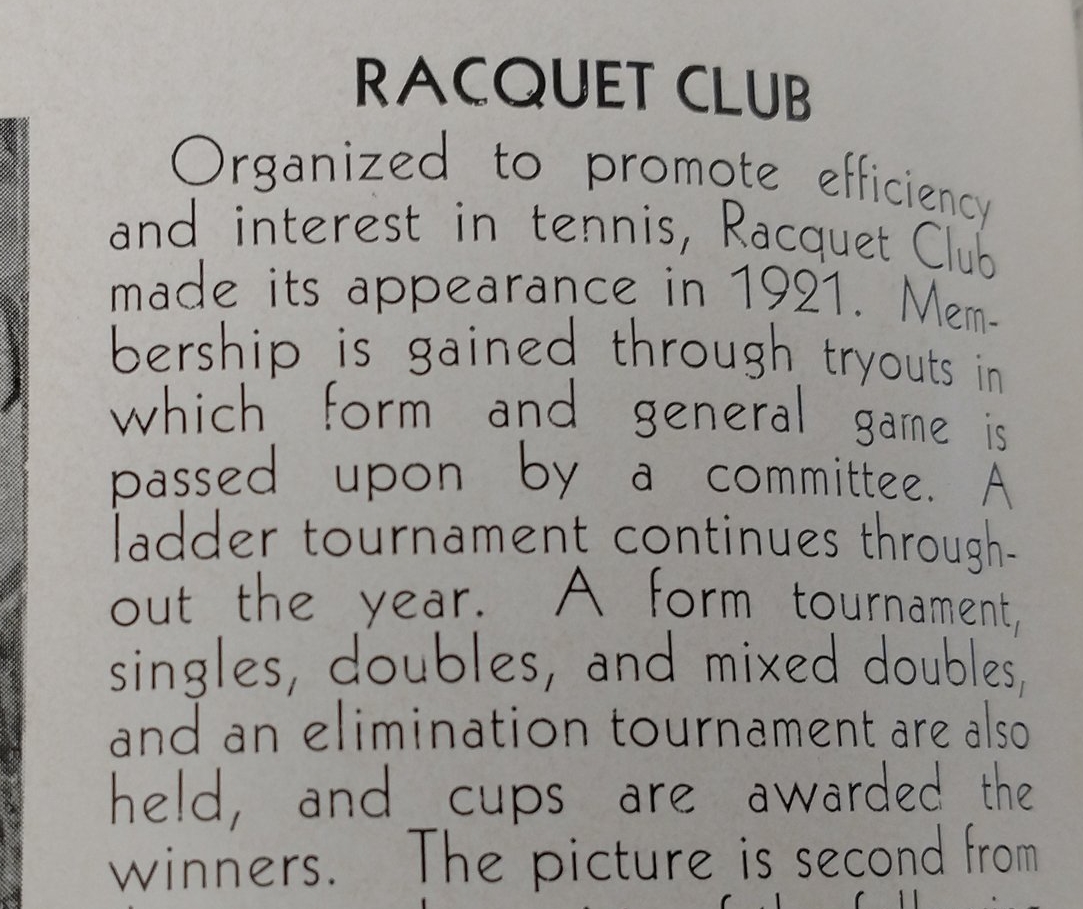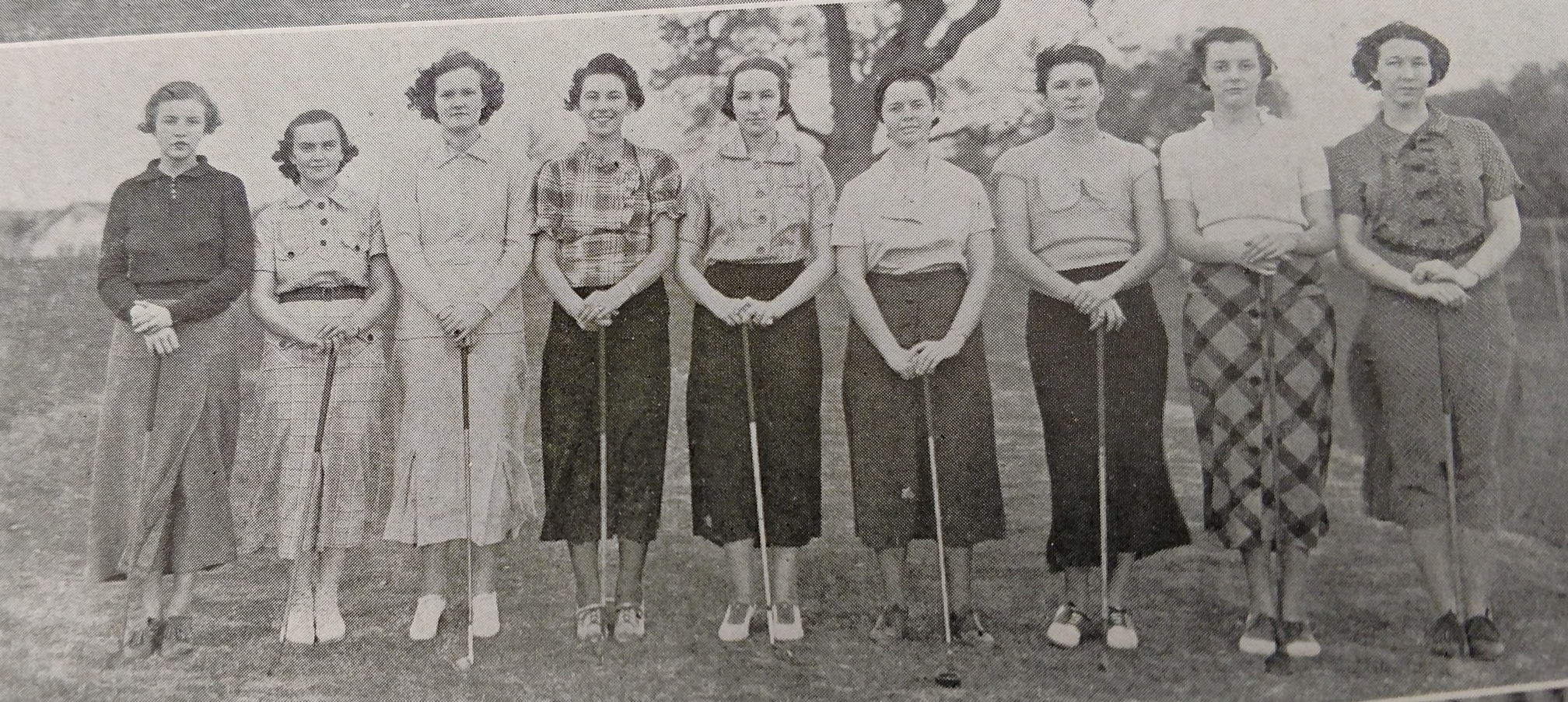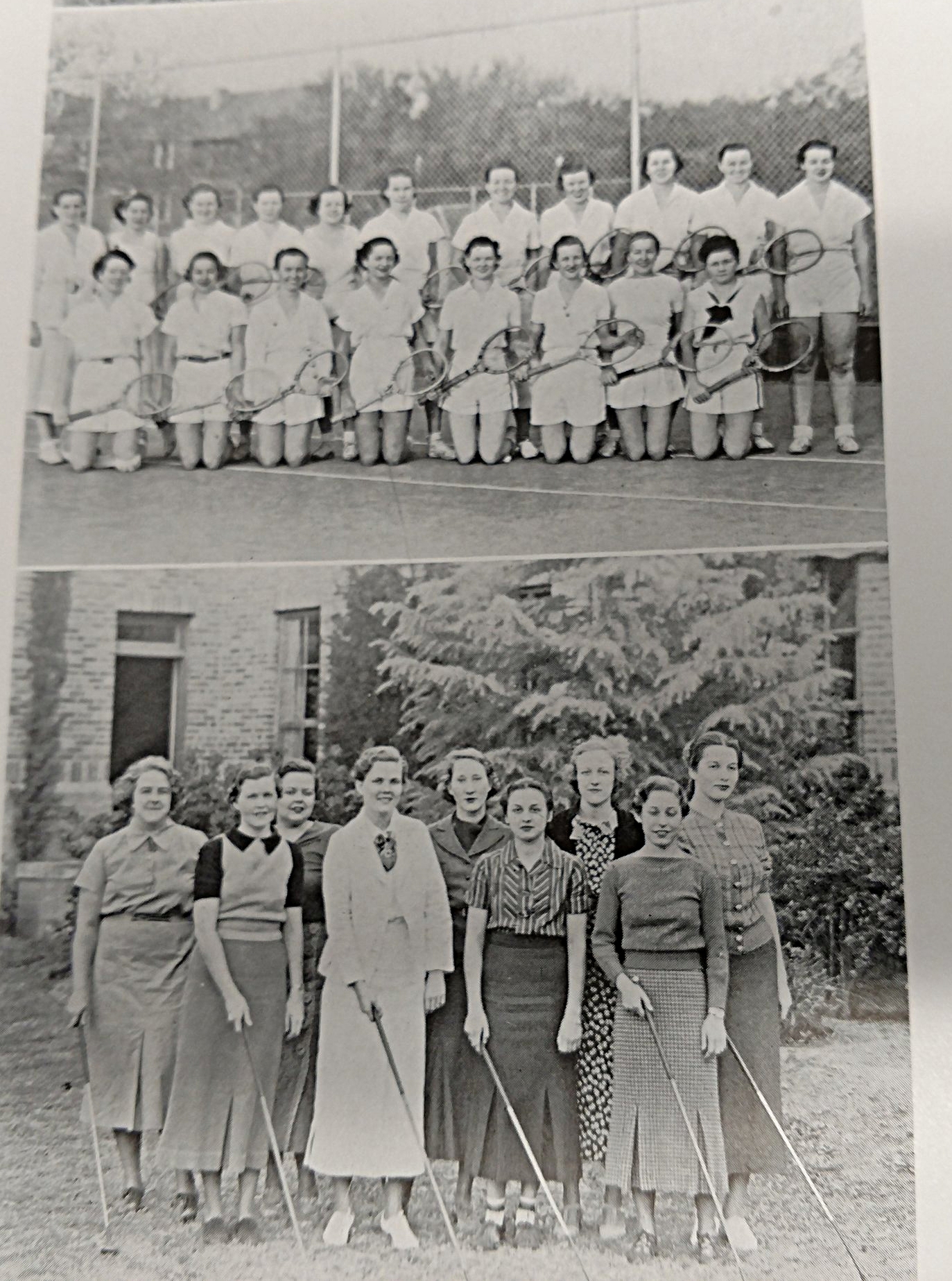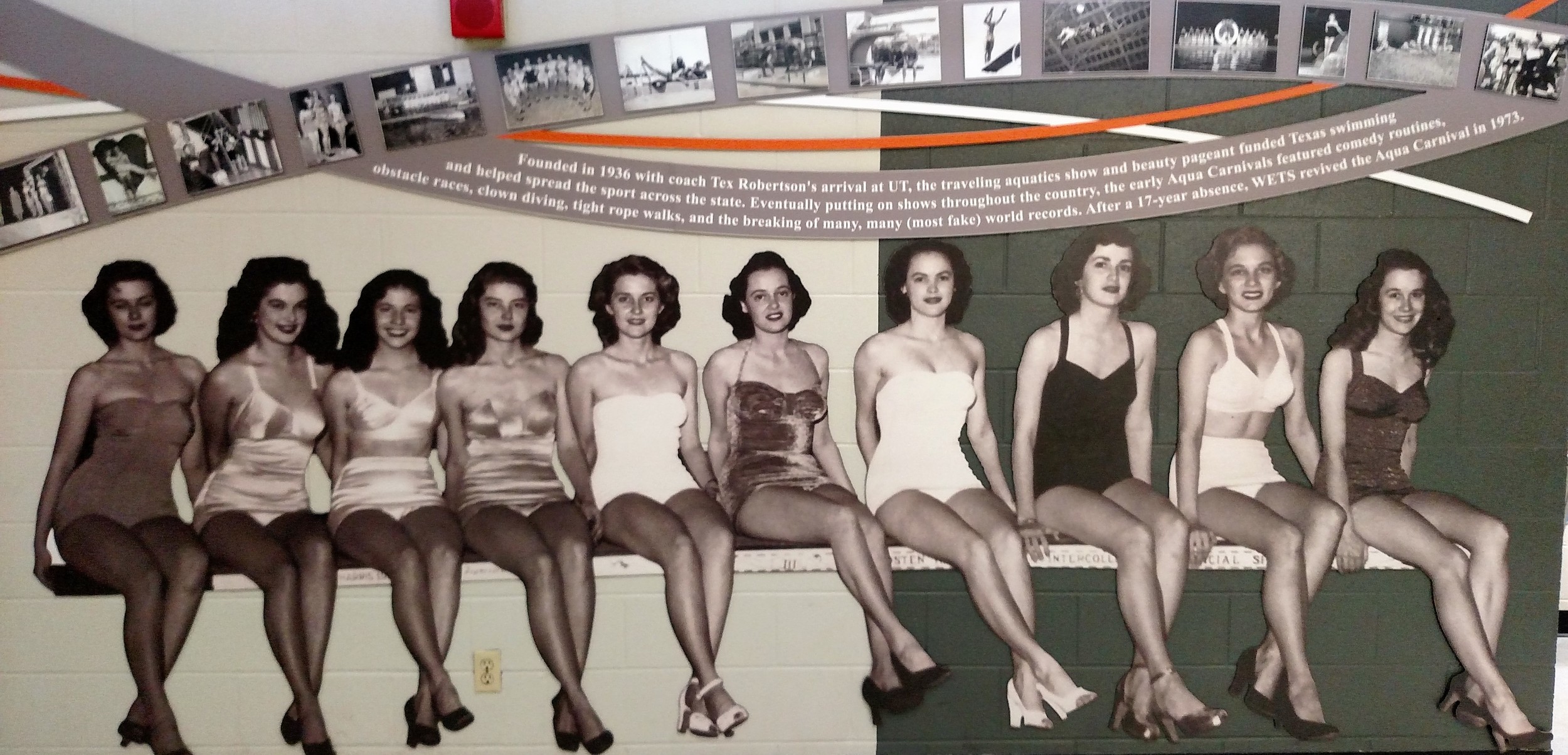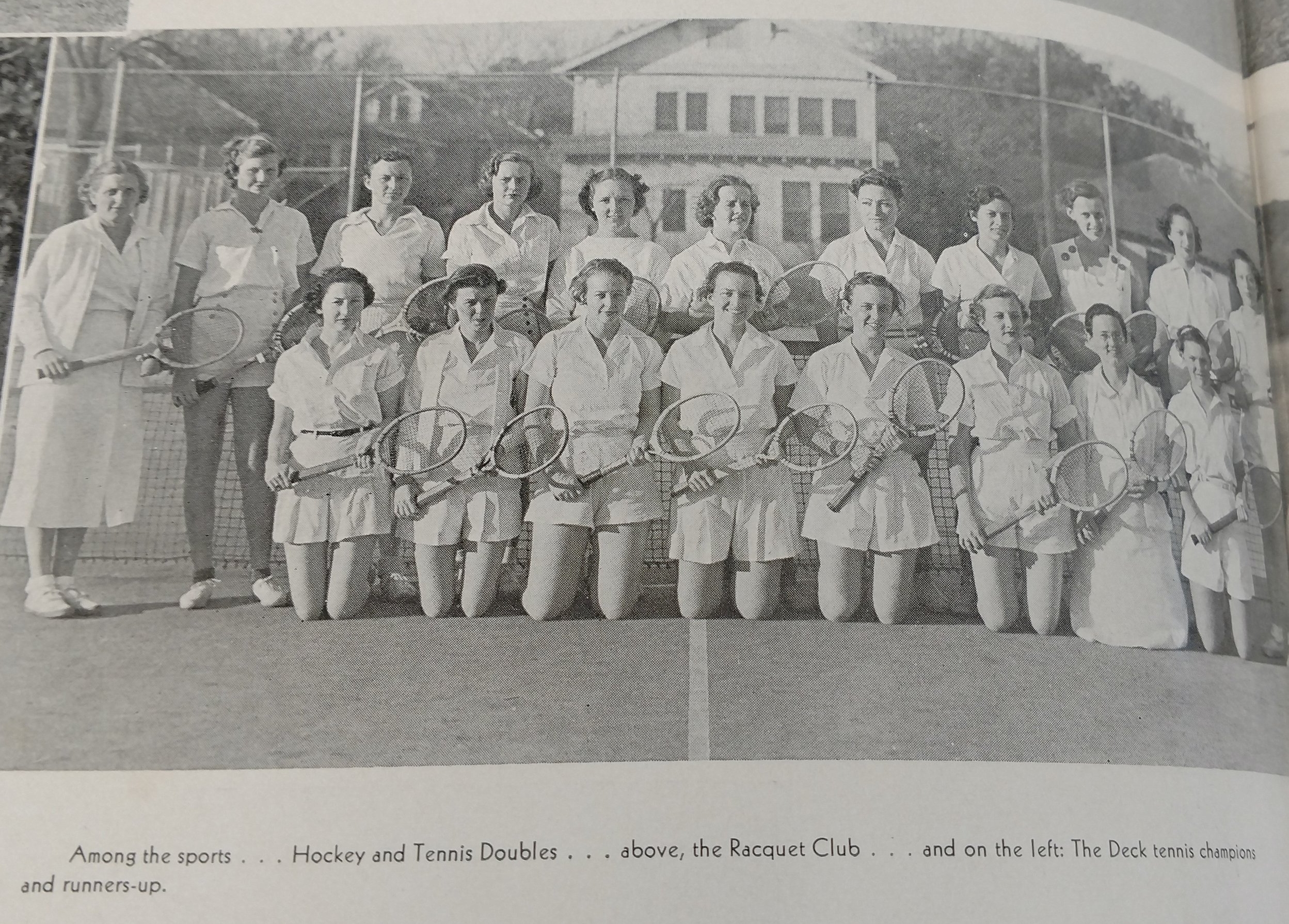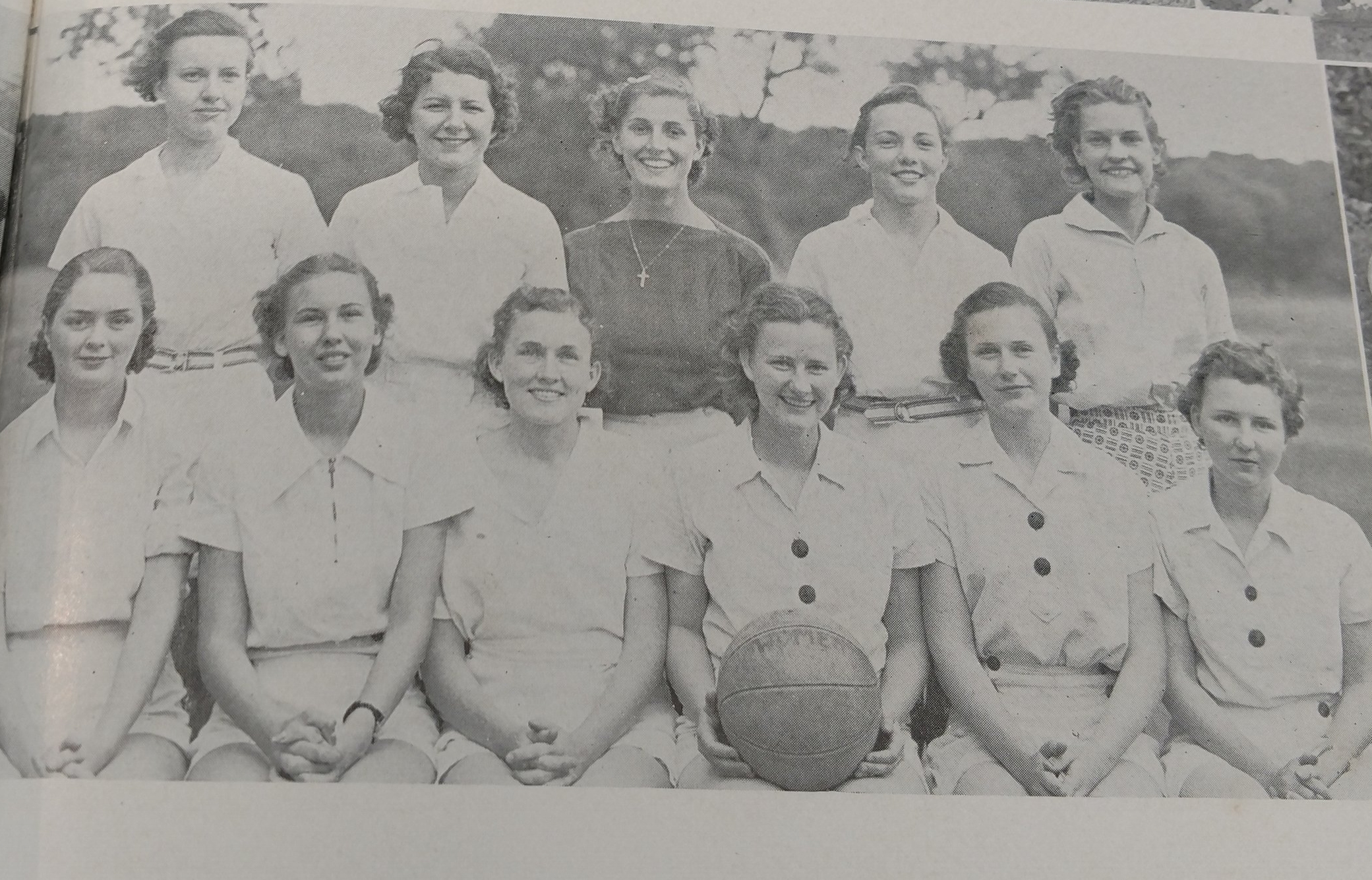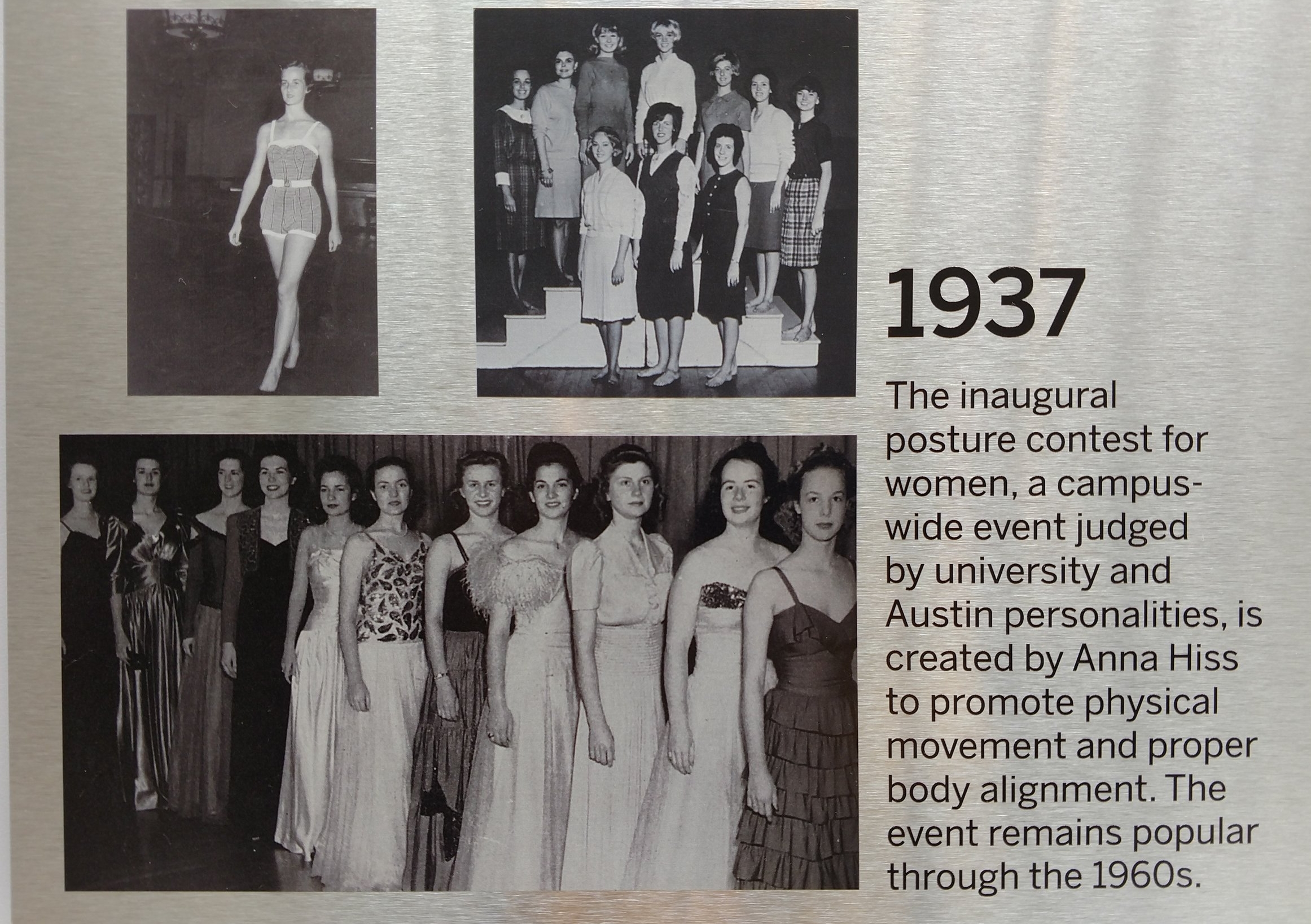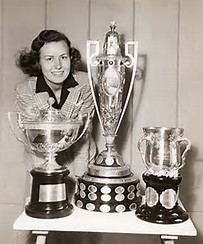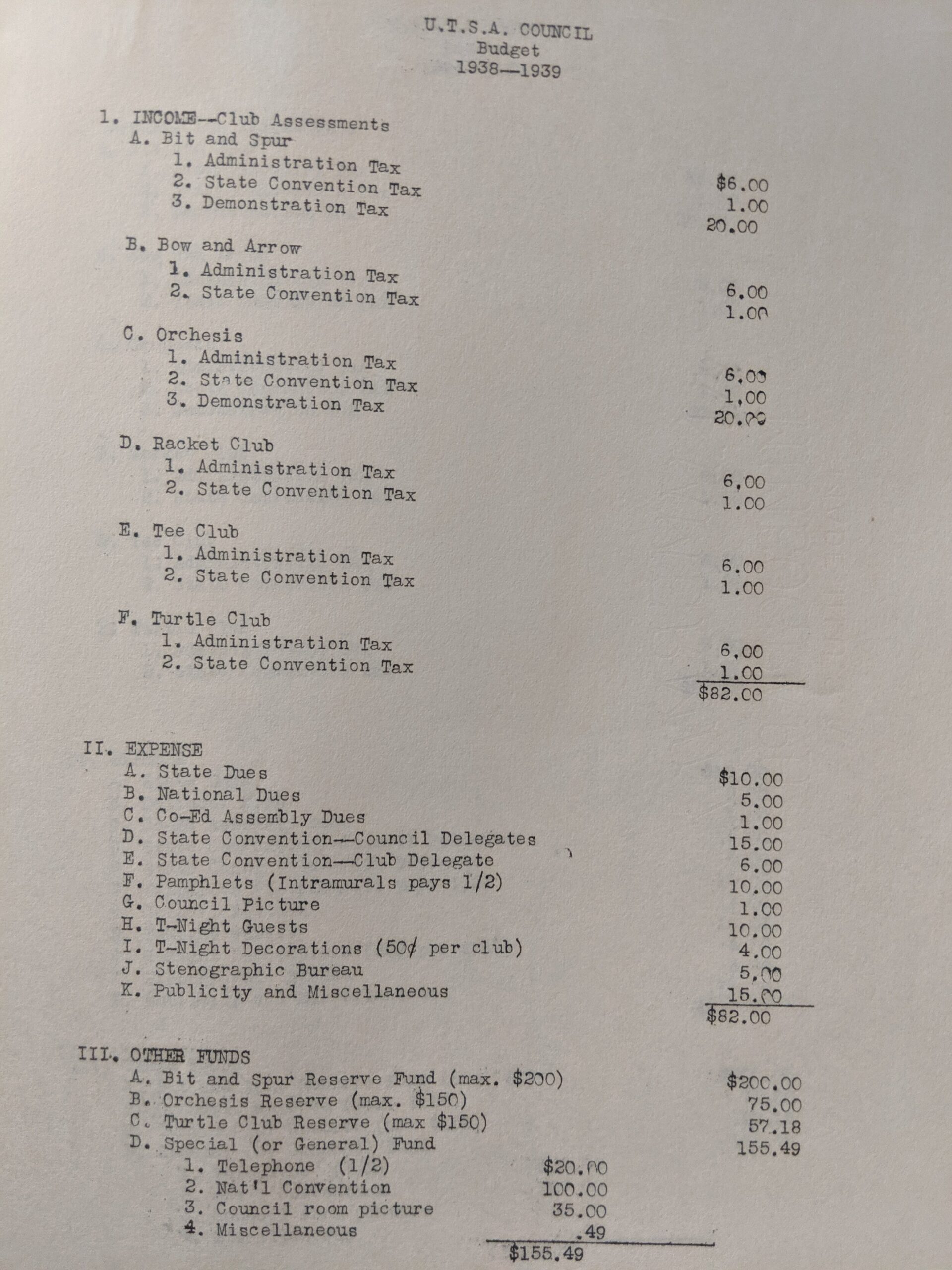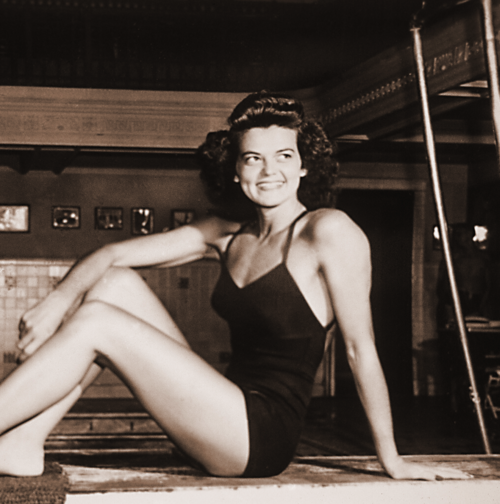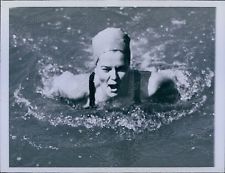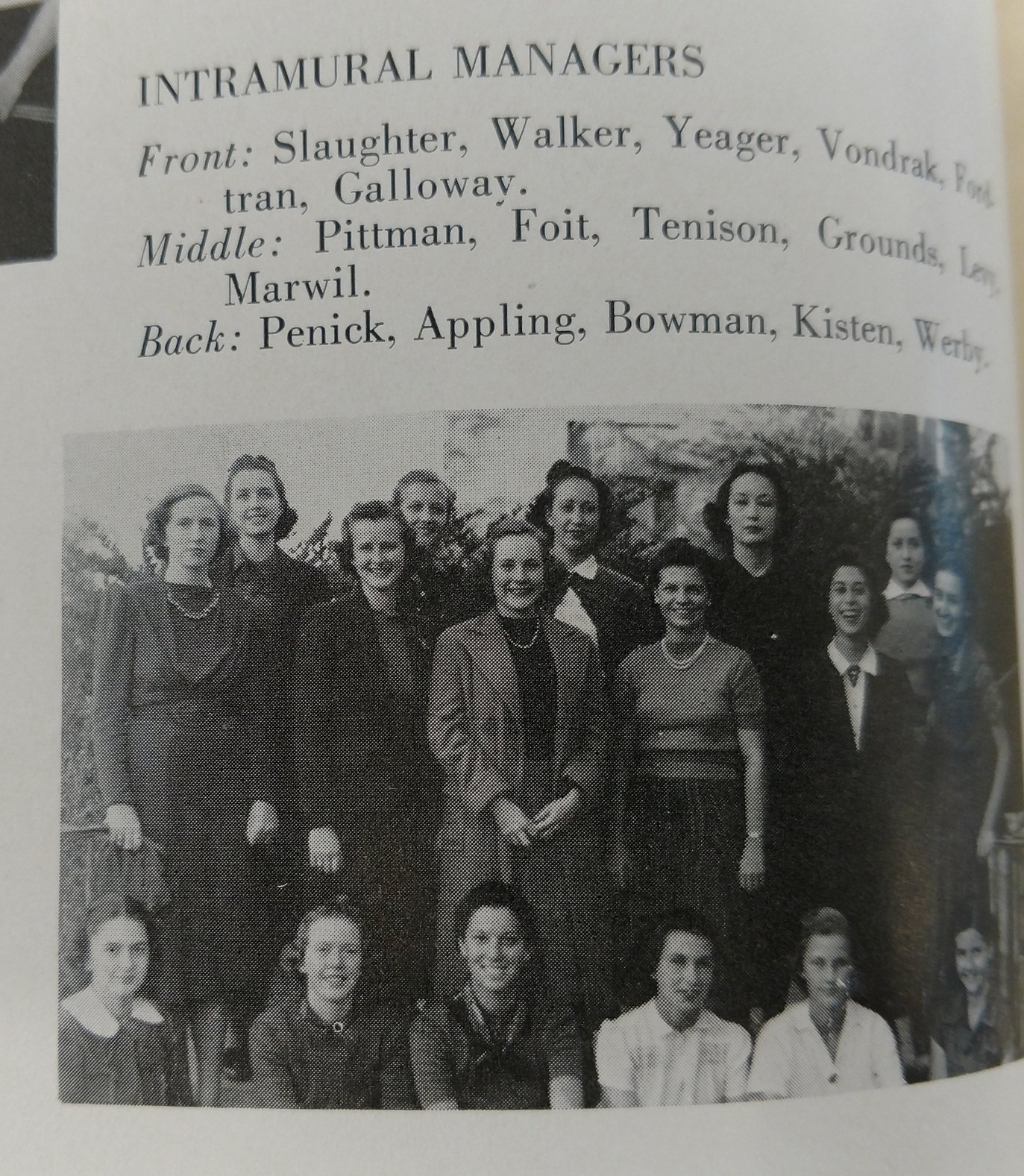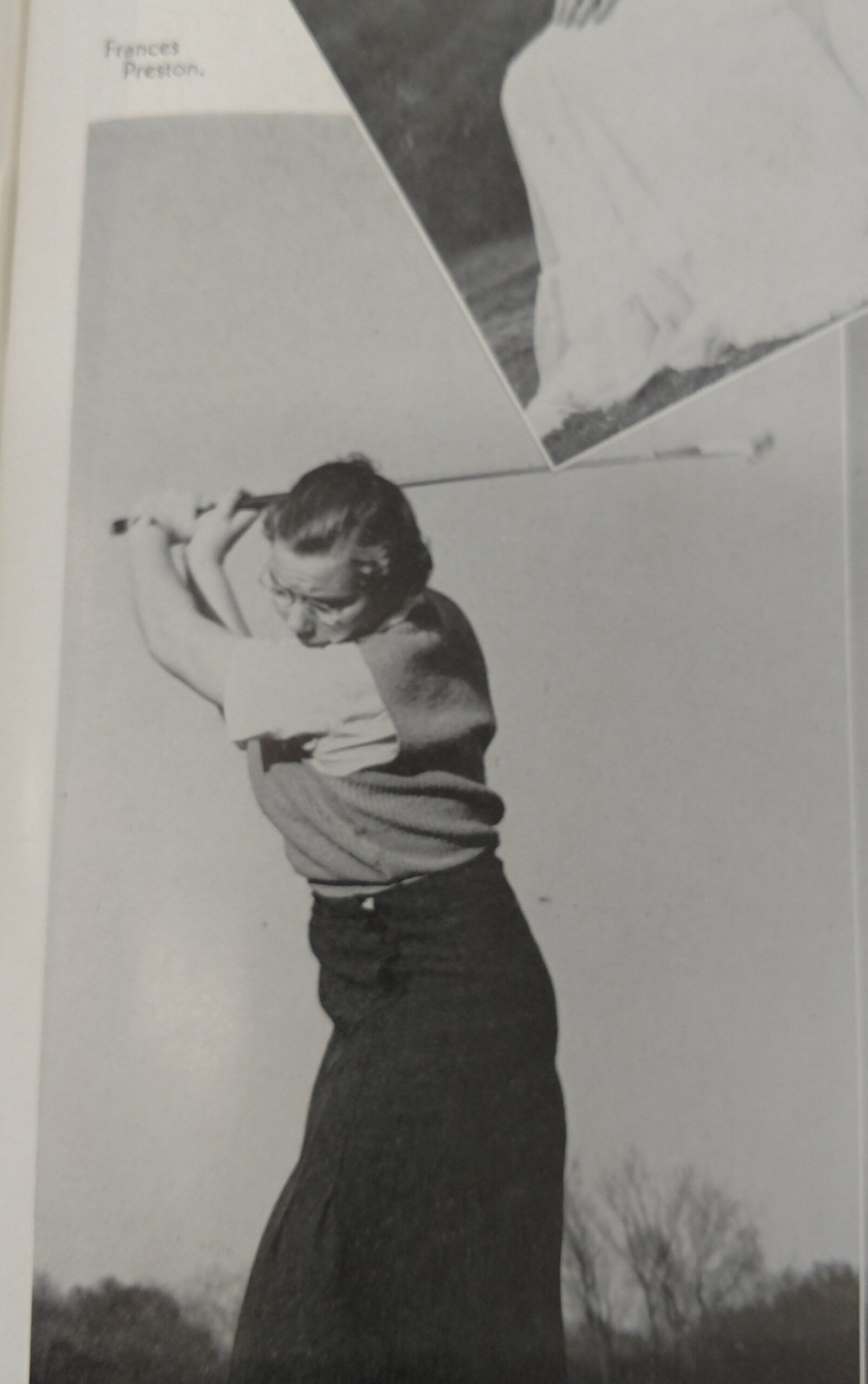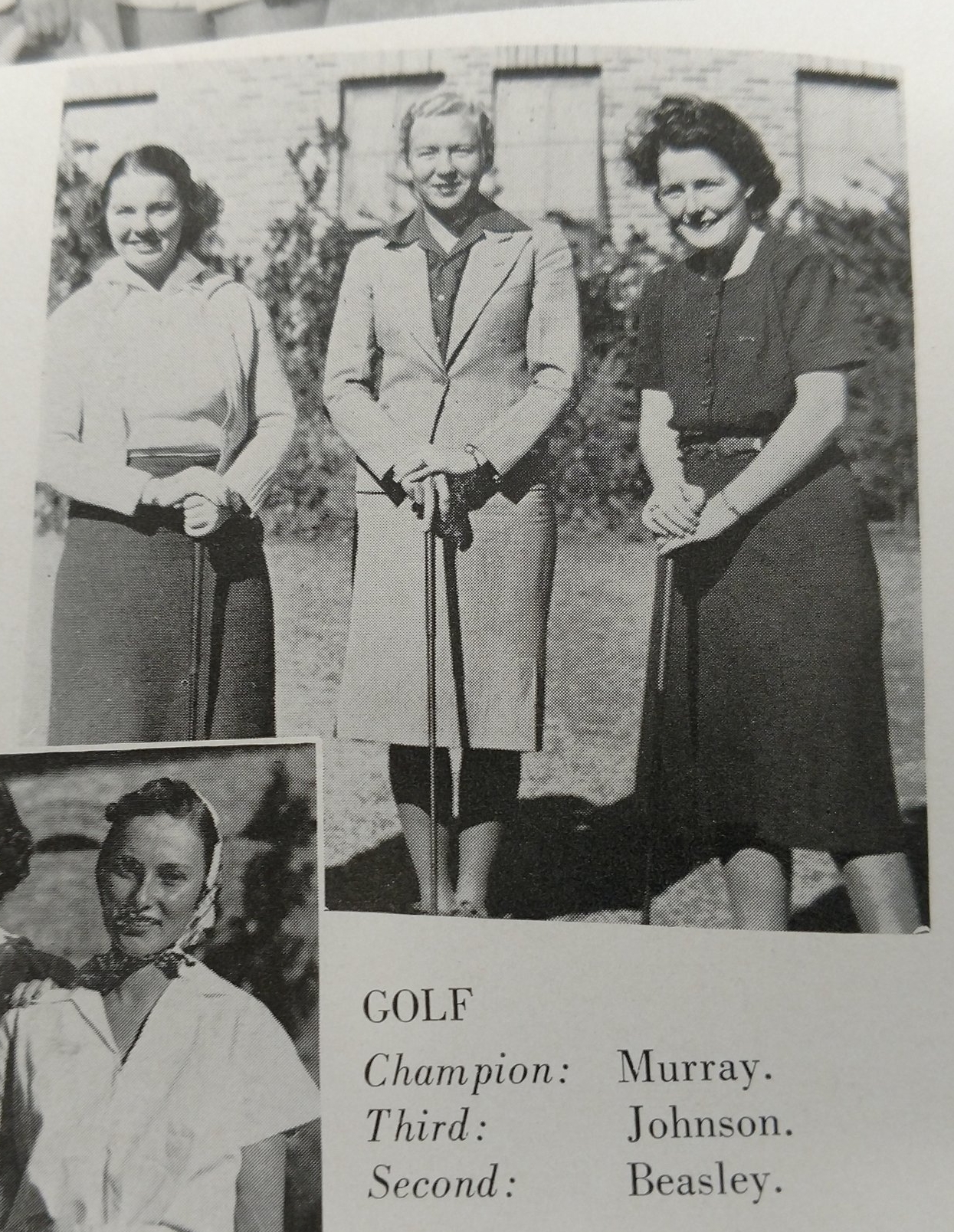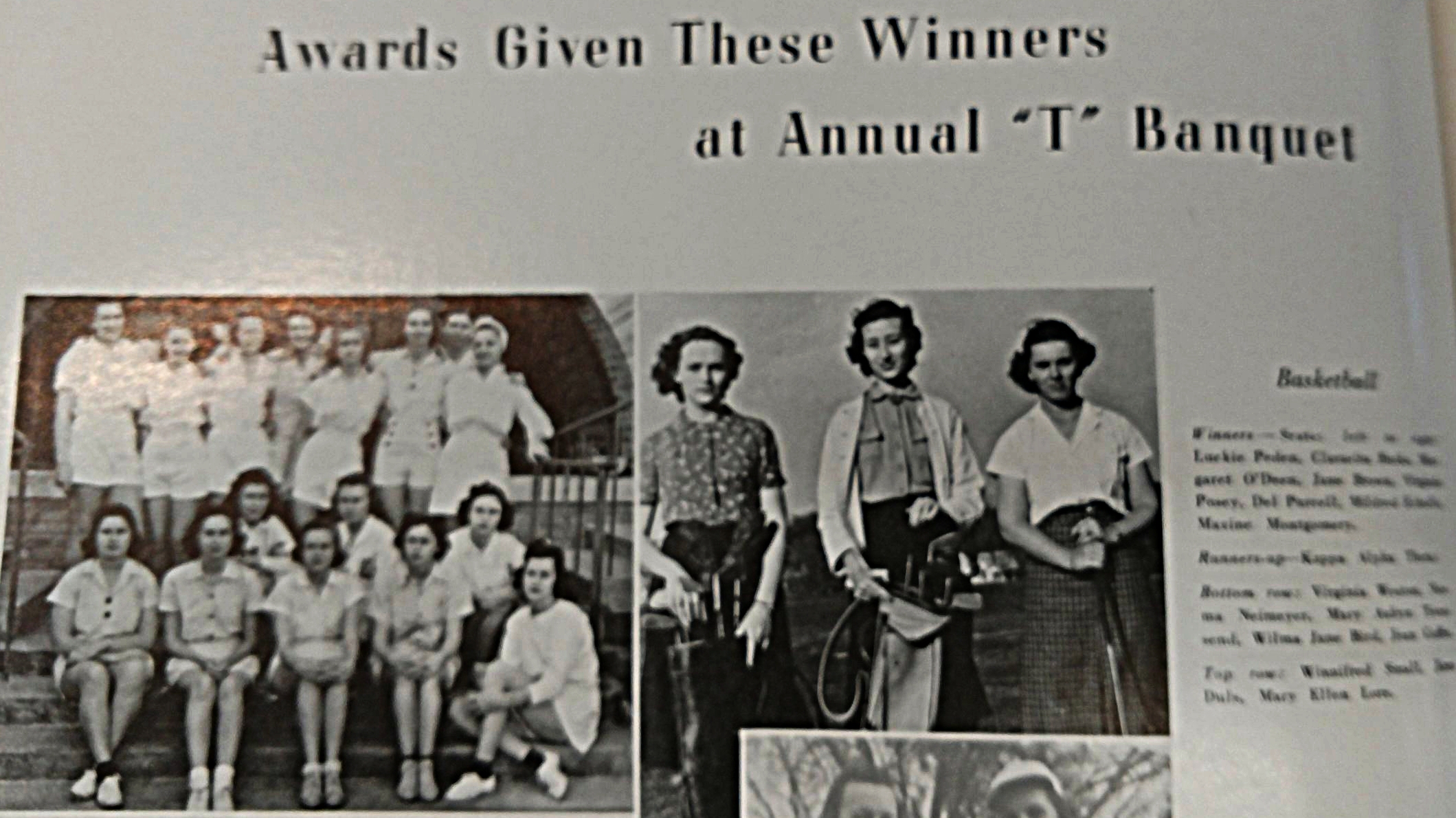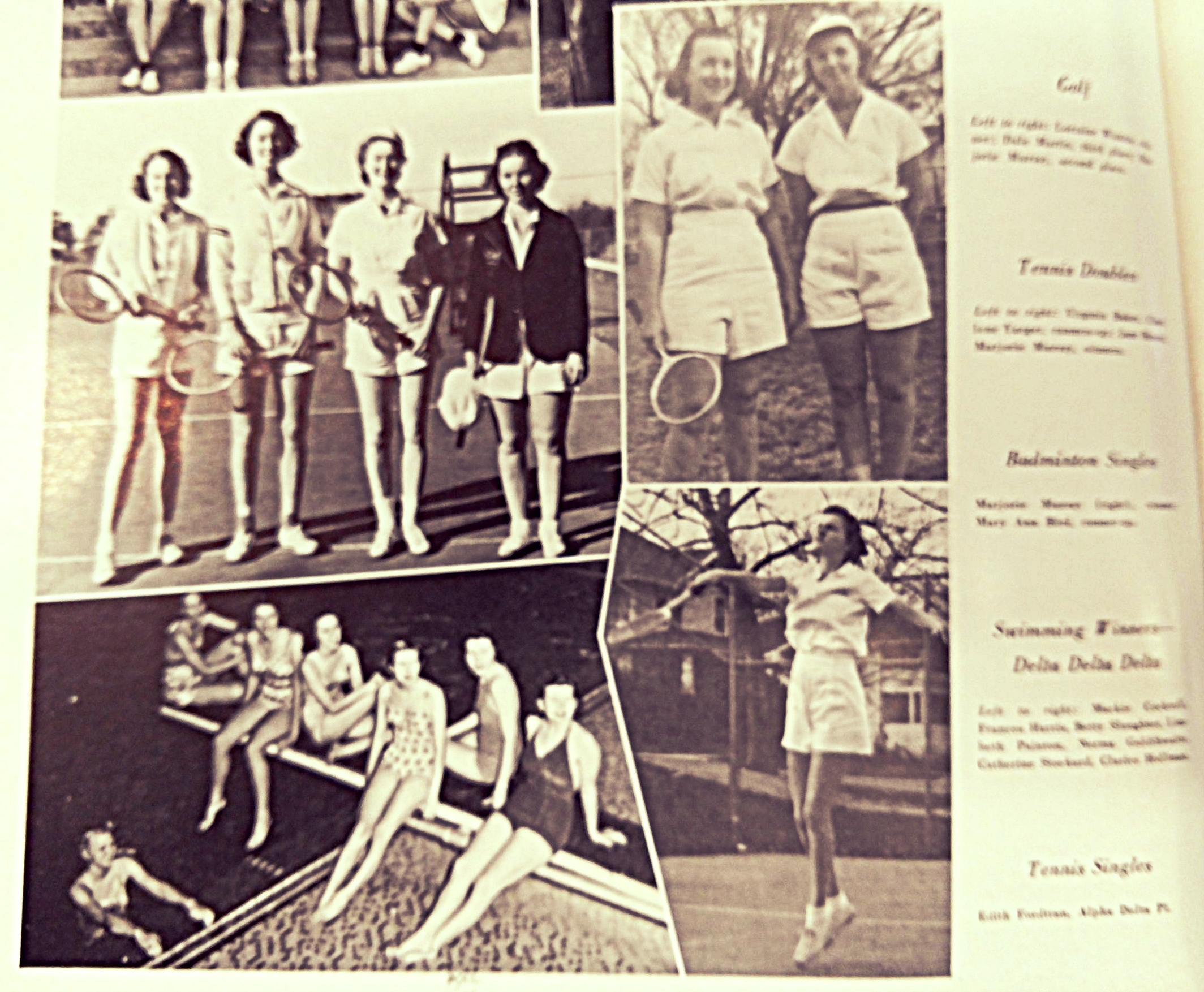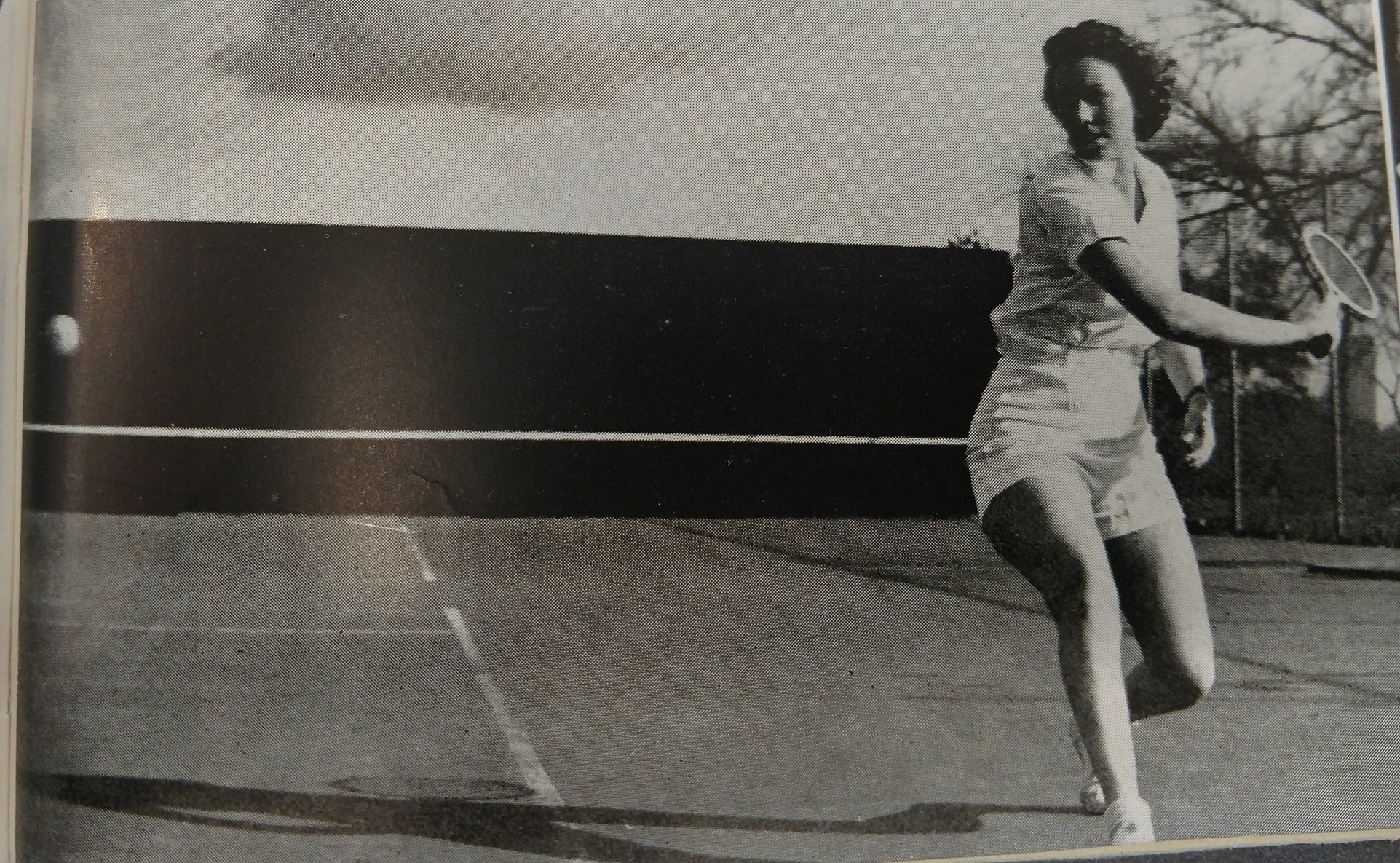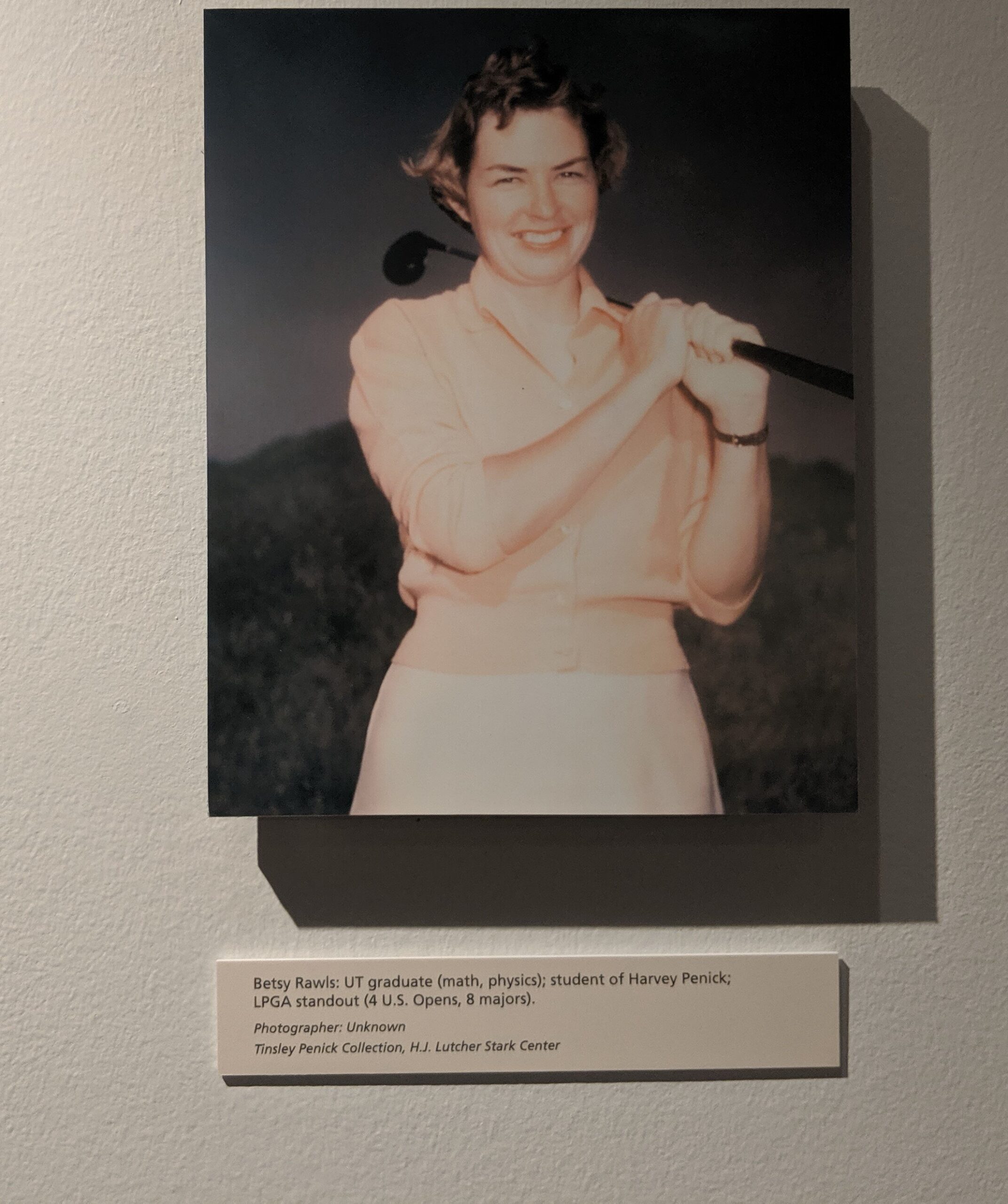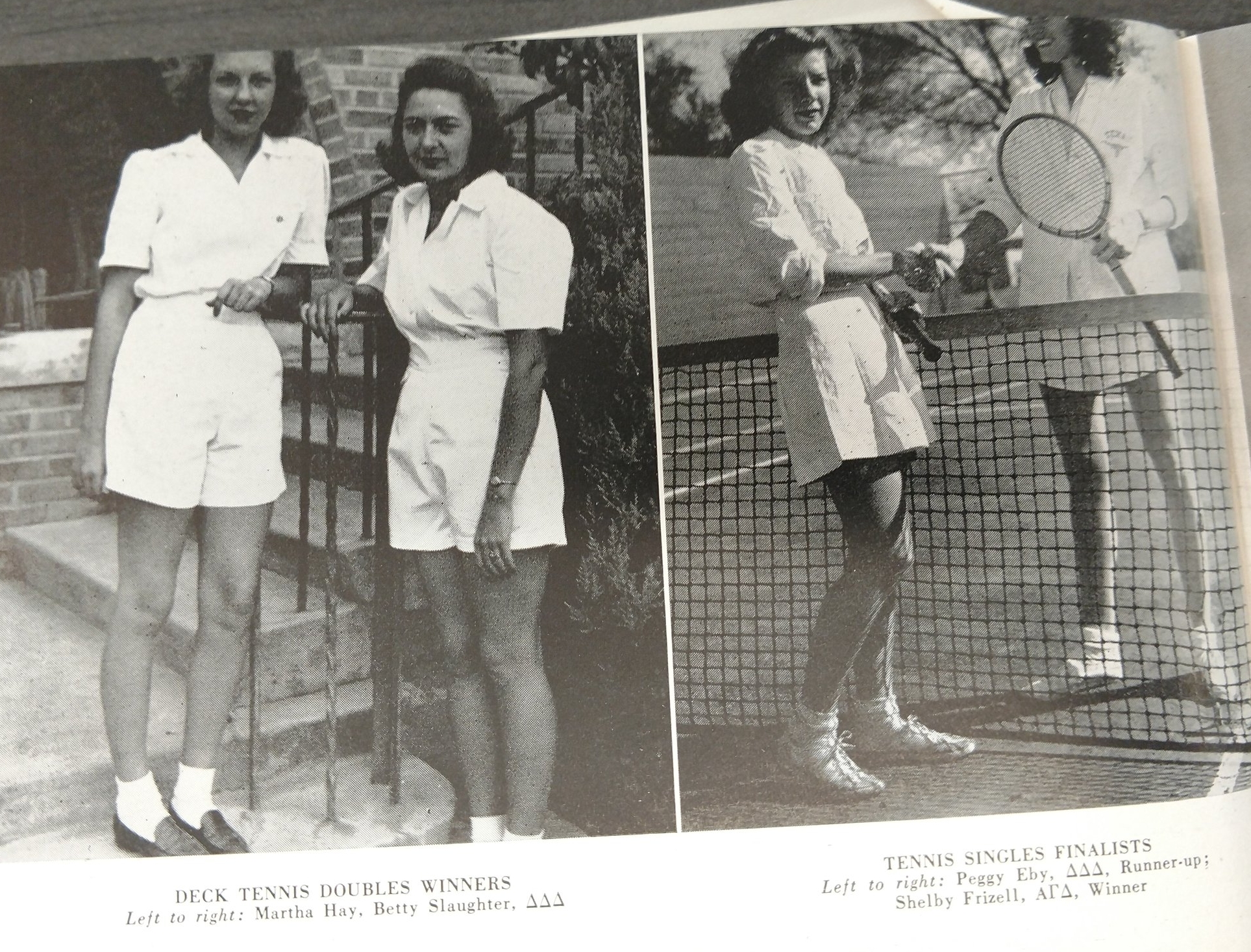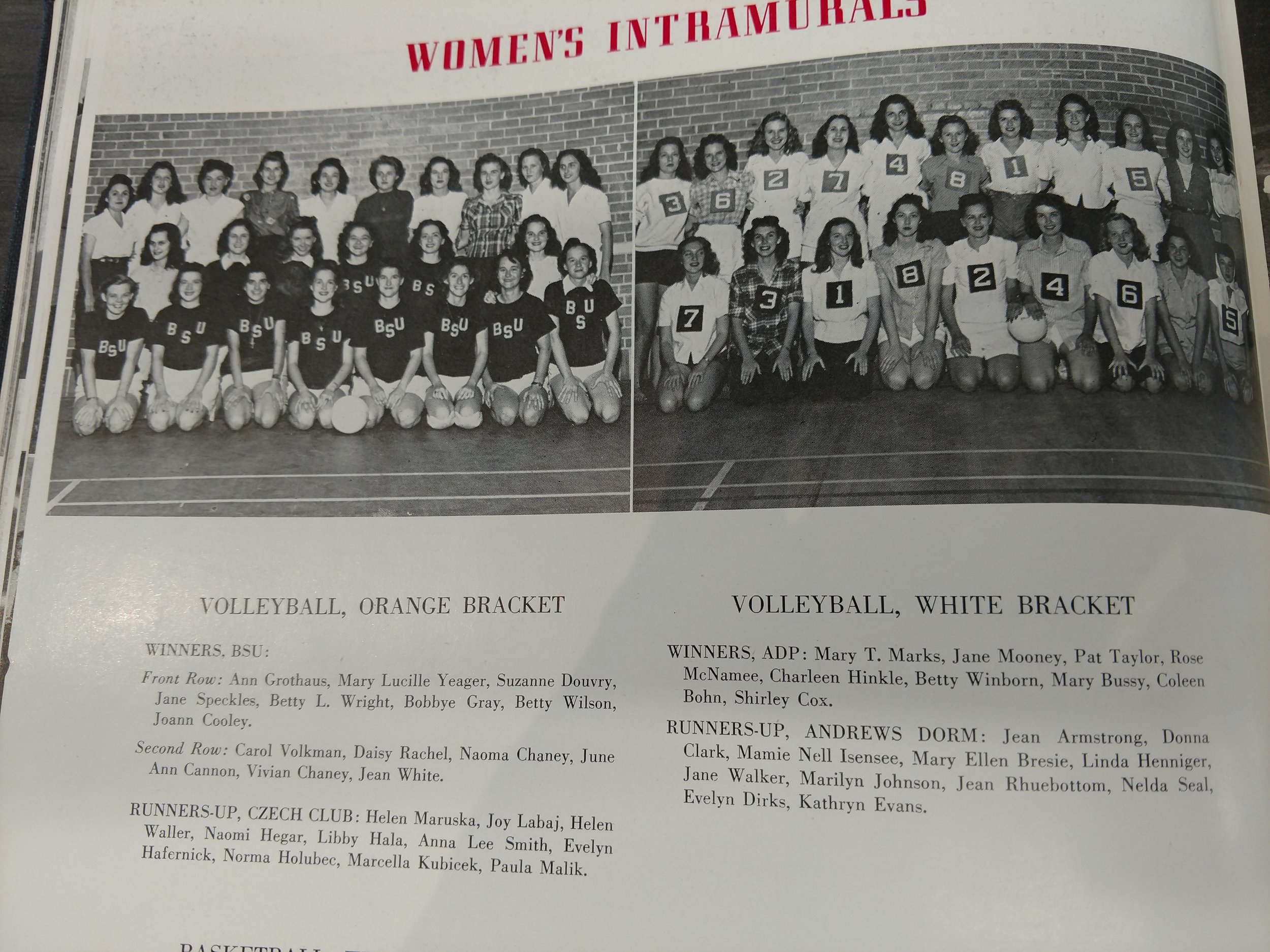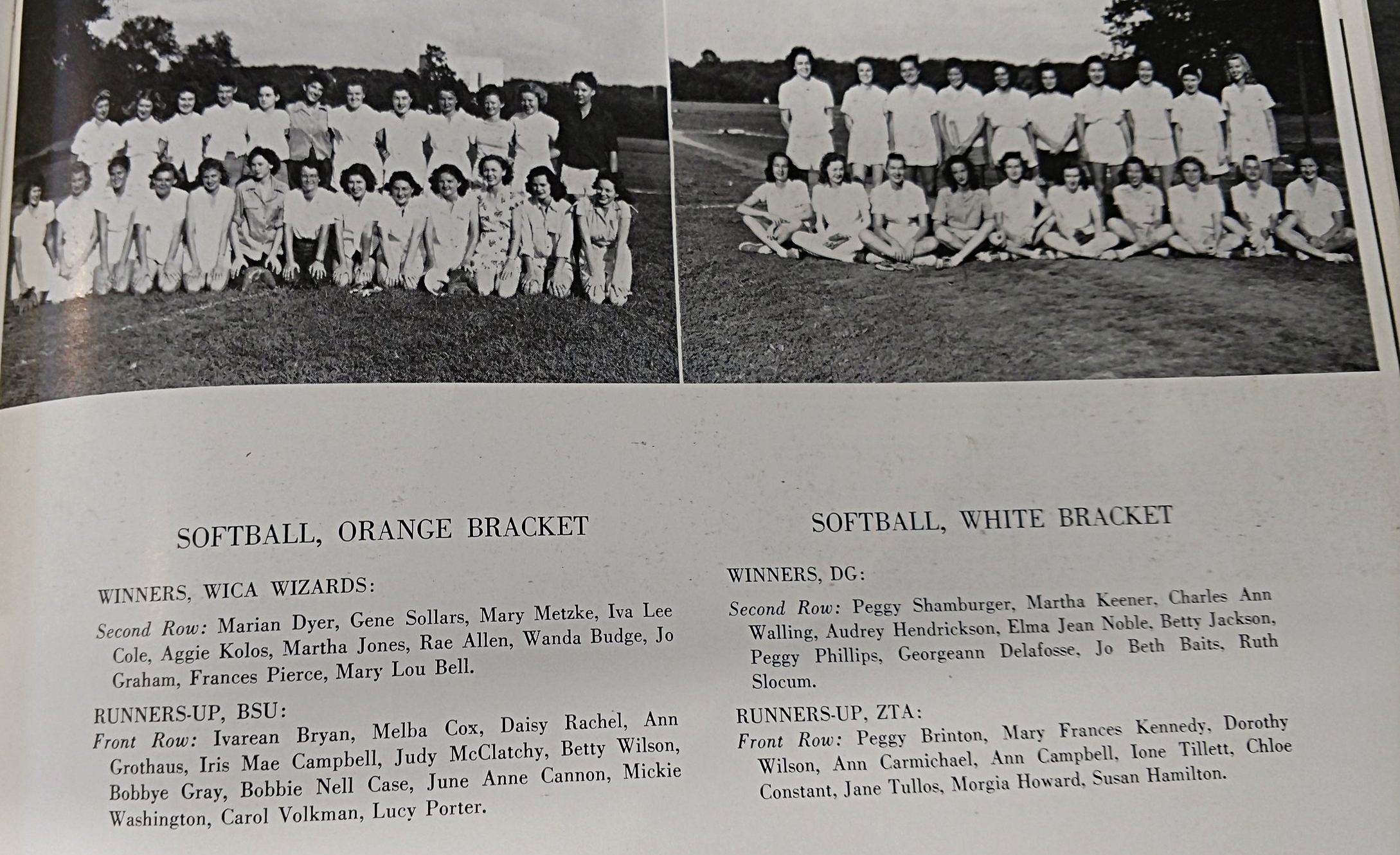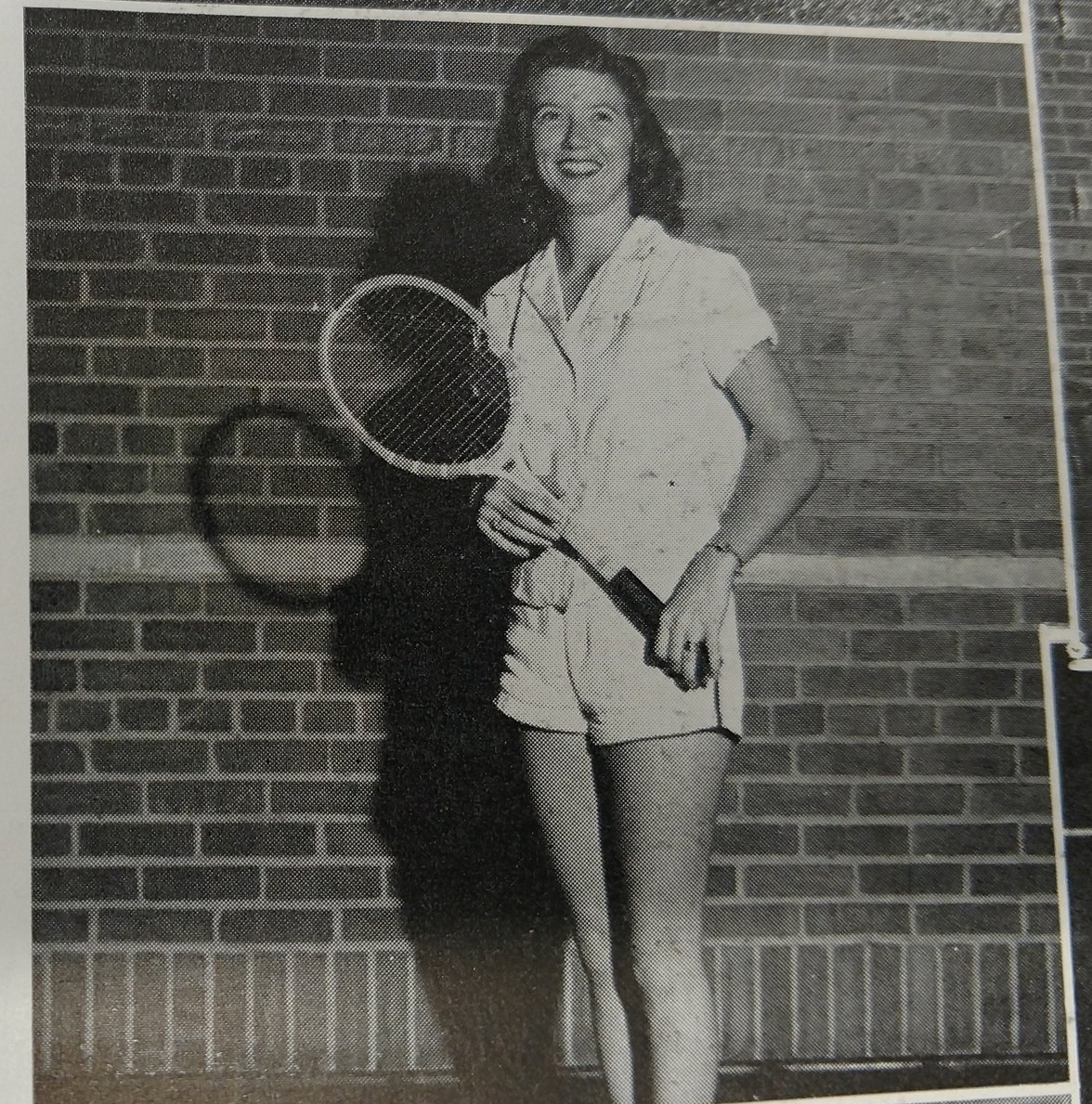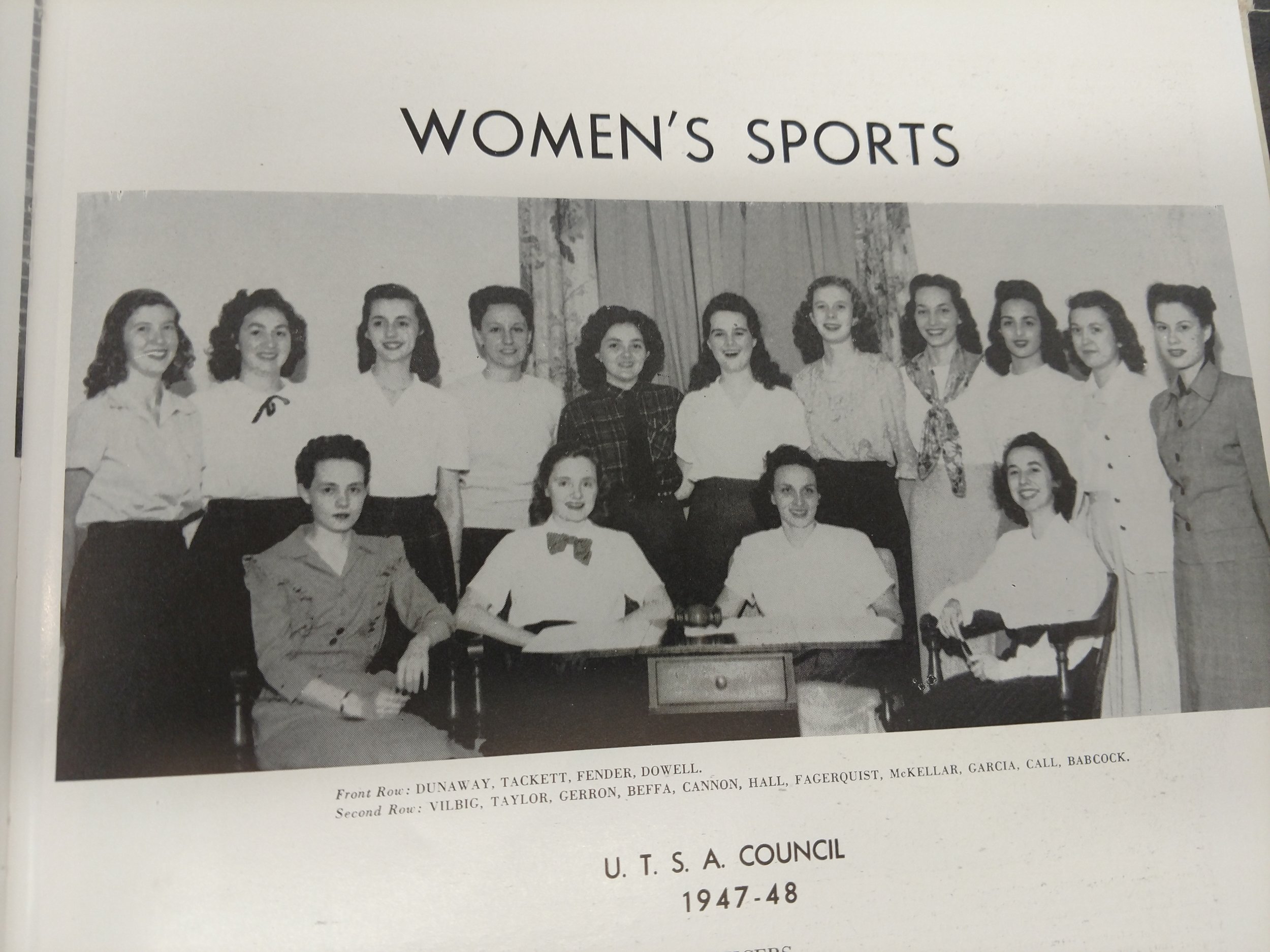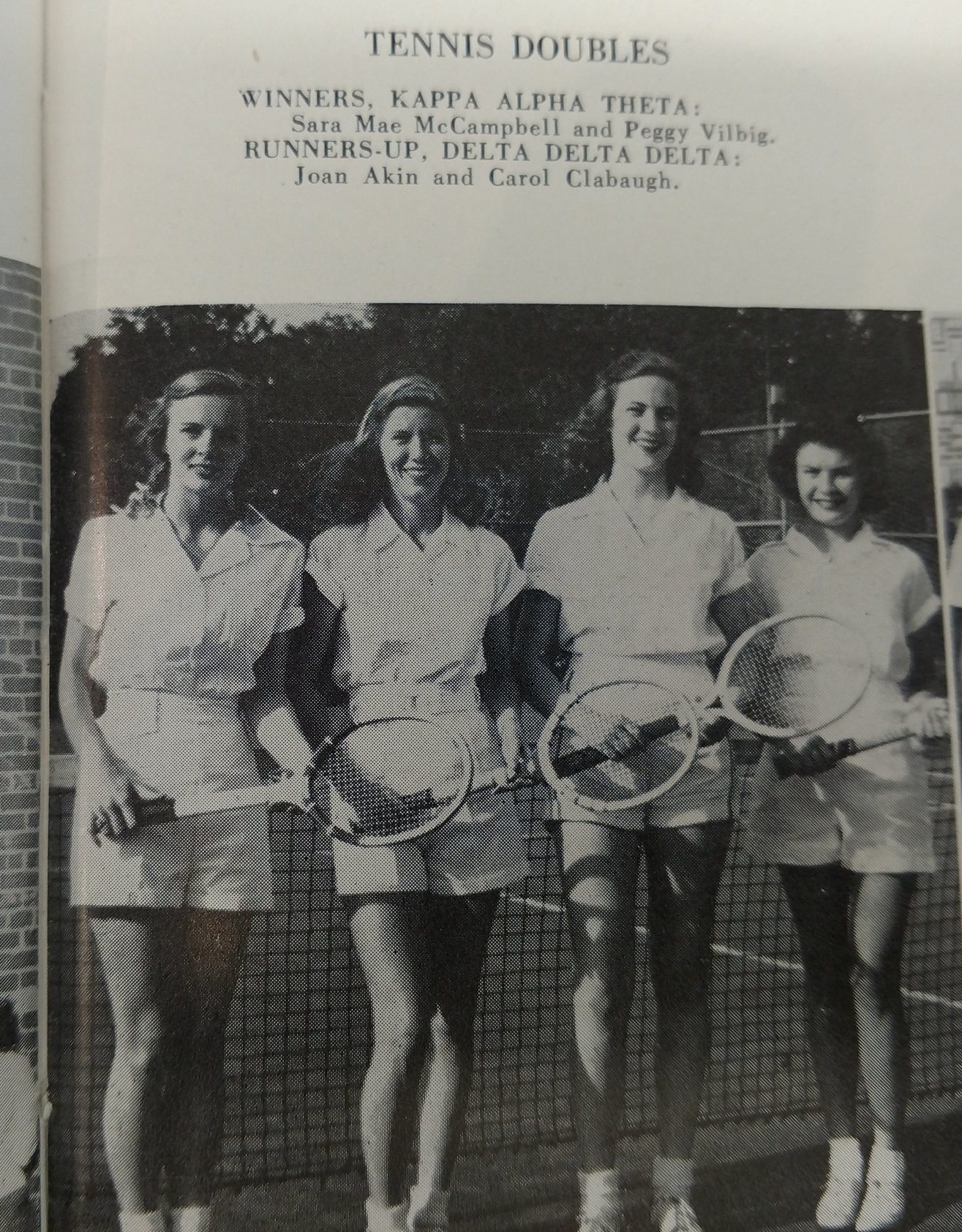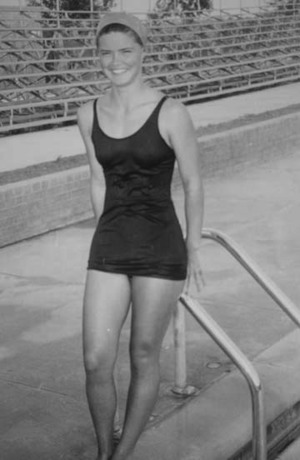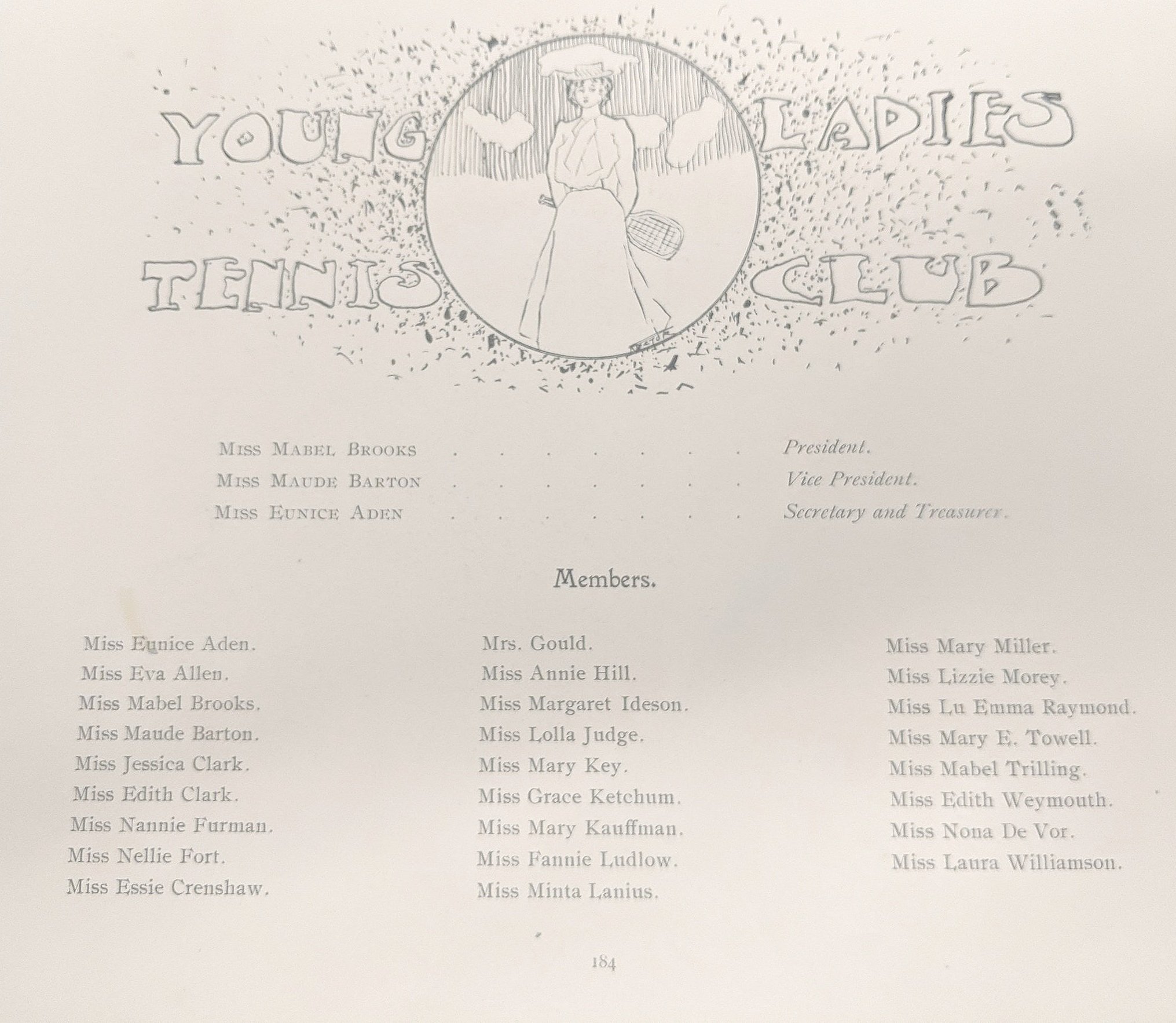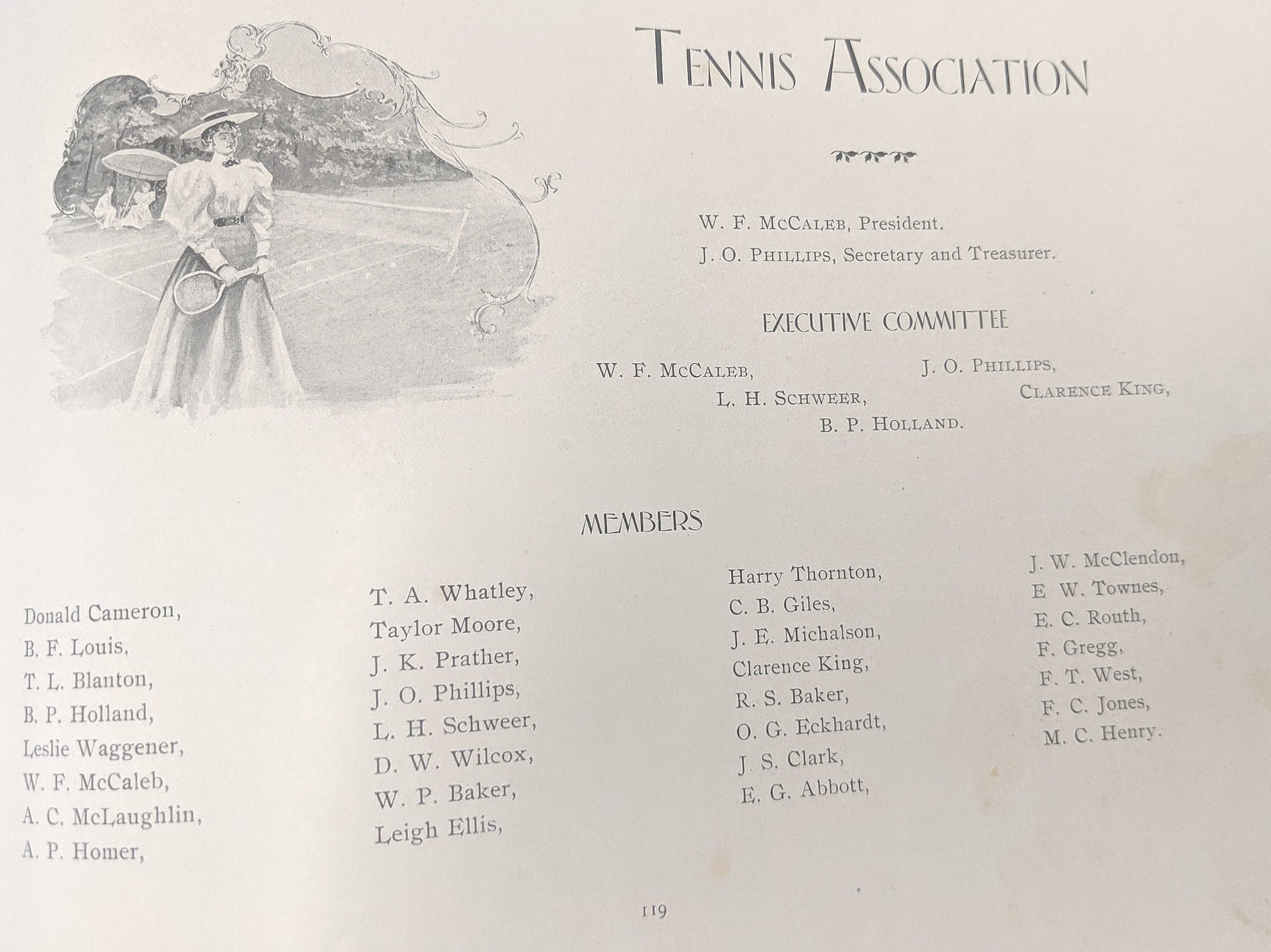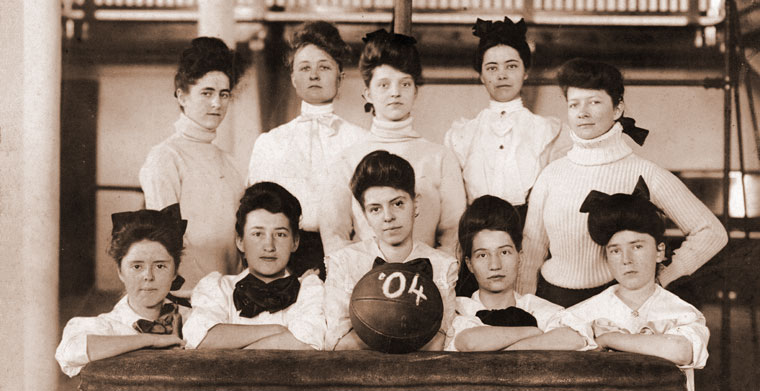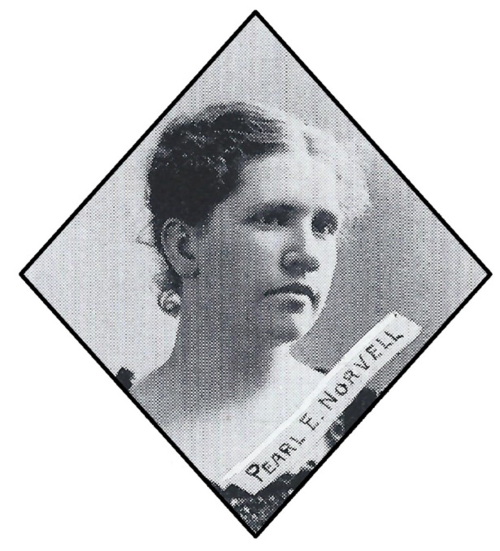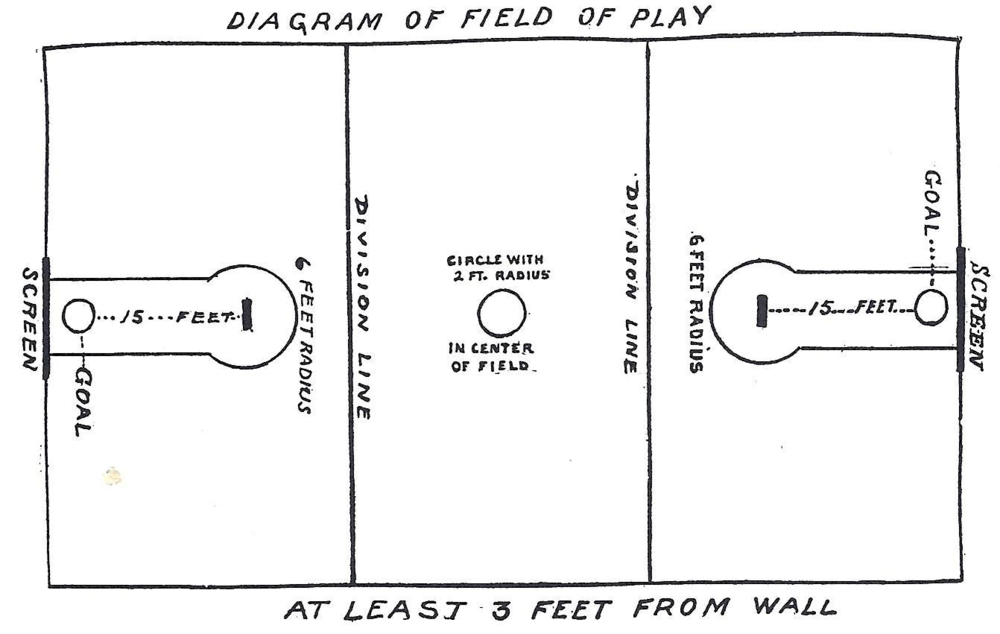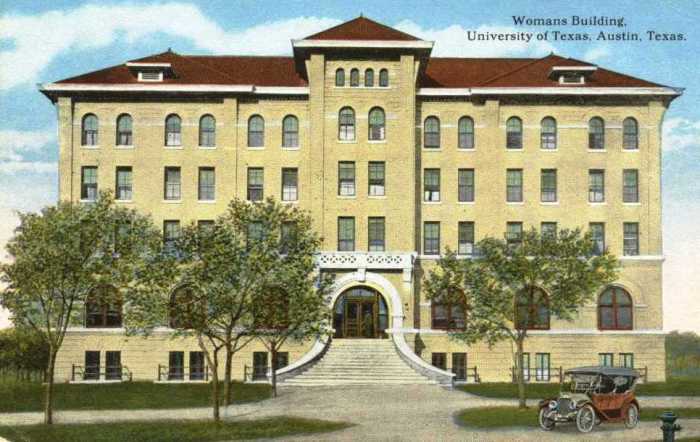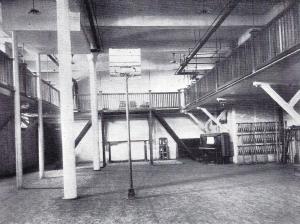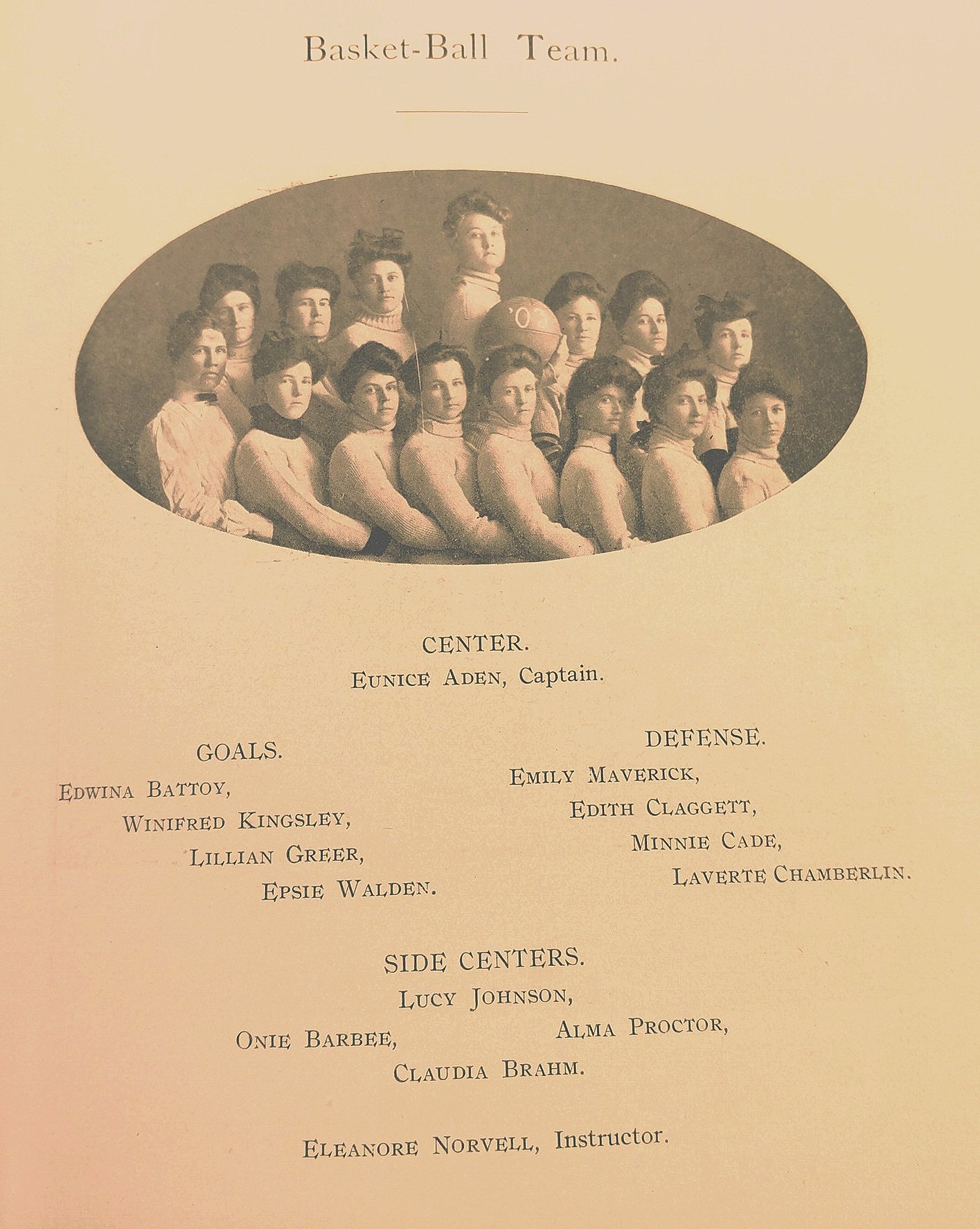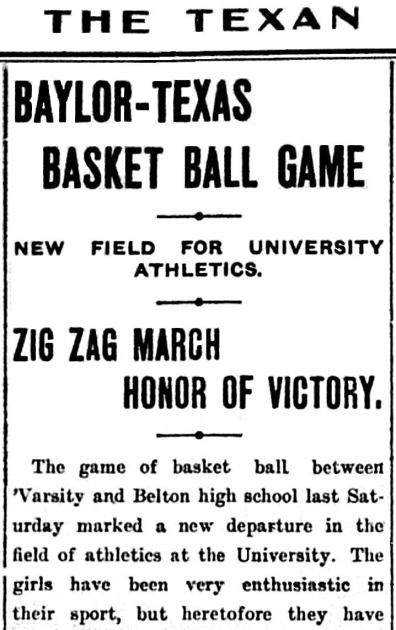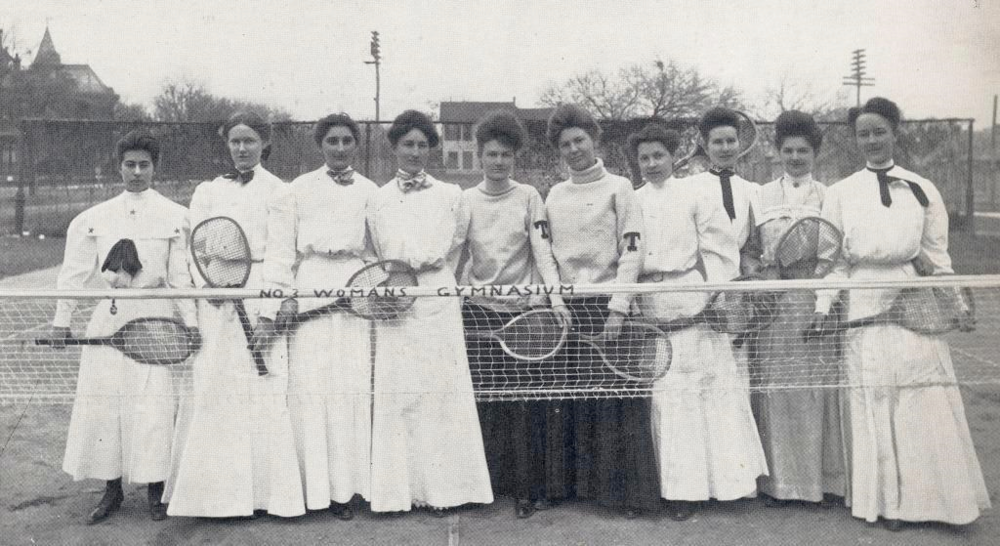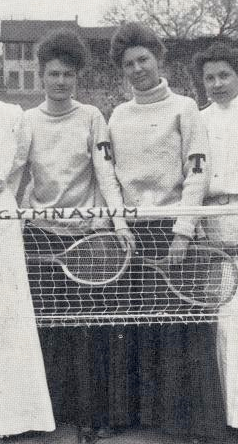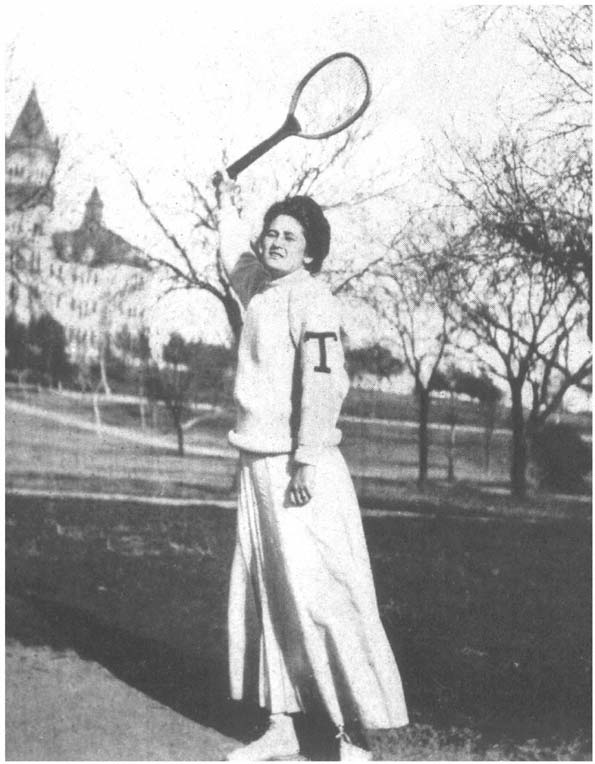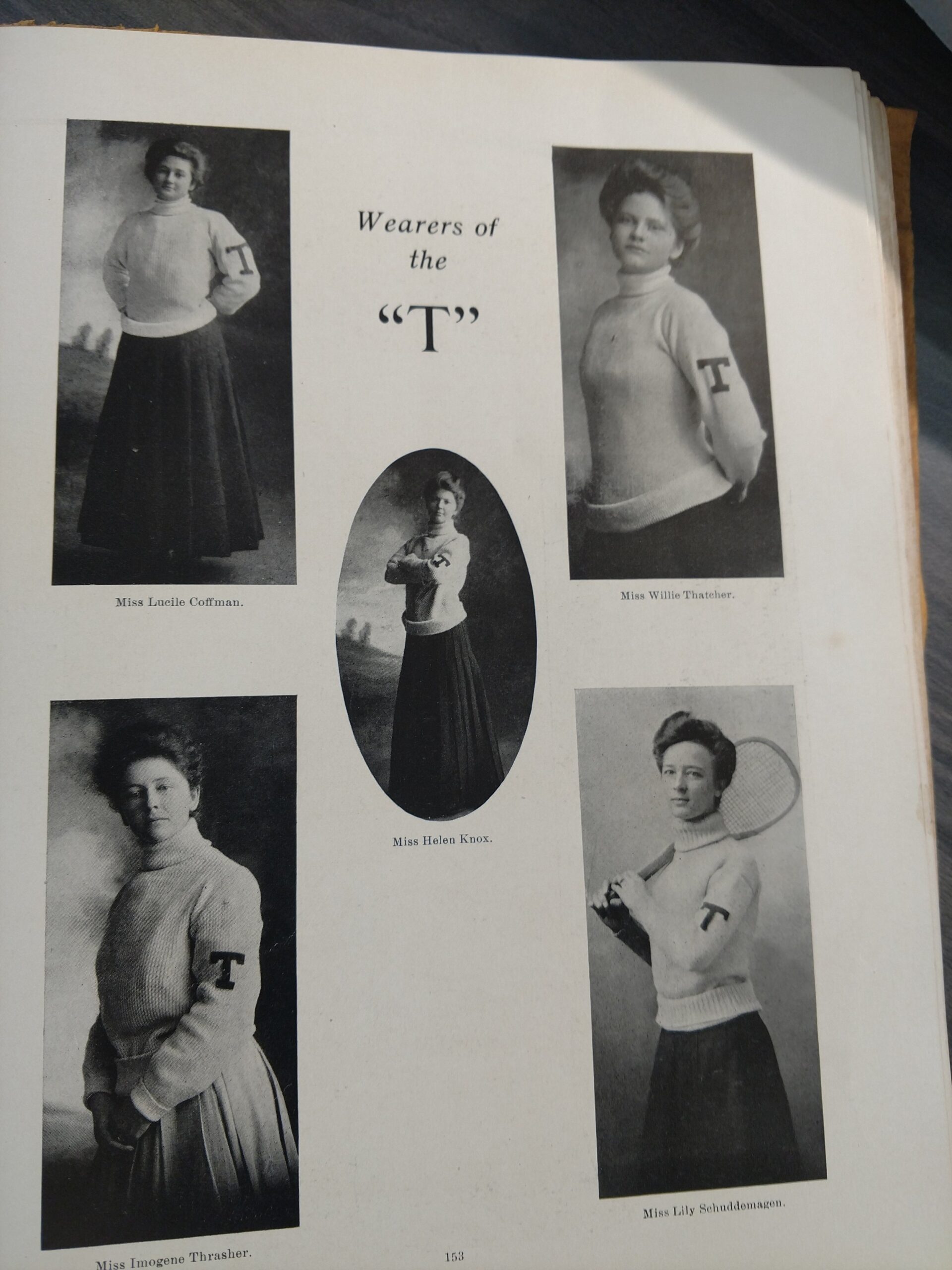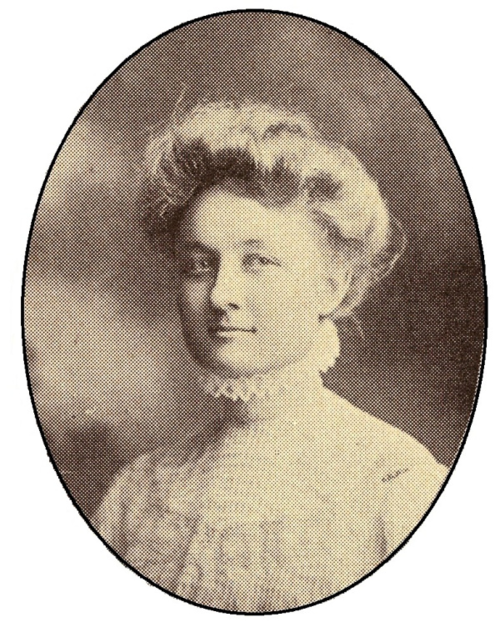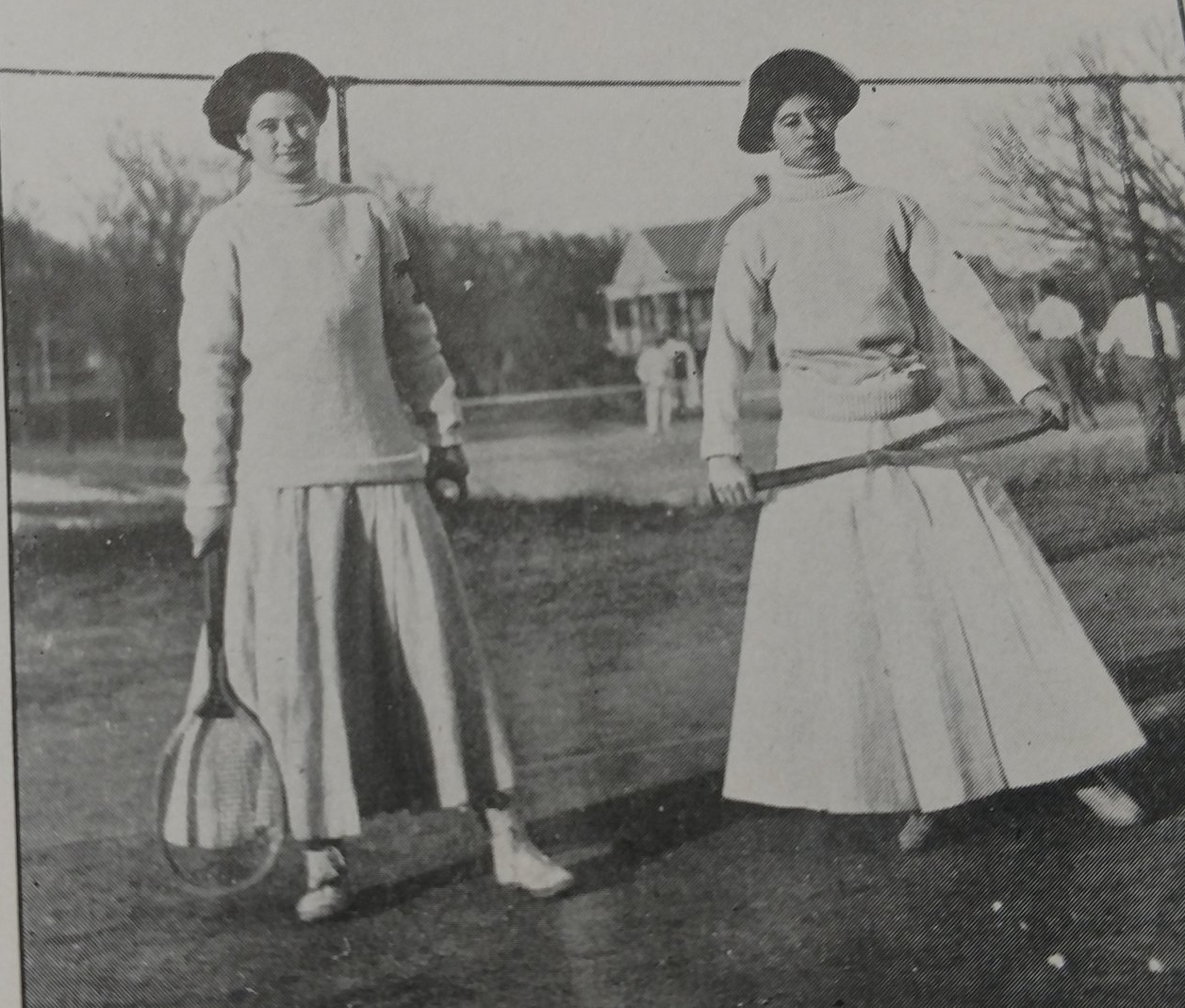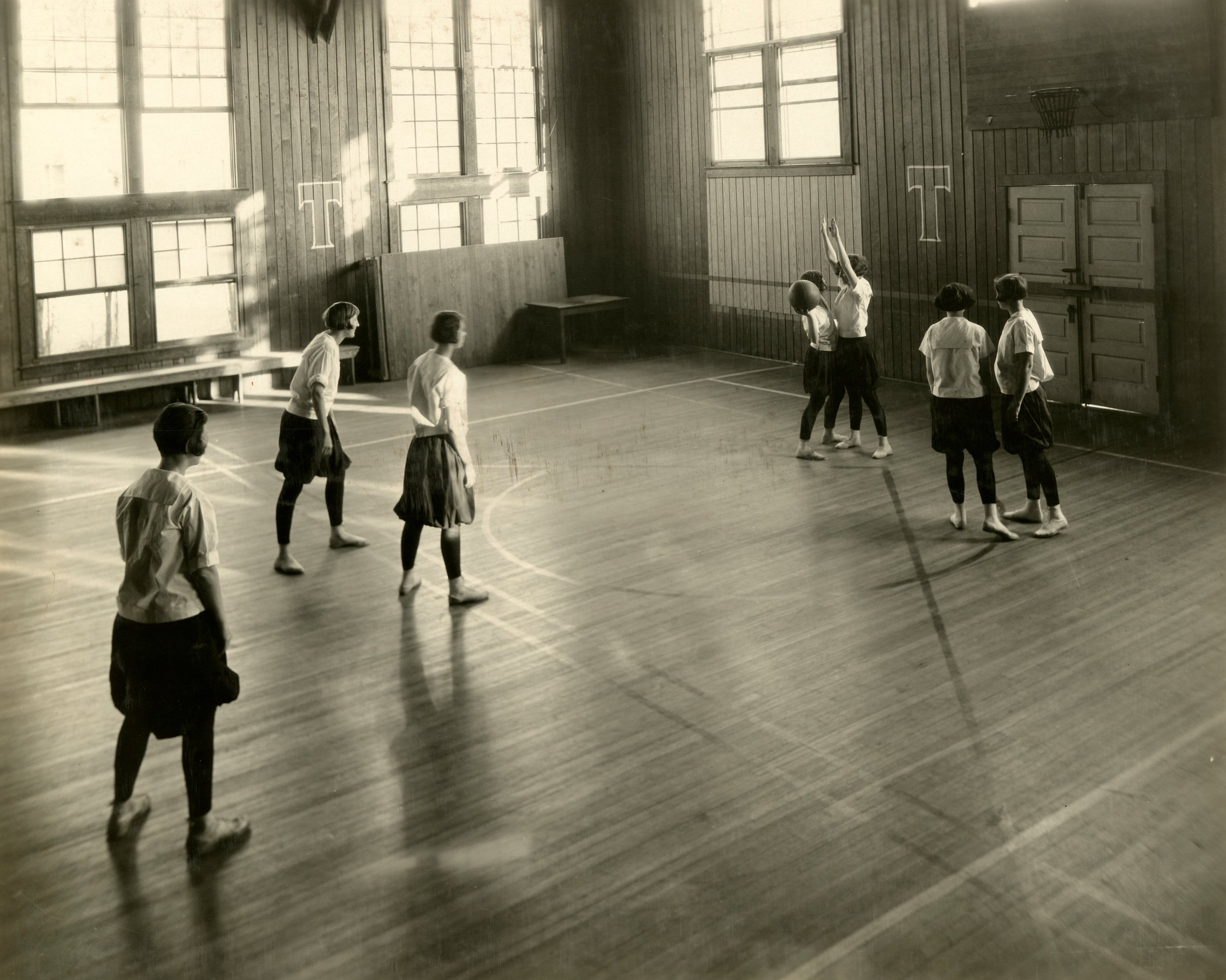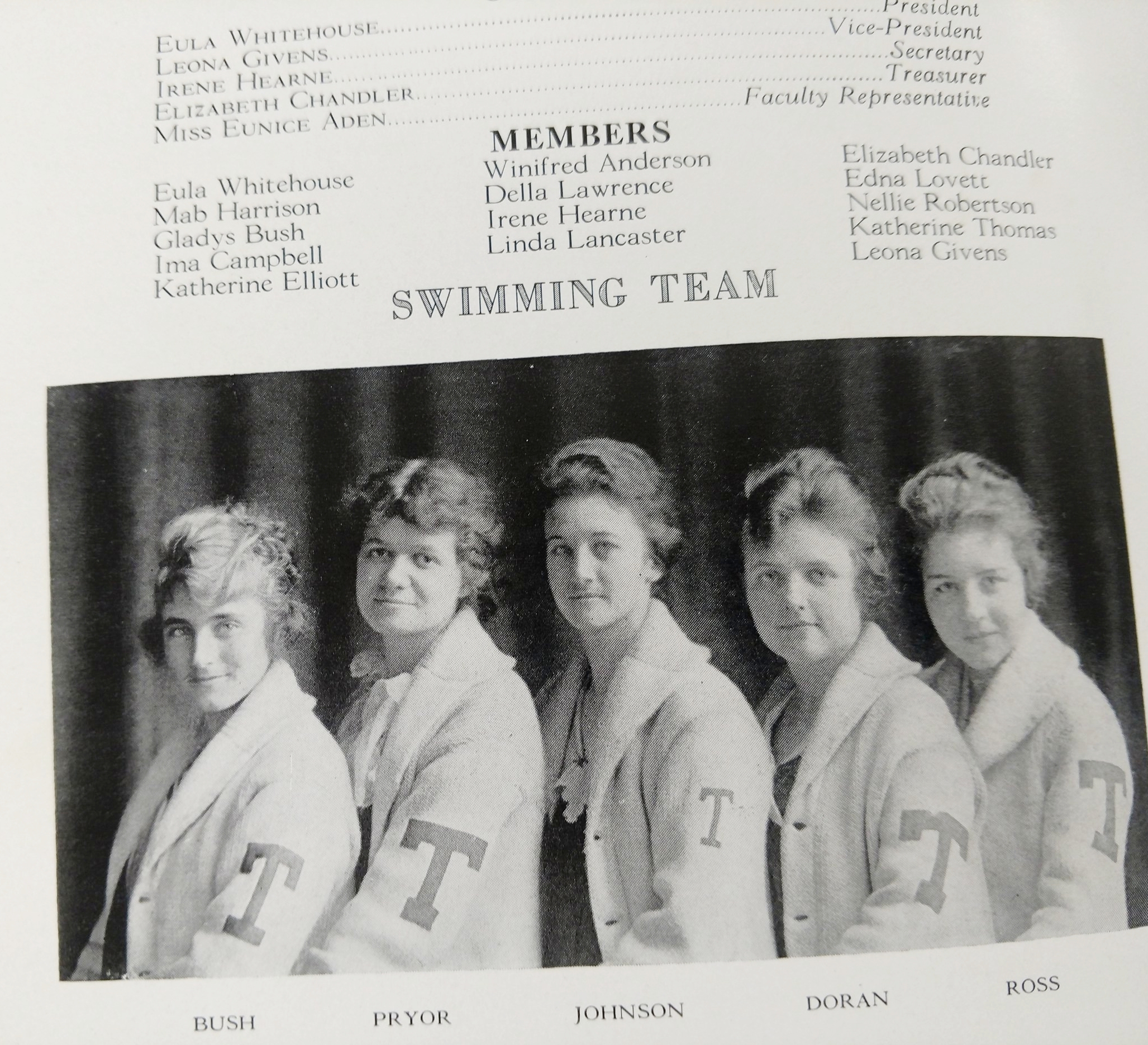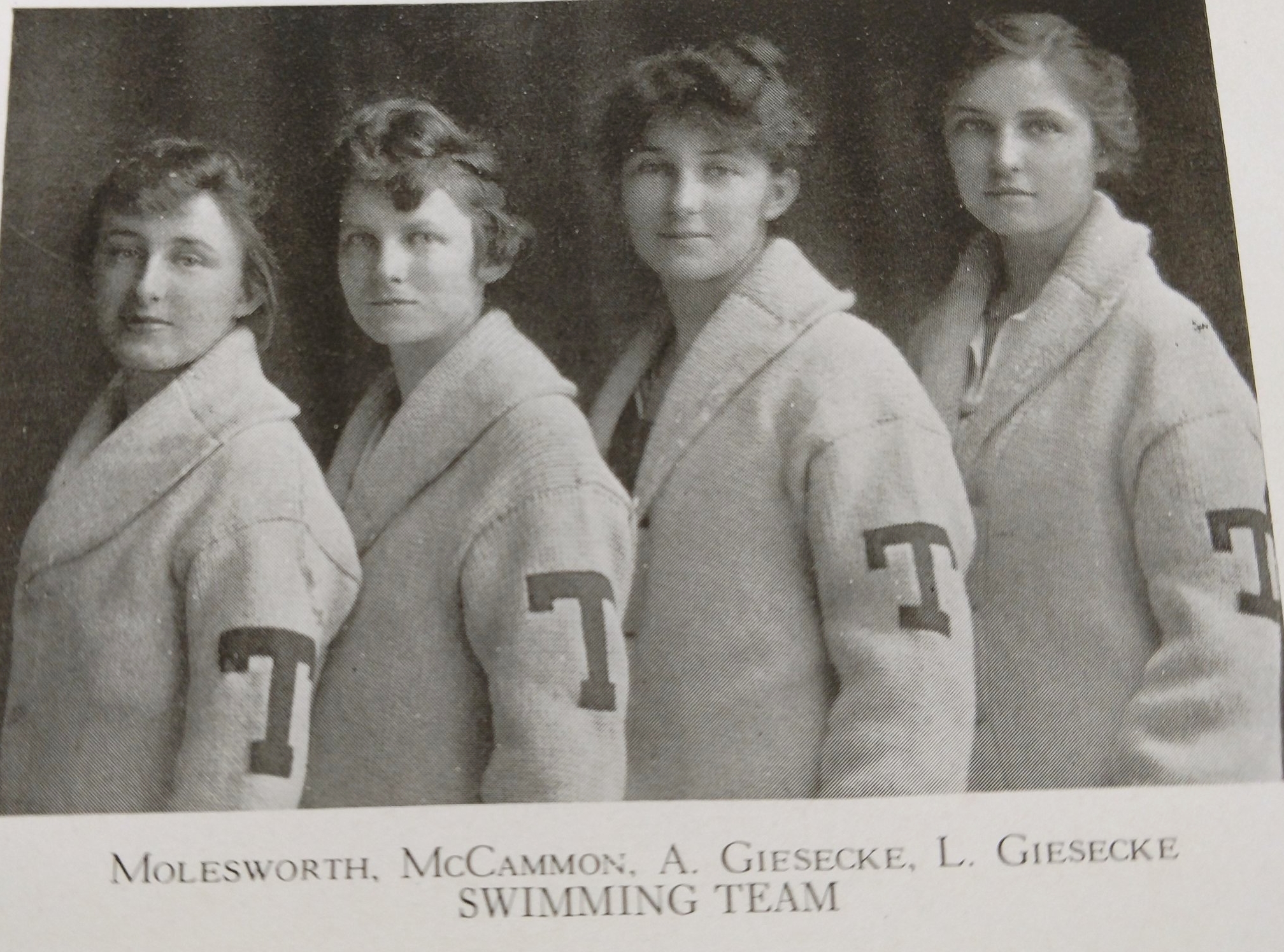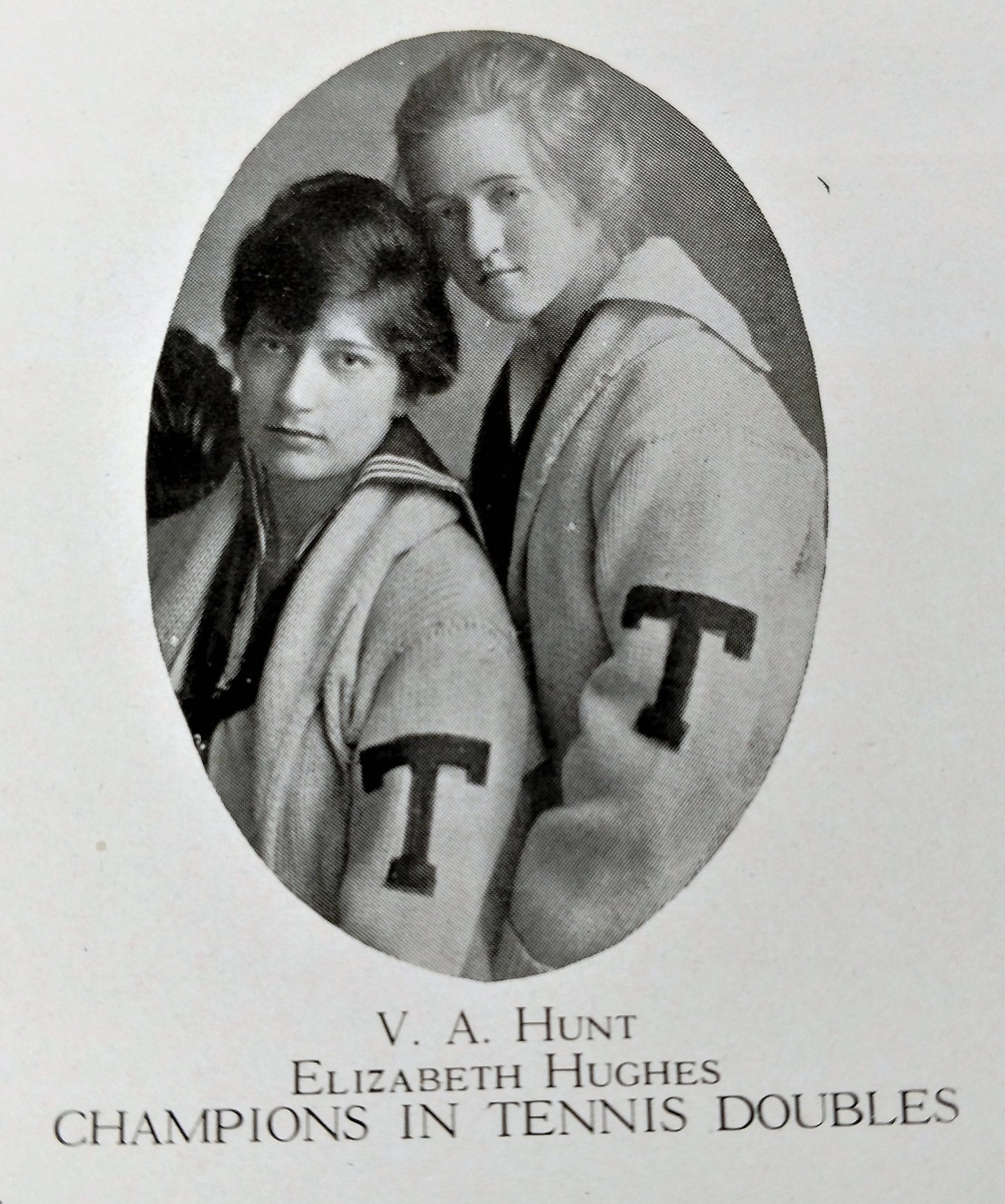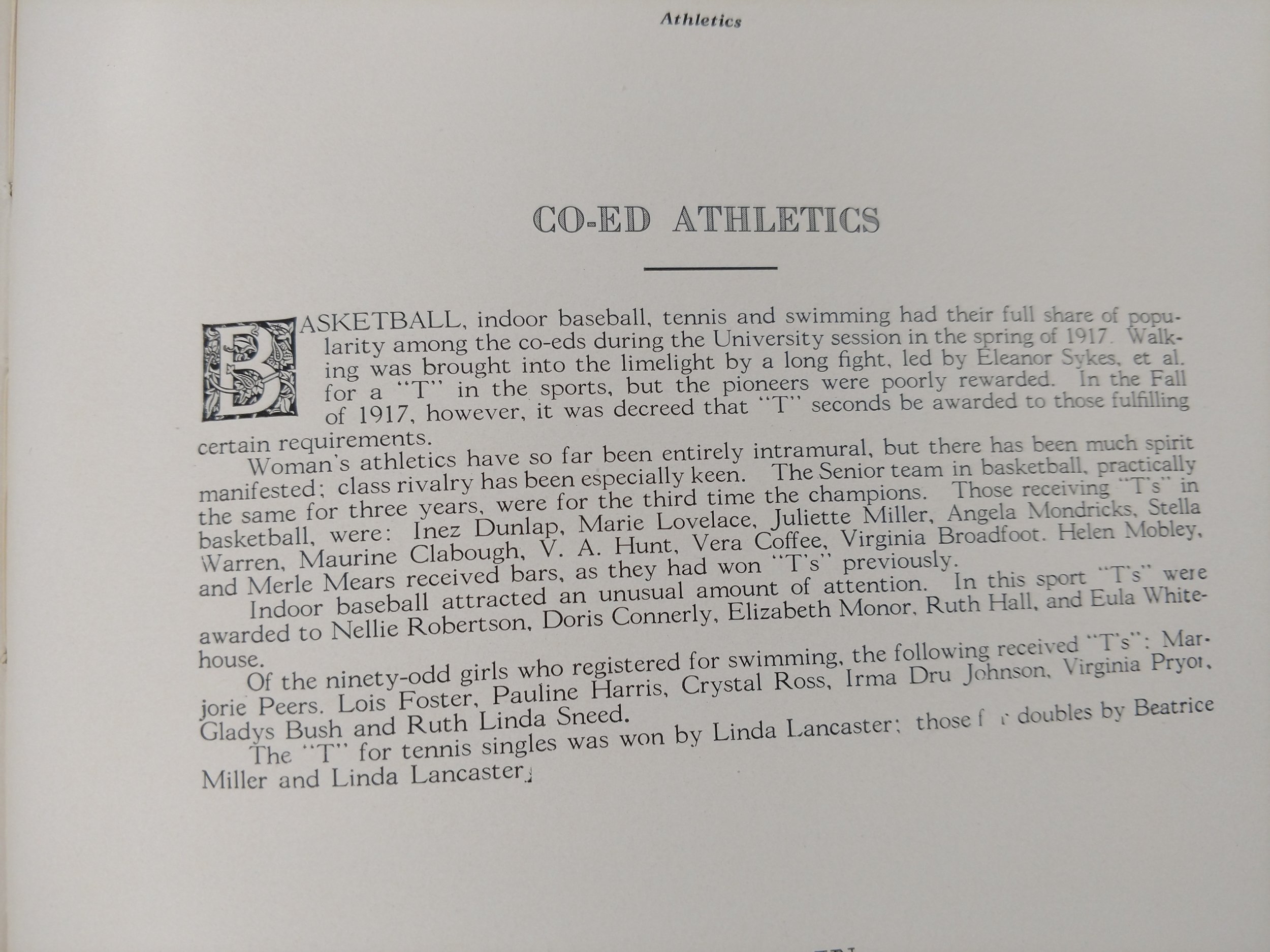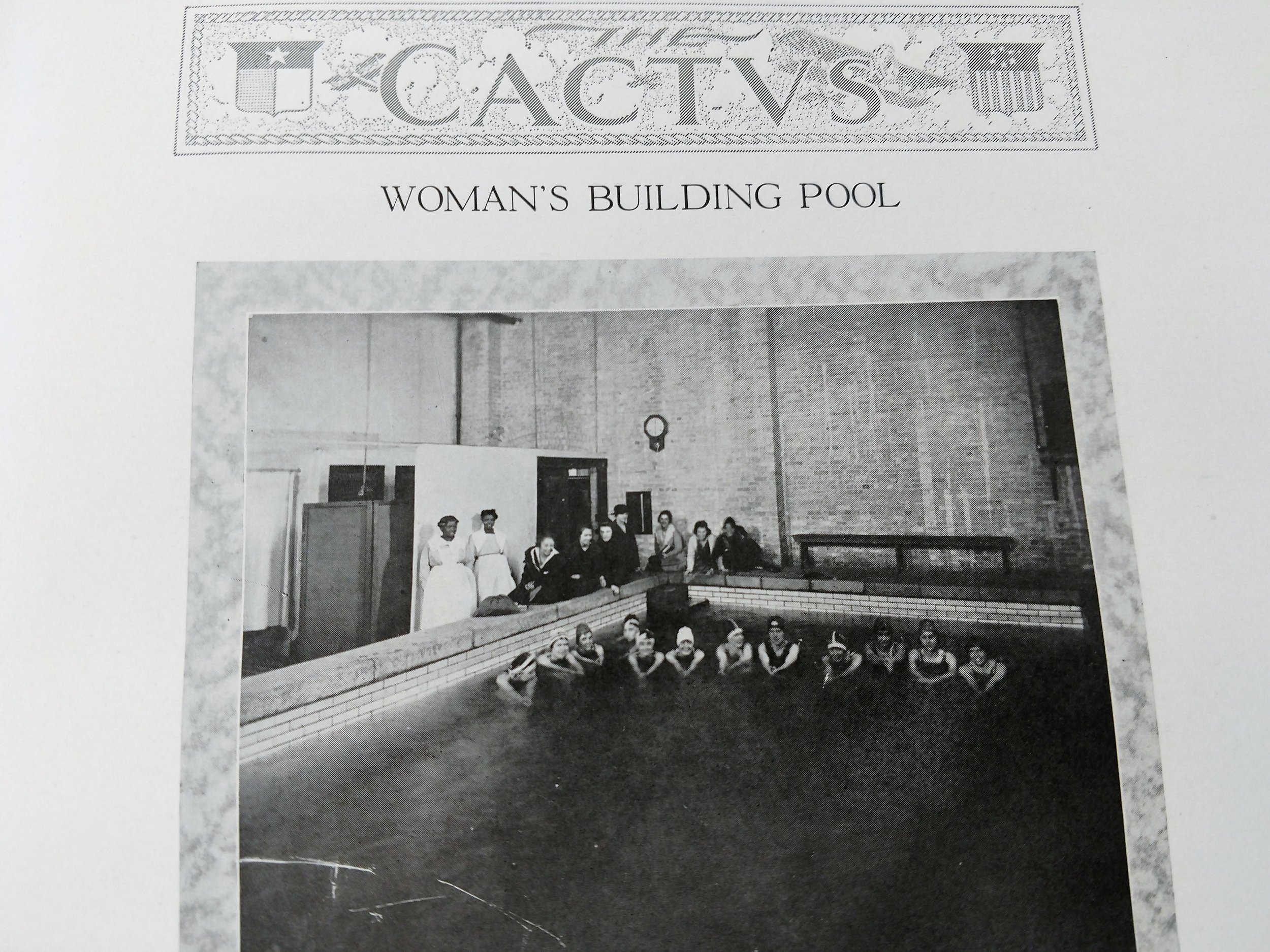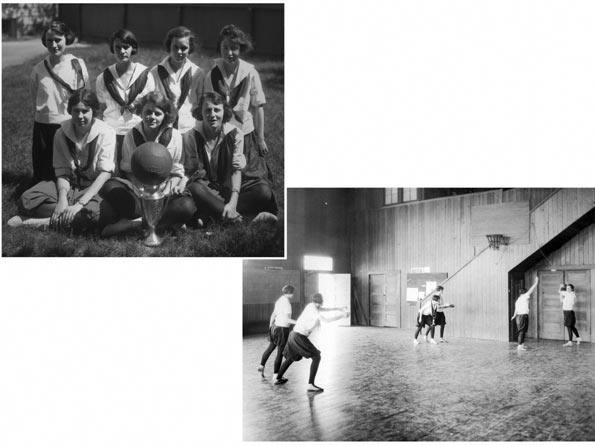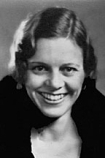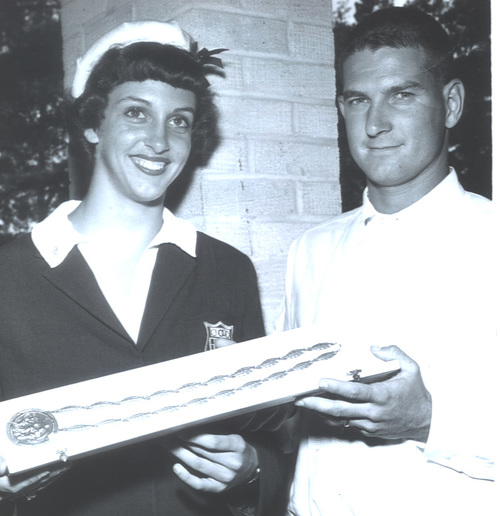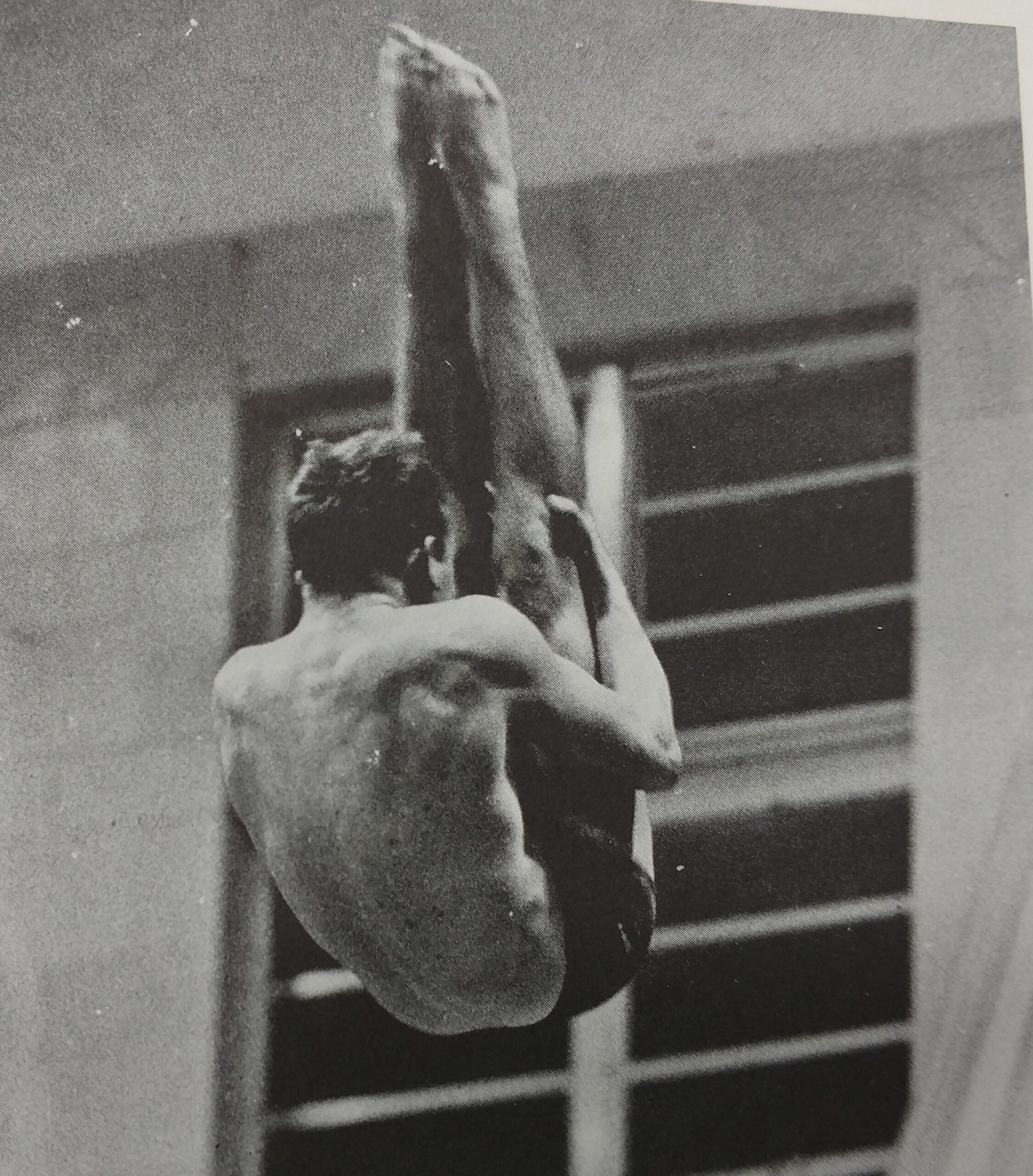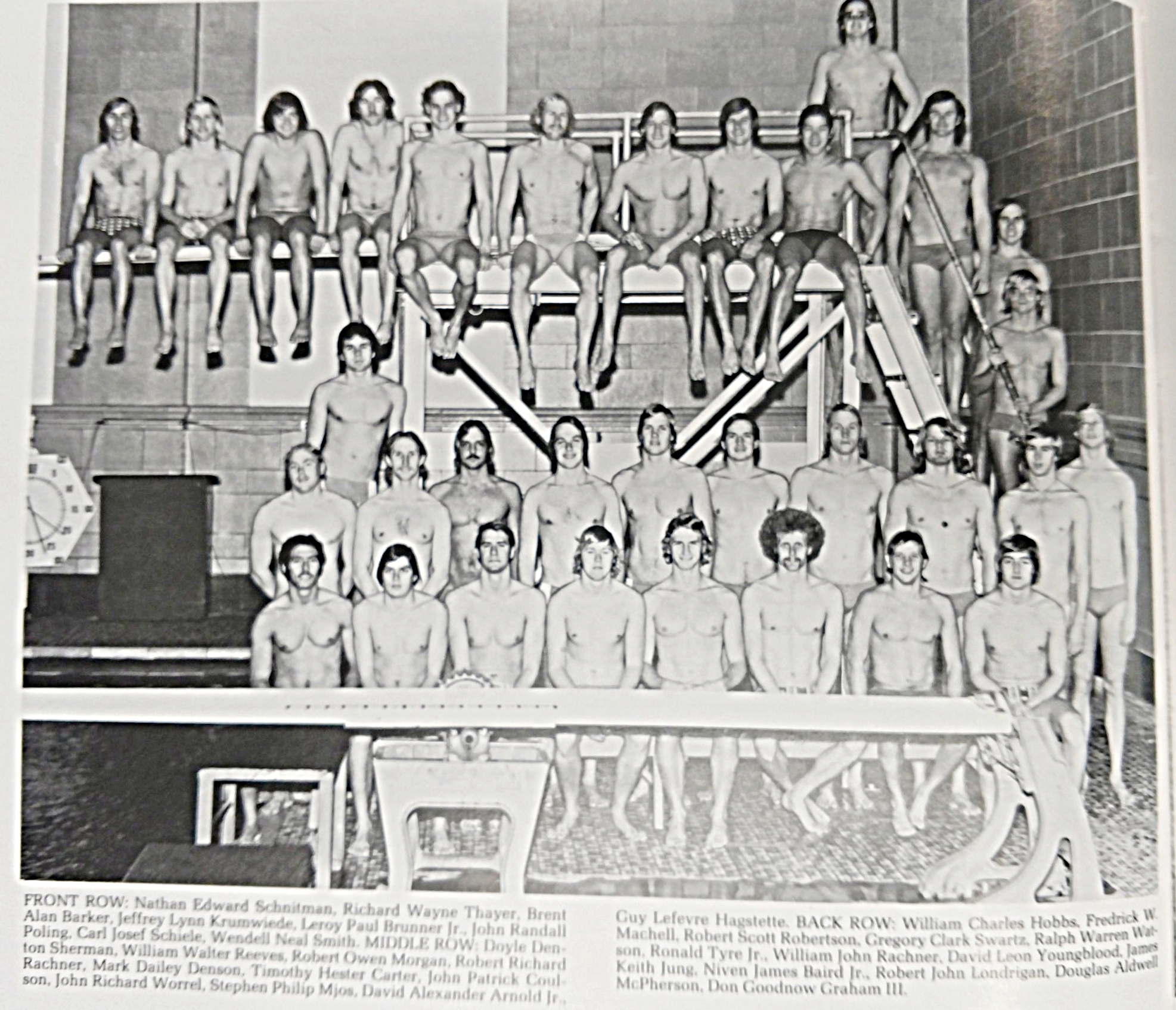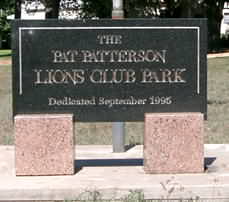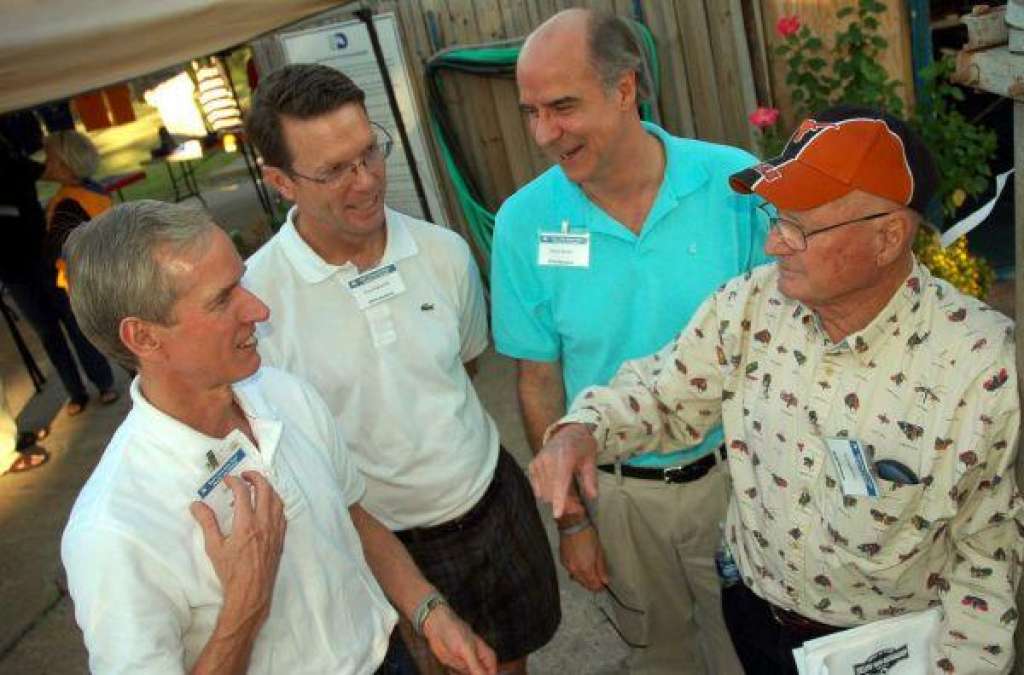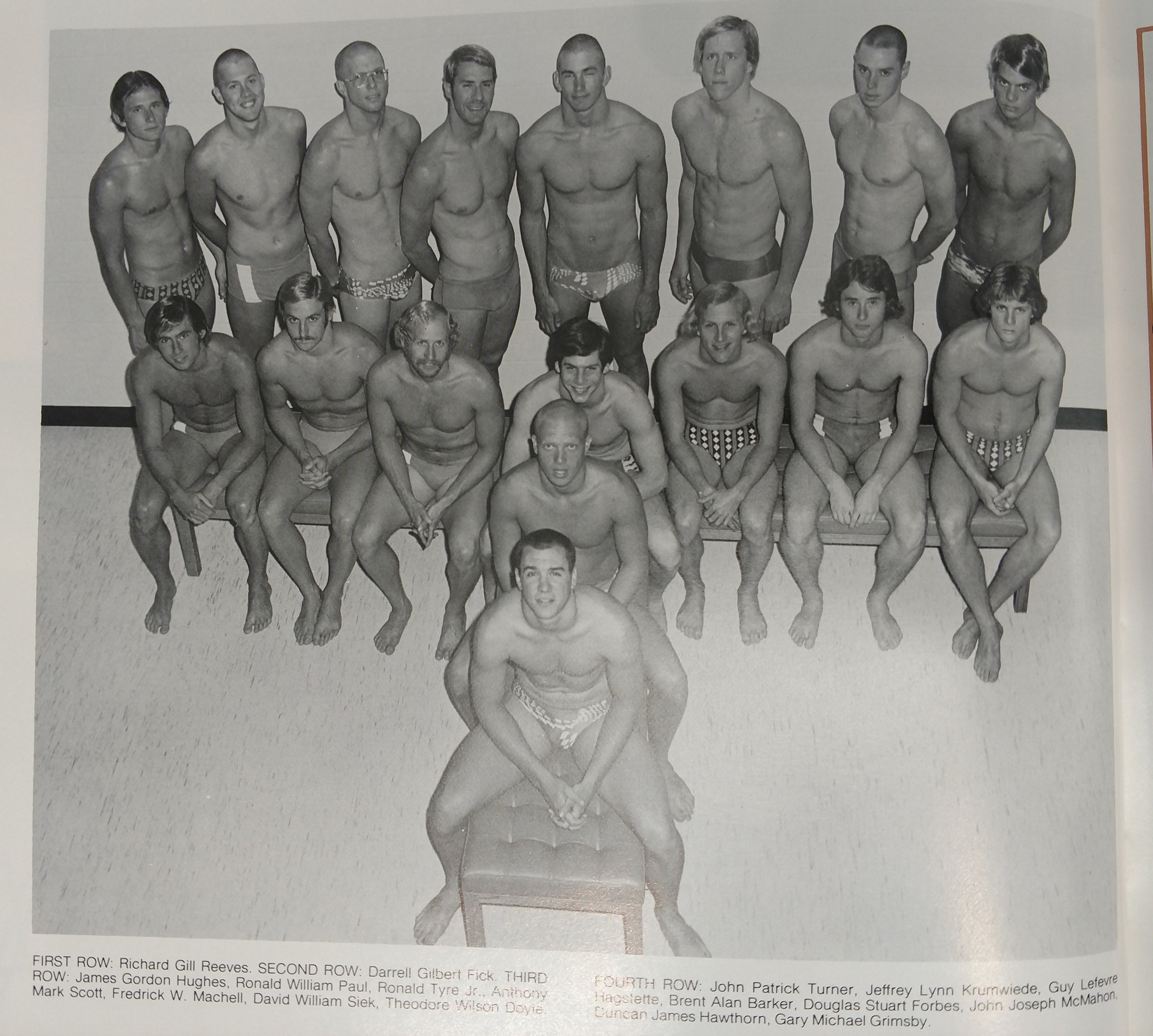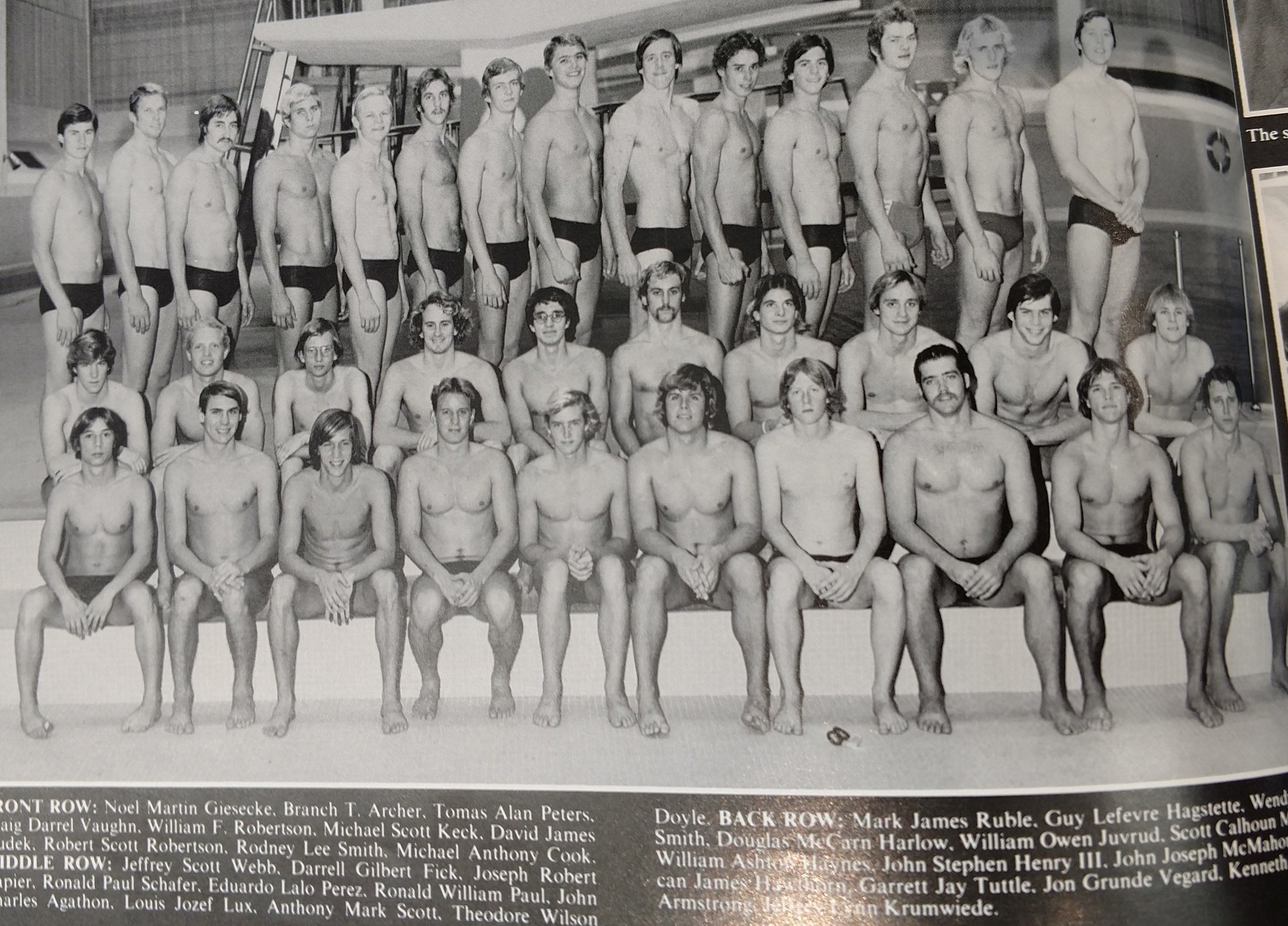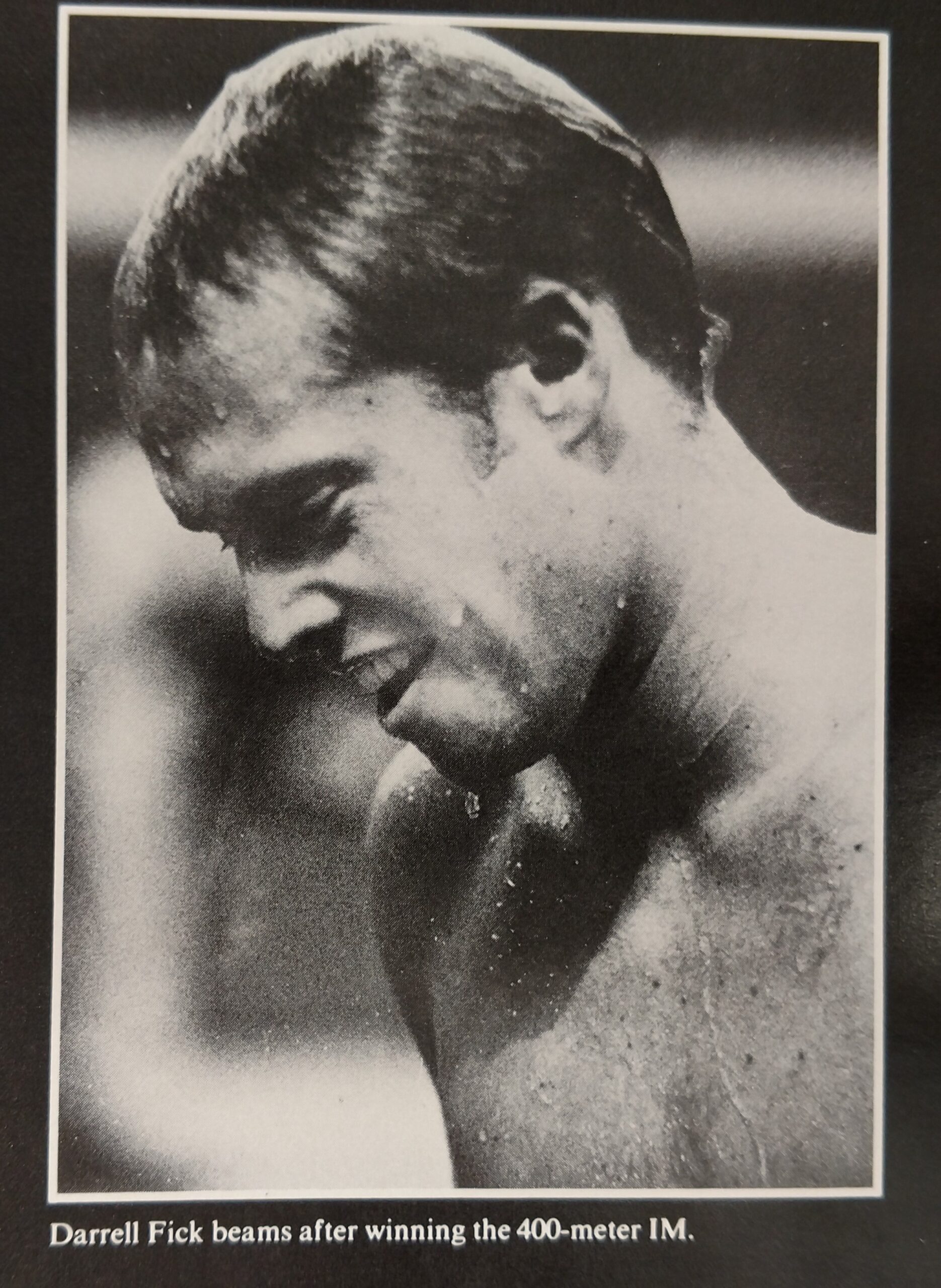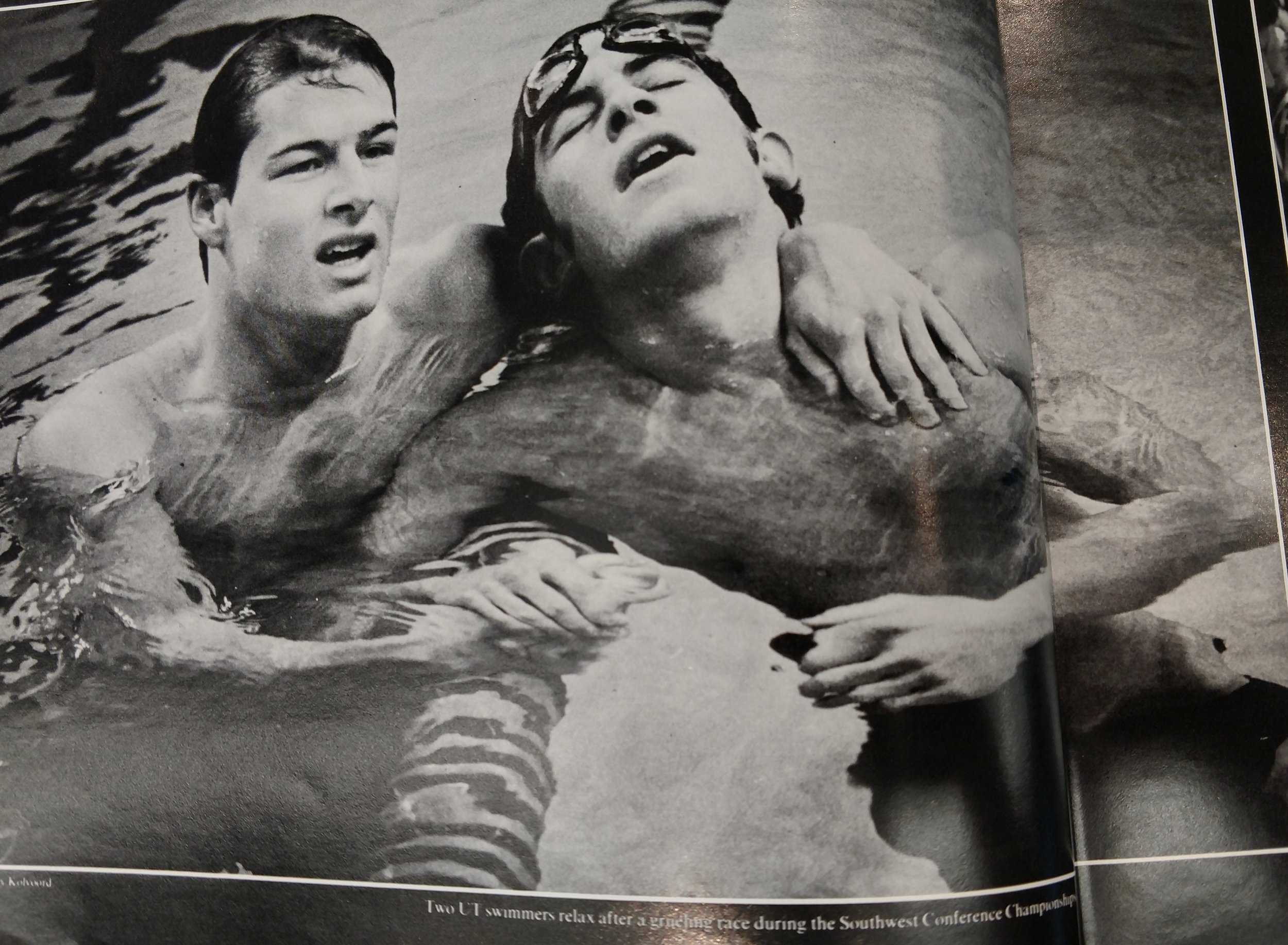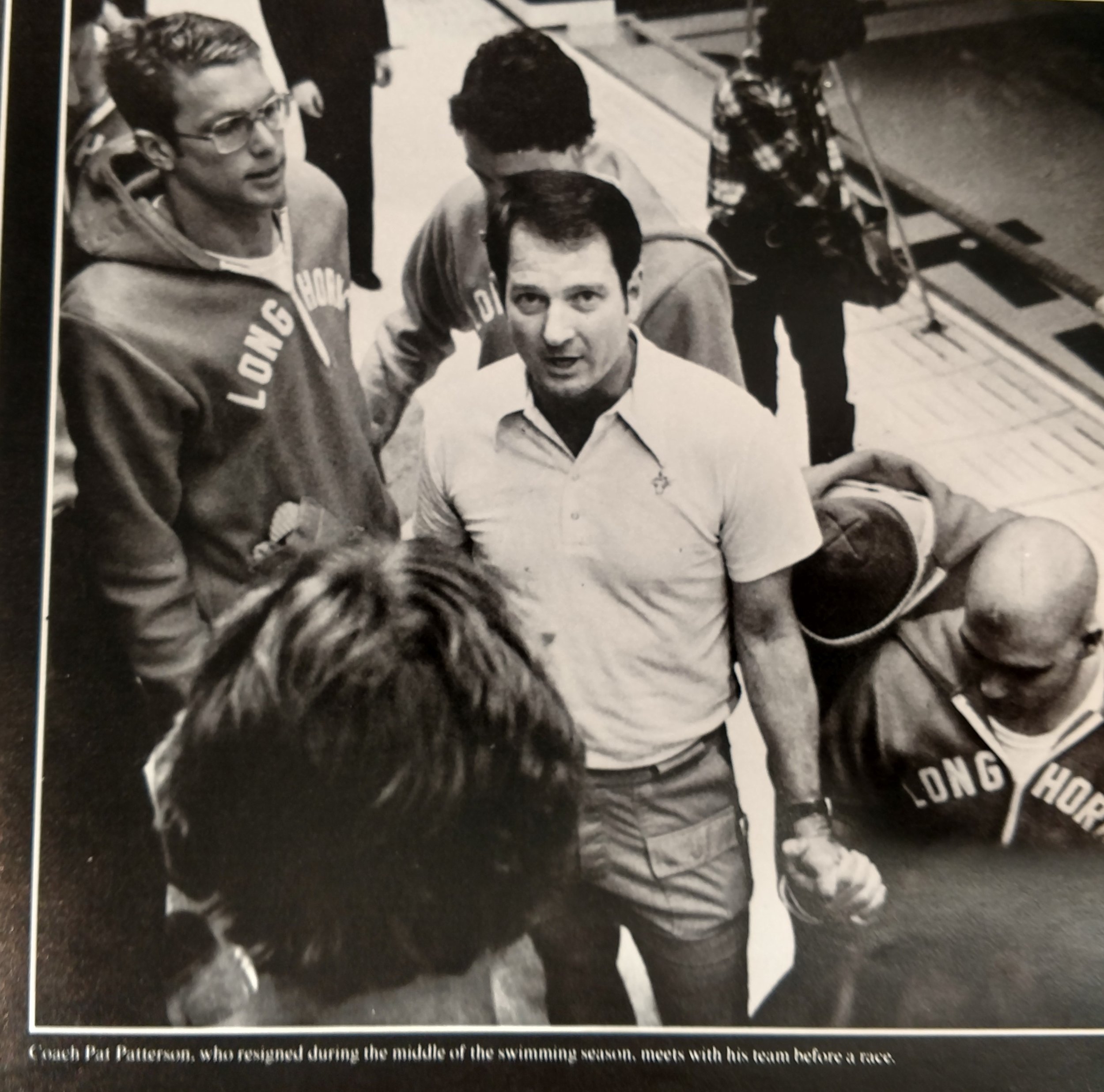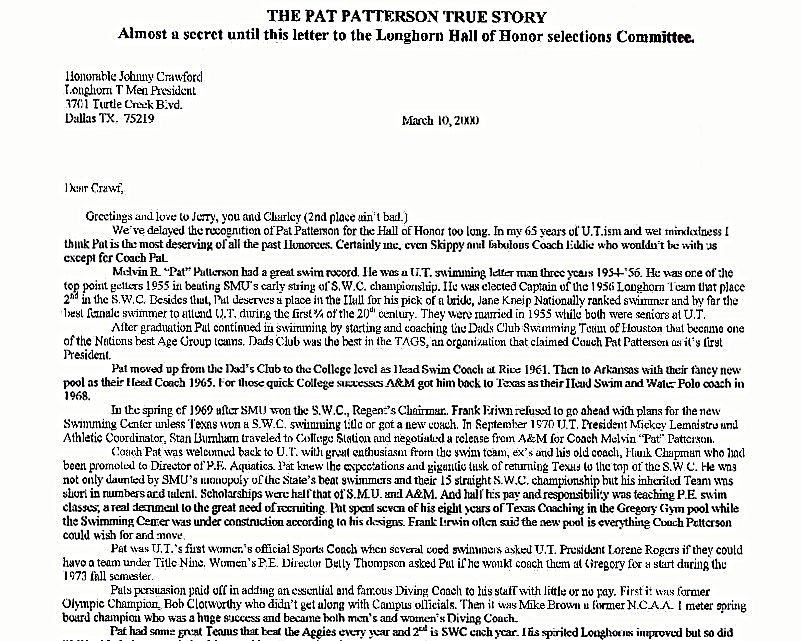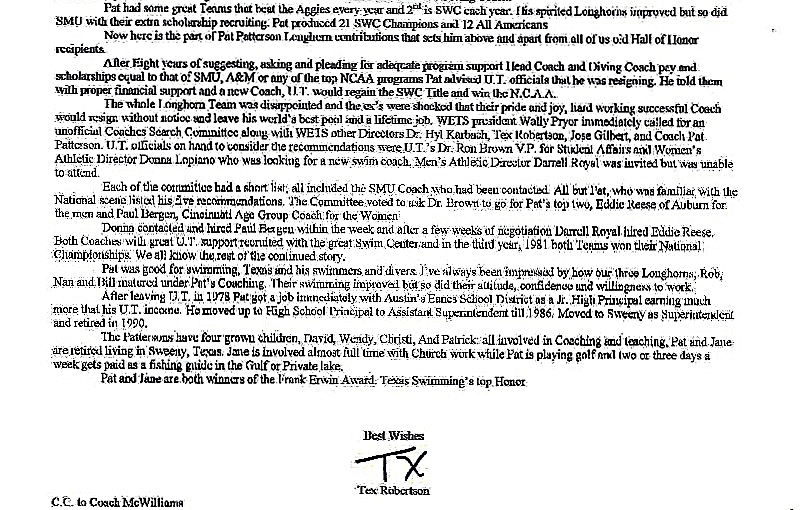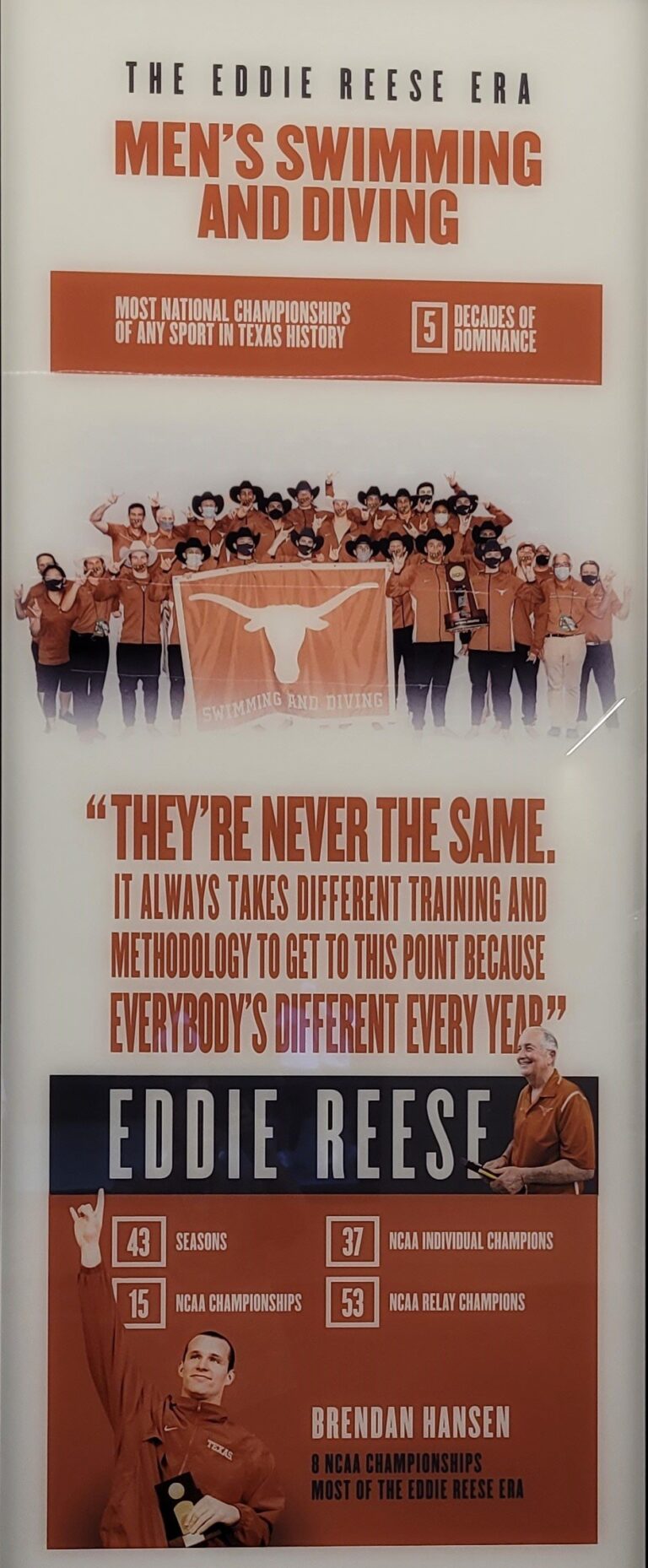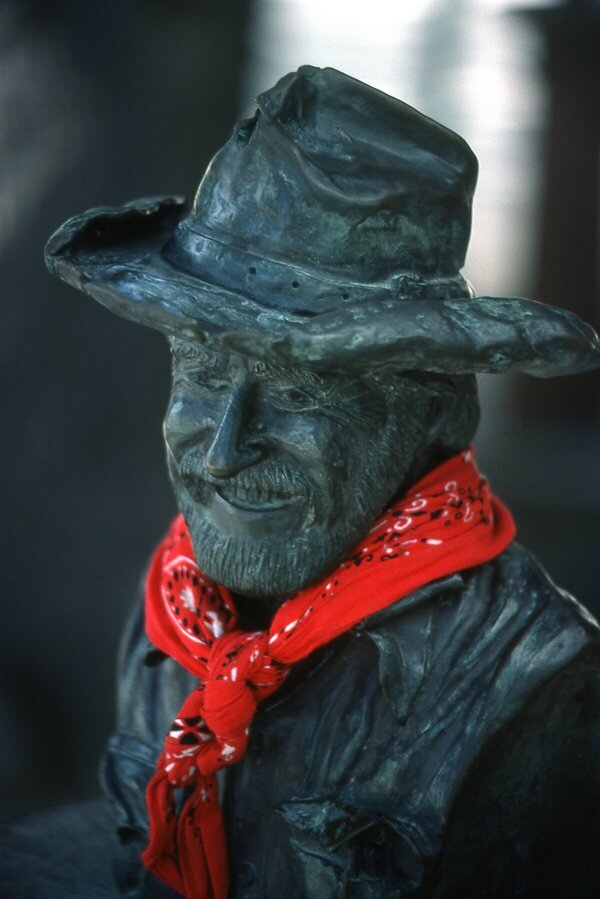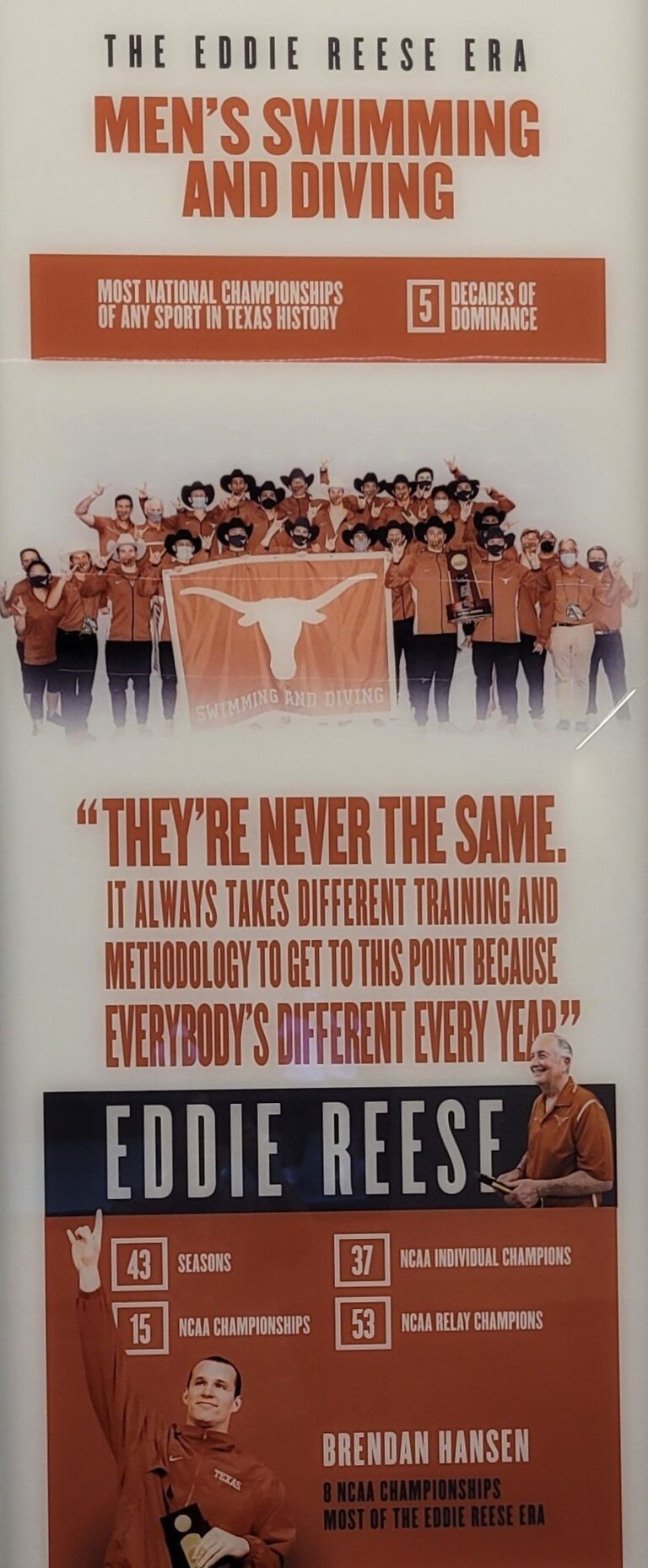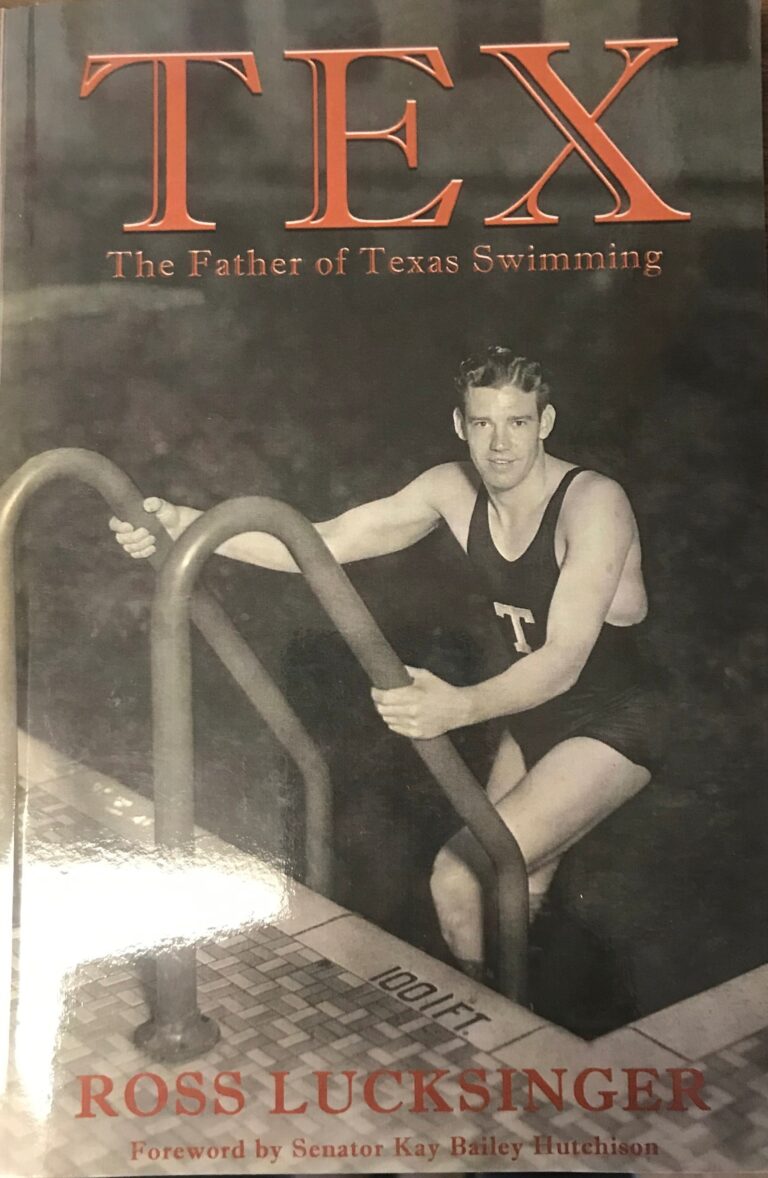1921-1957- Anna Hiss
>
“Click on the text denoted in red font on the side bar to visit other sites in this grid. ”
During Anna Hiss’s years at Texas and beyond, women were condescendingly stereotyped by advertisers, elites, professionals, and the media. These ads from the 1960s would land someone in jail in 2023. This Imagery made it very difficult for women to overcome false supposition and reach their full potential. Title IX changed all that.
Tessa Nichols states in her thesis that Anna Hiss had a “remarkable level of success during her tenure at the University of Texas.” She defends Anna Hiss from the “many scholars (who) were quick to criticize 20th-century physical educators for their traditionalist and overly protective beliefs.” Tessa says that professional criticism was made in a vacuum without giving “adequate acknowledgment to the roots of their beliefs or to the accomplishments of their programs that ultimately paved the way for Betty Thompson and Donna Lopiano.”
During Anna’s early years as “Director,” she was influenced by prominent women such as First Lady Lou Henry Hoover, who believed that women’s sports should focus on “artistry…. over Athleticism”.
The dogma of this era stated that competitive team sports were detrimental to a woman’s health. For this reason, many women and men opposed women participating in intercollegiate athletics.
Miriam Richards’s research at the Stark Center states that Anna was “steep in the nationwide philosophies of womanhood and femininity related to physical activity.” Hiss thought that competitive basketball fell outside of the parameters of a sanctioned sport for women. She felt that basketball was unfeminine and dangerous; therefore, the Hiss doctrine strove to develop and maintain basketball as merely a sport of enjoyment.
Sports that reflected her doctrine included tennis, golf, archery, swimming, and interpretive dance. For almost a century, society believed that a woman’s body should be protected from the stress of too much competition and that women’s sports should reflect “modesty and dignity.”
Her credo for women’s sports included :
-
moderate physical activity;
-
a de-emphasis on competition among women;
-
a focus on inclusive participation over individual achievement; and
-
female-run space to protect athletes from the commercialization and professionalization common in the “male model” of sports.”
In many ways, Hiss was a leader in developing women’s sports at UT, but in many other ways, she was a follower.
Women’s Sports History 1921-1957
Anna Hiss Favorite quote, “A Sport for Every Girl and every girl in a sport.”
Most of the research for Longhorn women’s sports history was derived from books written about Longhorn sports, including the “Cactus,” which has great photos of the history of Longhorn sports. All of the books used for research are listed in the credit section on this website.
In addition to these books, one study and one thesis discuss in detail the evolution of Women’s sports at the University of Texas. Miriam Richards’s writings were delivered as part of the Capstone project in 2012, and Tessa M. Nichol’s B.A. thesis written in 2007 titled Organizational Values and Women’s Sport at The University of Texas, 1918-1993 adds much-needed professional depth to the history of women’s sports at UT Austin. Tessa Nichols’s thesis is one of the first attempts by any individual to historically and empirically discuss Anna Hiss, Betty Thompson, and Donna Lopiano’s influence on Longhorn Women’s sports. Miriam Richards’s link and a summary page of Tessa Nichols’s thesis are in the credit section. Their comments are incorporated into the History of Longhorn sports on the TLSN site.
1920 Longhorn Sports
Video of women’s tennis (not Longhorns) in the 1920s.
“The suffrage movement and passage of the 19th amendment in 1920 renewed the emphasis on women’s freedoms resulting in modest gains for women in sports. The onset of the Great Depression in 1929 negated most of those gains. Millions of Americans were unemployed, and there was a push to keep women at home and out of the workforce. Not until WWII would women again enter the public sphere in large numbers. ” Quote is from a picture titled “Education and Athletics” found in the LBJ Library.
1921-1957 Anna Hiss Heads The Women’s Physical Education Department.
In 1919 and 1920, Anna Hiss supported the creation of the W.A.A., a student-led Women’s Athletic Association. Tessa Nichols states in her thesis that “the promotion of student involvement in the governing bodies of women’s collegiate sport was one of Hiss’s strongest and most commonly overlooked convictions.”
Top of the charts 1921
1921
Texas Woman’s University offered the first Texas degree program for physical education.
In Tessa Nichols’s thesis titled “Organizational Values and Women’s Sport at The University of Texas, 1918 -1992,” she states that Anna Hiss has to deal with society’s “fear of the masculinization of female athletes” Hiss’s tenets focus on “individual activity” played in moderation in a strictly female space to promote “health, fun, and sportsmanship” “without fear of sexual harm or the taint of masculinity.” “The underlying principle” for women’s sports is to “play for play’s sake.”
Hiss continues to de-emphasize team competition in the sports curriculum- specifically basketball.
Only the 20 best UT swimmers make the Turtle club.
1922
1922 Women’s World Games, held in Paris, included the first regular track and field competitions for women.
Swim Club
Anna Hiss is instrumental in forming a state physical education association for women.

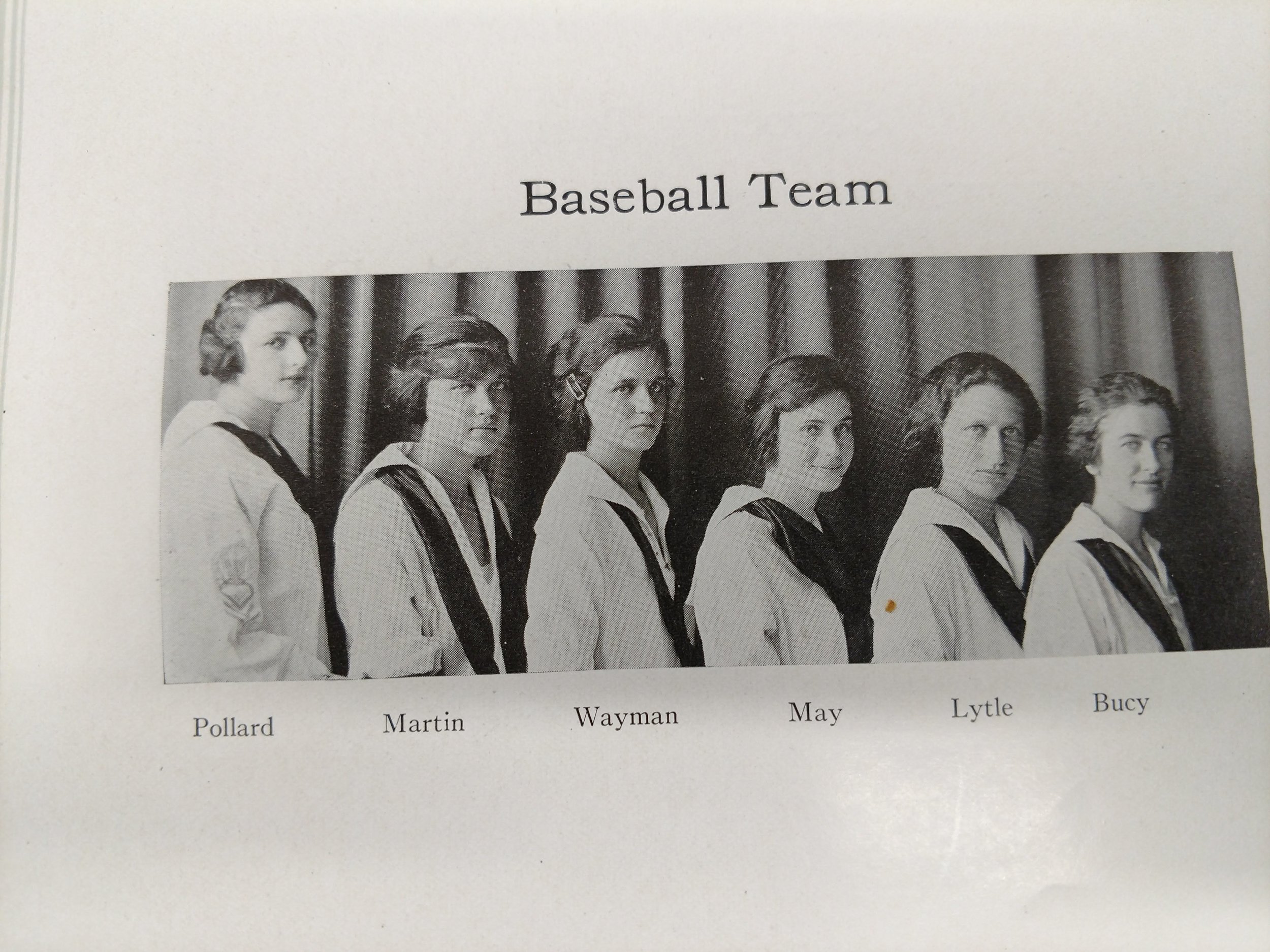
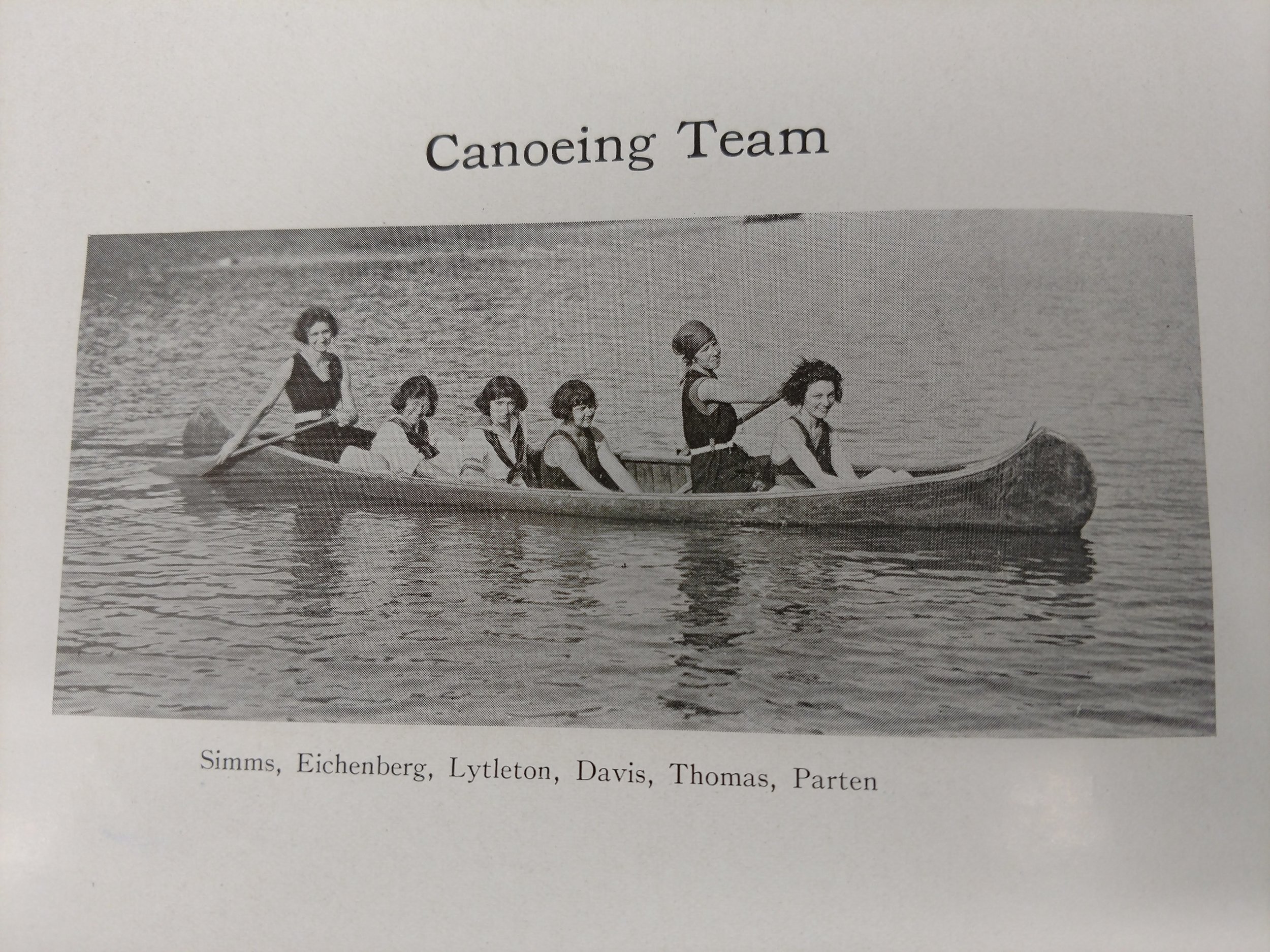
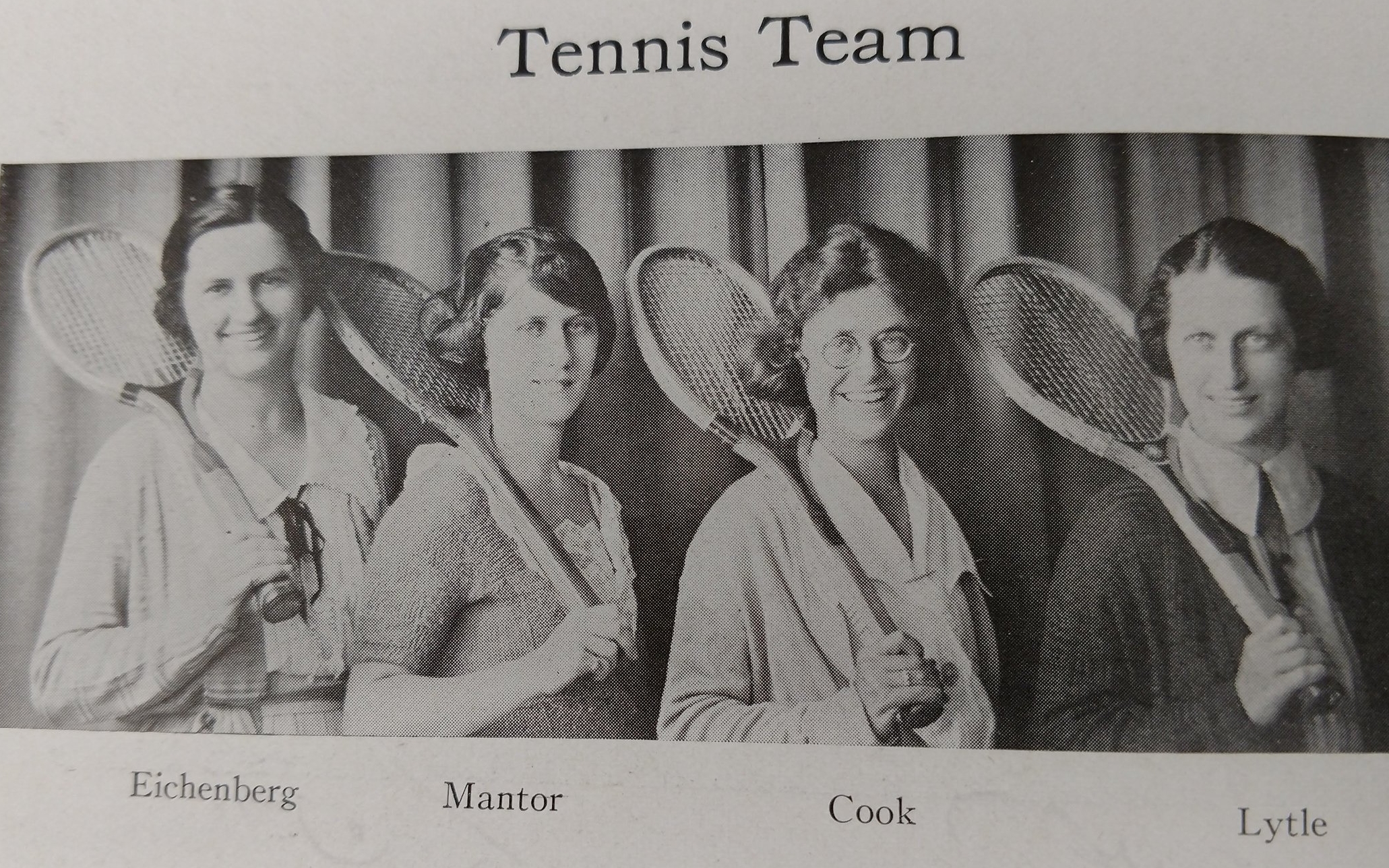
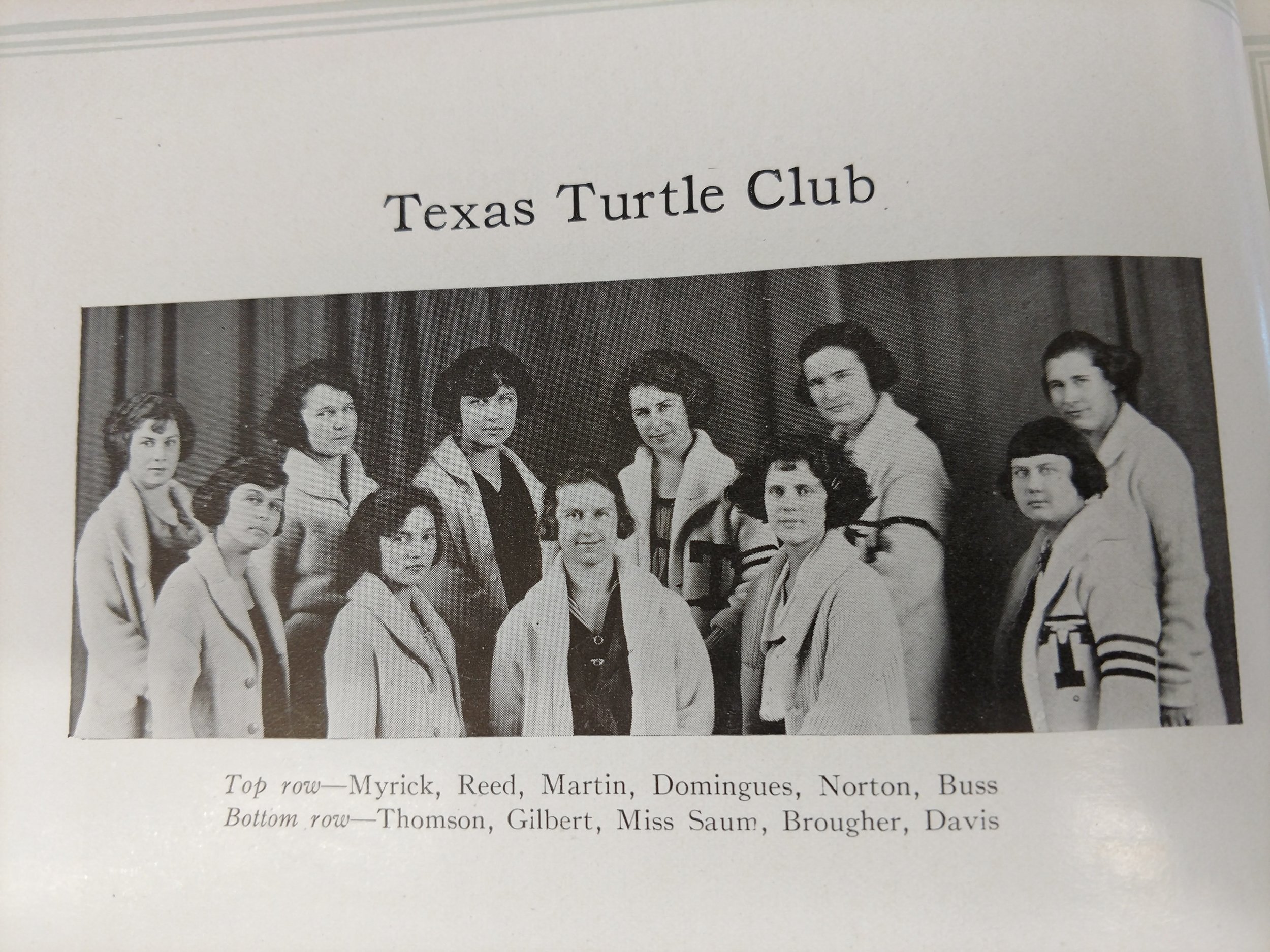
The inter-class basketball team above won the first Co-op silver-loving cup. The photos above are part of a slide show. Just click on the arrows to move forward and backward to view the images.
1923
Tennis competition is set up on a ladder system. Lower individuals on the ladder can challenge higher people. If the challenger wins, she replaces the higher-seeded individual.
1924
UT Austin creates a college of Physical Education. The Texas Athletic Conference of College Women is formed to further women’s athletic interests and activities in Texas colleges.
Tennis is the most developed major sport among the co-eds.
1925
A low point for women’s sports. The Cactus did not even cover women’s sports in 1925.
1926
PH.D. D.K. Brace is the first head of the Department of Physical Education. He develops the first Master’s and doctorate degree programs in Physical education at Texas. (data from the “History of Physical Education in Texas: an analysis of the Role of D.K. Brace.” Ph.D. dissertation , USC 1967) .
A point system is established to reward athletes for participation. 800 points were needed to receive the “T”
AAU has the first-ever national women’s basketball championship.
1928
Constitutional information of the WAA (Women’s Athletic Association)
Clubs are the primary source of inter-group sports competitions. The club’s goal is to help “girls” who complete the physical training courses enhance their skills and compete with the best anywhere. The governing body is the Women’s Athletic Association.
1928 Tennis
Golf 1928
1929-1930
The first course of study for women in physical education was implemented in high school, but the credits did not count toward admission to college.
The Texas relays feature a marathon for women only. The media promotes this event as “A race with no parallel in Texas sporting history”. No Texas Longhorn women participate in the Texas Relays marathon. Still, the fact there were Women’s Marathon runners proves that women can compete in “stressful” sporting events.
Anna convinces the University administration that UT is falling behind other major universities in developing on-campus women’s sports facilities.
Jeannie” Sampson Kamrath Gonzalez is a female tennis pioneer and an inductee into the Texas Sports Hall of Fame.
Eugenie “Jeannie” Sampson Kamrath Gonzalez
Before her first marriage to Karl Kamrath, she was invited by famed University of Texas tennis coach, Dr. D. A. Penick, to play tennis on the U.T. Varsity men’s tennis courts in 1931—the first woman player to be so honored. In 1932, 1933, and 1934, she was a finalist at the fledgling Houston Invitation Tennis Tournament, which became the River Oaks Invitational Tennis Tournament—now the USTA Clay Court Championships. Upon moving permanently to Houston in 1937, she was the first to teach tennis professionally at the Houston Country Club and River Oaks Country Club, starting an active junior program.
1931 and 1932
two new Campus gyms have been completed
1931 – Judge Kenesaw Mountain Landis banned women from professional baseball in America. He felt that he needed to after a seventeen-year-old pitcher, Virne Beatrice “Jackie” Mitchell, struck out Babe Ruth and Lou Gehrig in an exhibition game.
Gregory Gym for men’s and Women’s gyms is completed. In addition, Anna’s physical training department was moved to the College of Arts and Sciences, and the U.T.S.A. (University of Texas Sports Association) was formed.
The Women’s Gymnasium was built during the depression to support the physical well-being of up to 3500 women. Hiss was crucial in planning its construction, having traveled around the country to examine existing gymnasiums. The women’s Gym was completed for $400,000, and the facility included squash, handball, basketball courts, dance studios, an archery range, a large swimming pool, and faculty offices.
Hiss intentionally built undersized basketball courts to discourage spectators from watching and positioned the baskets directly on the wall to keep athletes from playing out of control. The Women’s Gymnasium is “Considered one of Anna Hiss’s lasting achievements and a model facility during its day.”
Slide show below click on arrows to move forward and backward to view images.
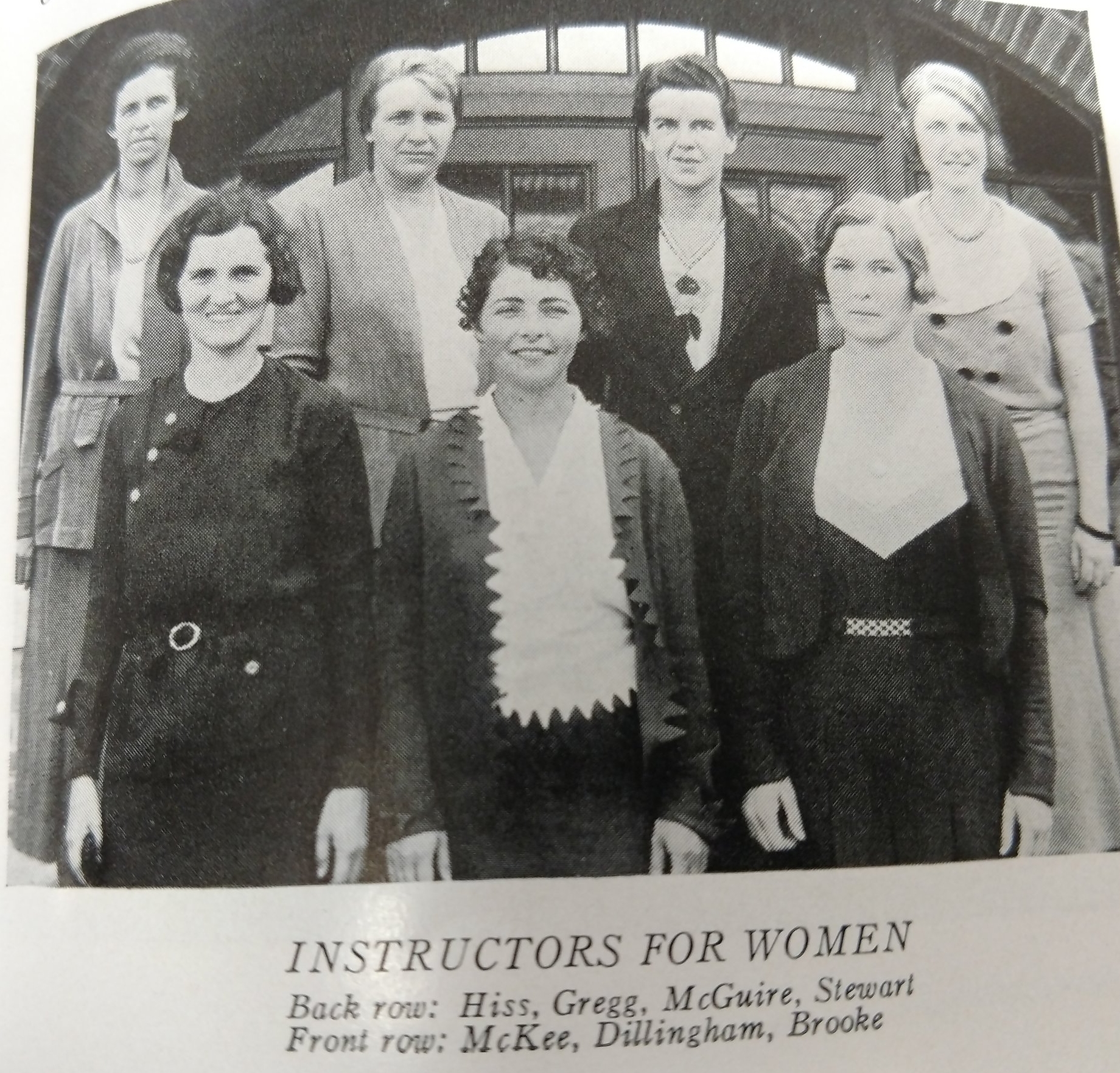
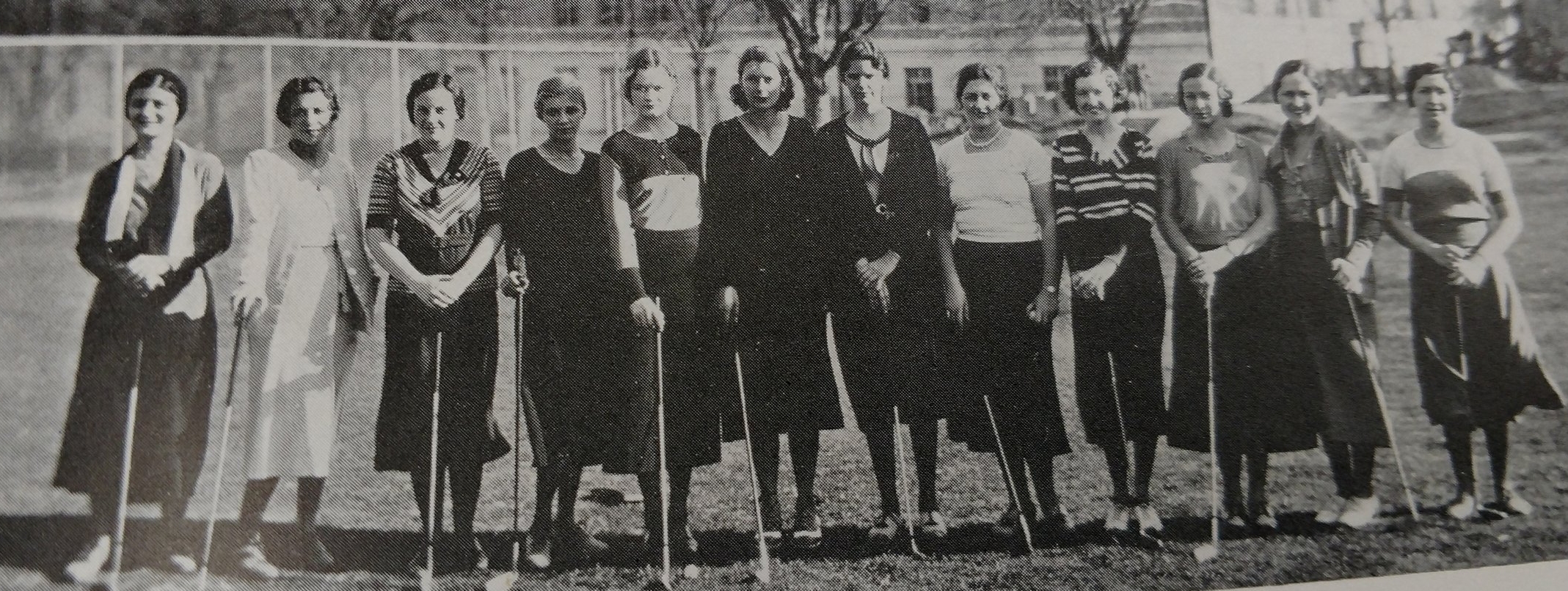
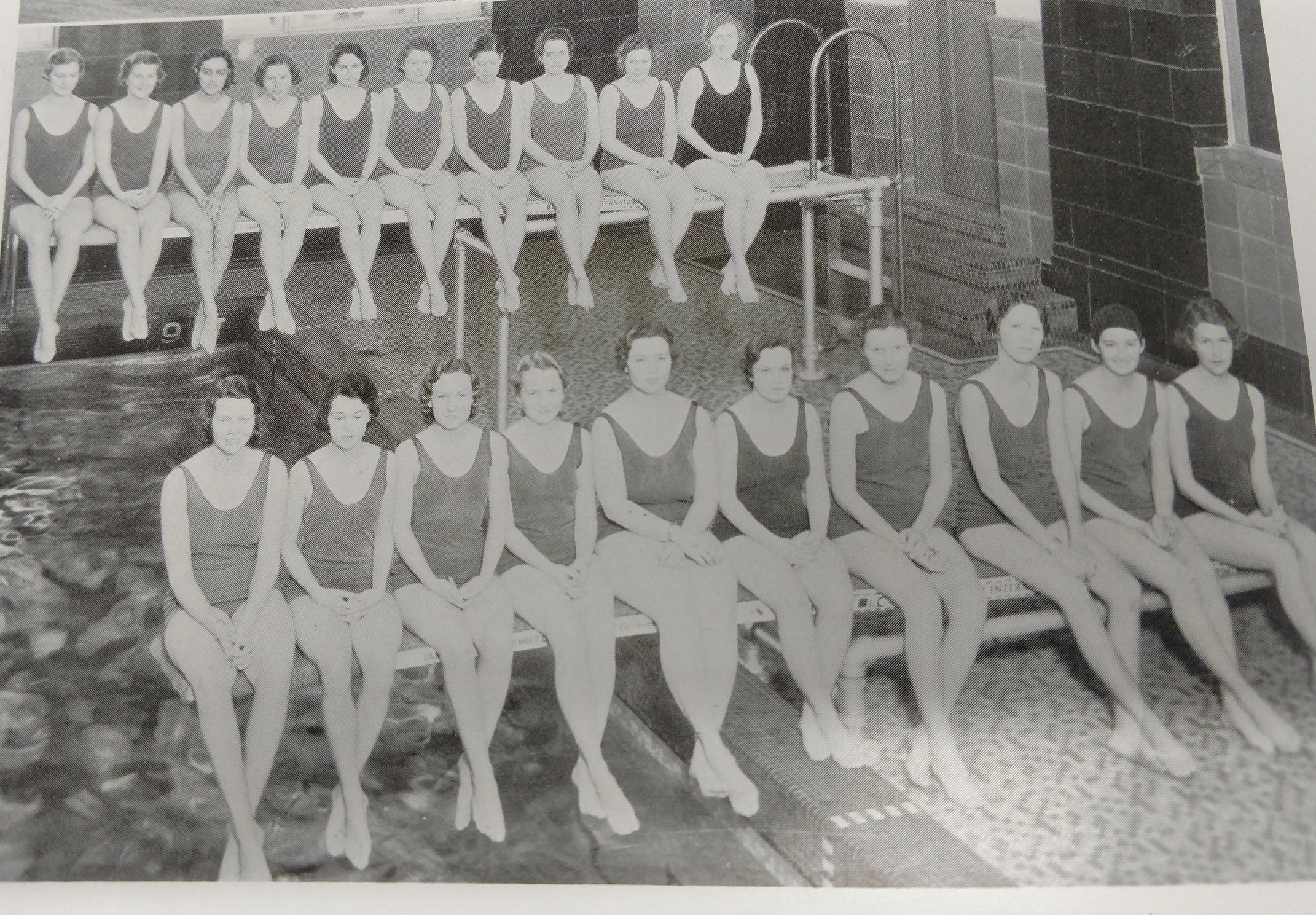
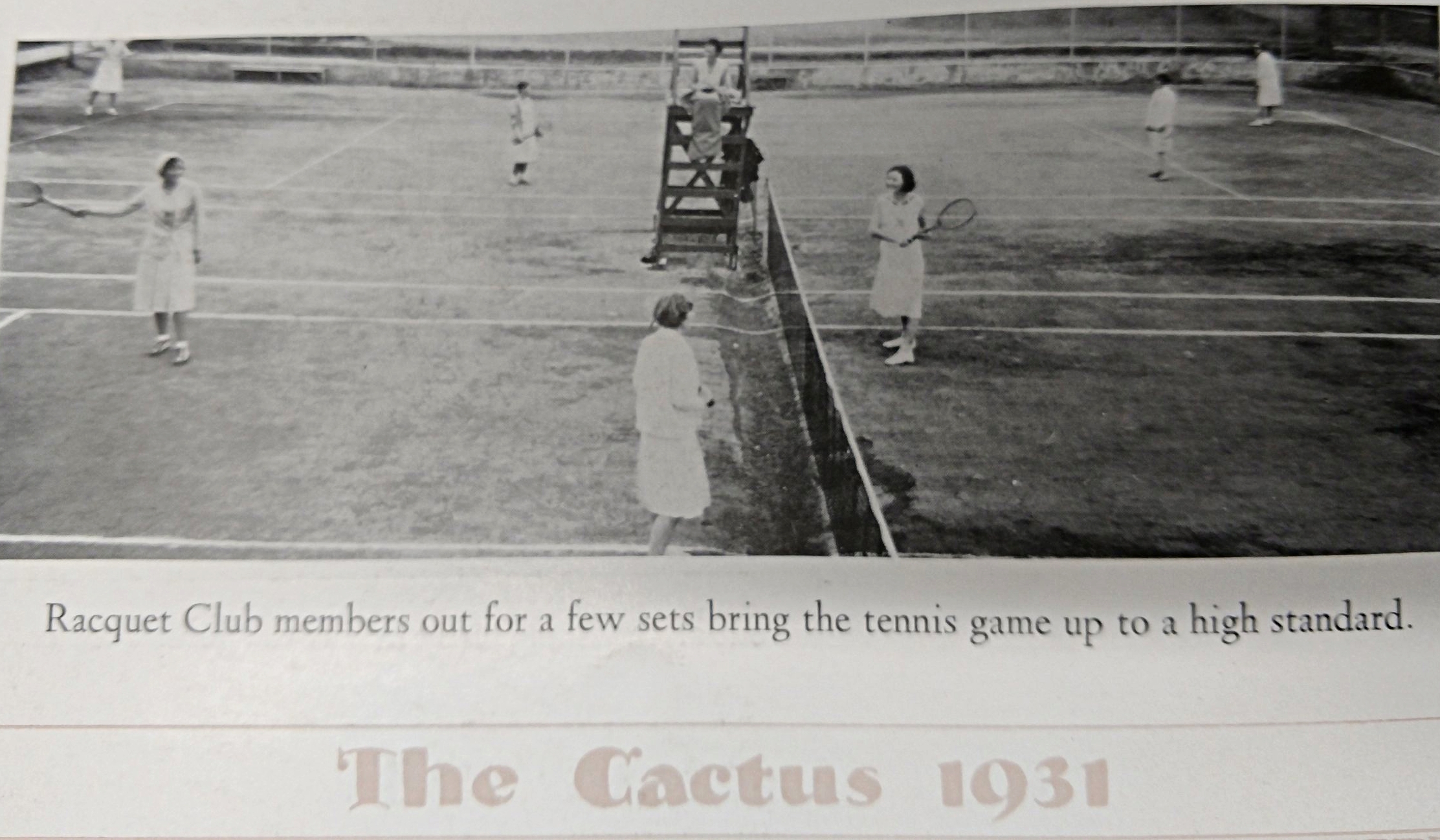
Daniel Allen Penick, a distant cousin to Harvey Penick, is the first official Women’s Tennis Coach at Texas.
Top of the charts in 1931
Anna Hiss asked the Regents to budget the women’s intramural budget with the same per capita formula as the men’s intramrual budget.
1933- 1935 is A significant year in the history of UT women’s sports
In 1933 Anna Hiss convinces the Board of Regents to add a dues-paying women’s club sports program to the College of Physical activities. The letter is below.
The Sports Clubs
-
Turtle club was formed in 1920 and is the oldest and largest club.
-
Racquet Club-Tennis
-
Tee-golf club started in 1929
-
Archery
-
Touche- fencing
-
Poona- badminton
-
Strike and Spare- bowling
-
tumbling
-
Triggerettte- riflery
-
Canter- riding
1934
Women athletes are graded on an individual health record with grades A-E.
In addition, the women’s sports programs also include baseball, track, basketball, long-distance hiking, rowing, and horseback riding.
Tessa Nichols states in her thesis that Hiss “stepped out in a new direction that had not been previously tested at other universities.” The reason for the change is to “create more opportunity for advanced skill development in a “club” environment. While Hiss supported the Sports Club format, her lack of record-keeping for the Club speaks volumes of her innate beliefs that “serious female athletes were still a highly transgressive concept nationwide.”
For this reason, Anna Hiss chooses not to record the history of skilled members of the “club” format. This decision deprives the University of Texas of an opportunity to celebrate great women Longhorn athletes from this era. Their unrecorded stories have created a major void in the history of women’s sports at the University of Texas.
The addition of the Sports Club results in a necessary split from UT Austin intramurals. Longhorns Woman’s intramurals continue to develop an organizational structure based on competition between sororities, dormitories, and independent groups with awards and honors presented at the “T” banquet.
1935
Women’s intramurals include tennis, deck tennis, ping pong, archery, golf, swimming, baseball, basketball, and hockey. From 1931 – 1935 the number of participants has grown 10-fold for a total of 3000 women entering tournament play. Most participants come from sororities, dormitories, and independent groups. Awards for winning were distributed at a “T-night banquet in May.
A swimming slide show is below.
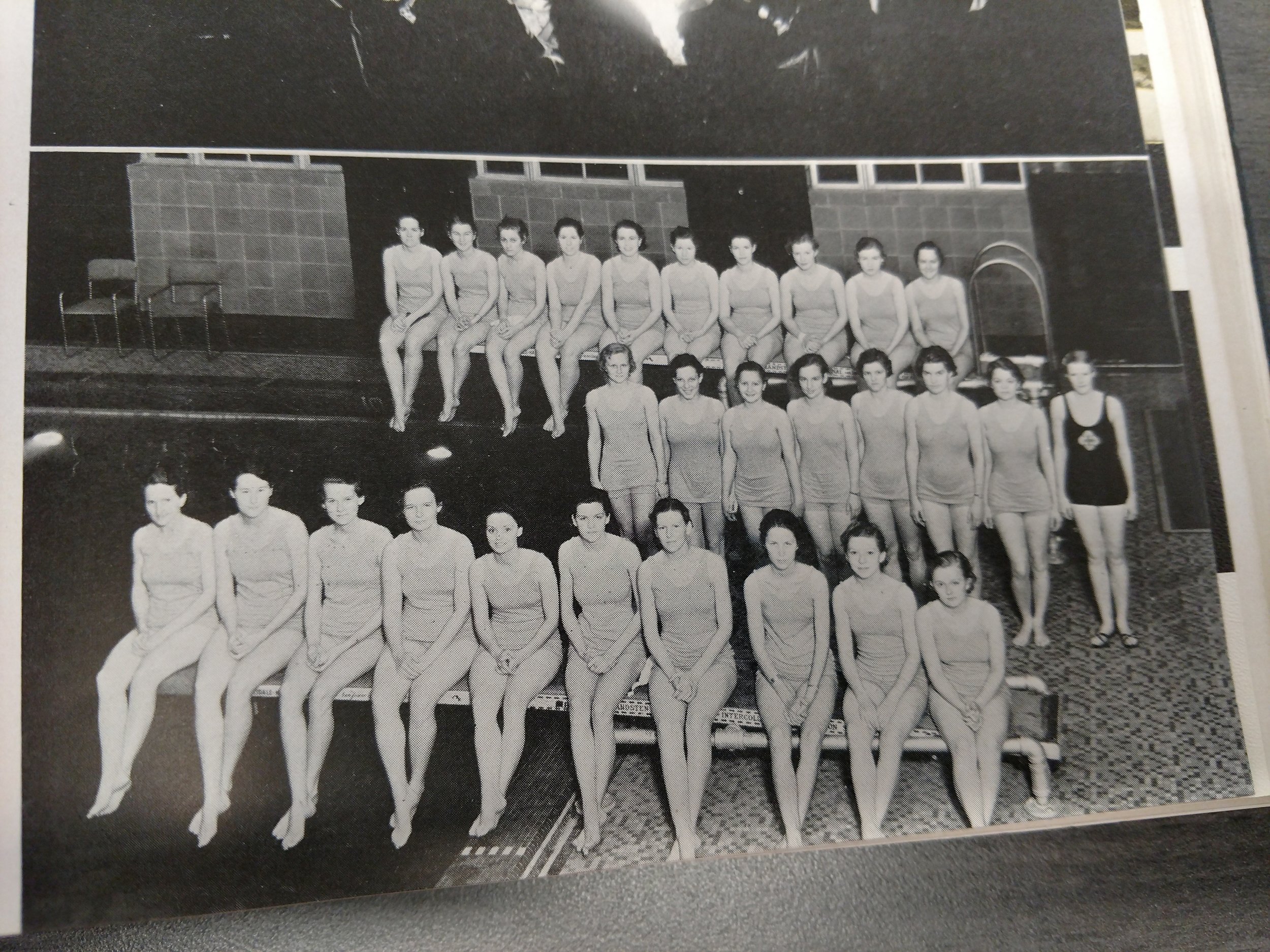
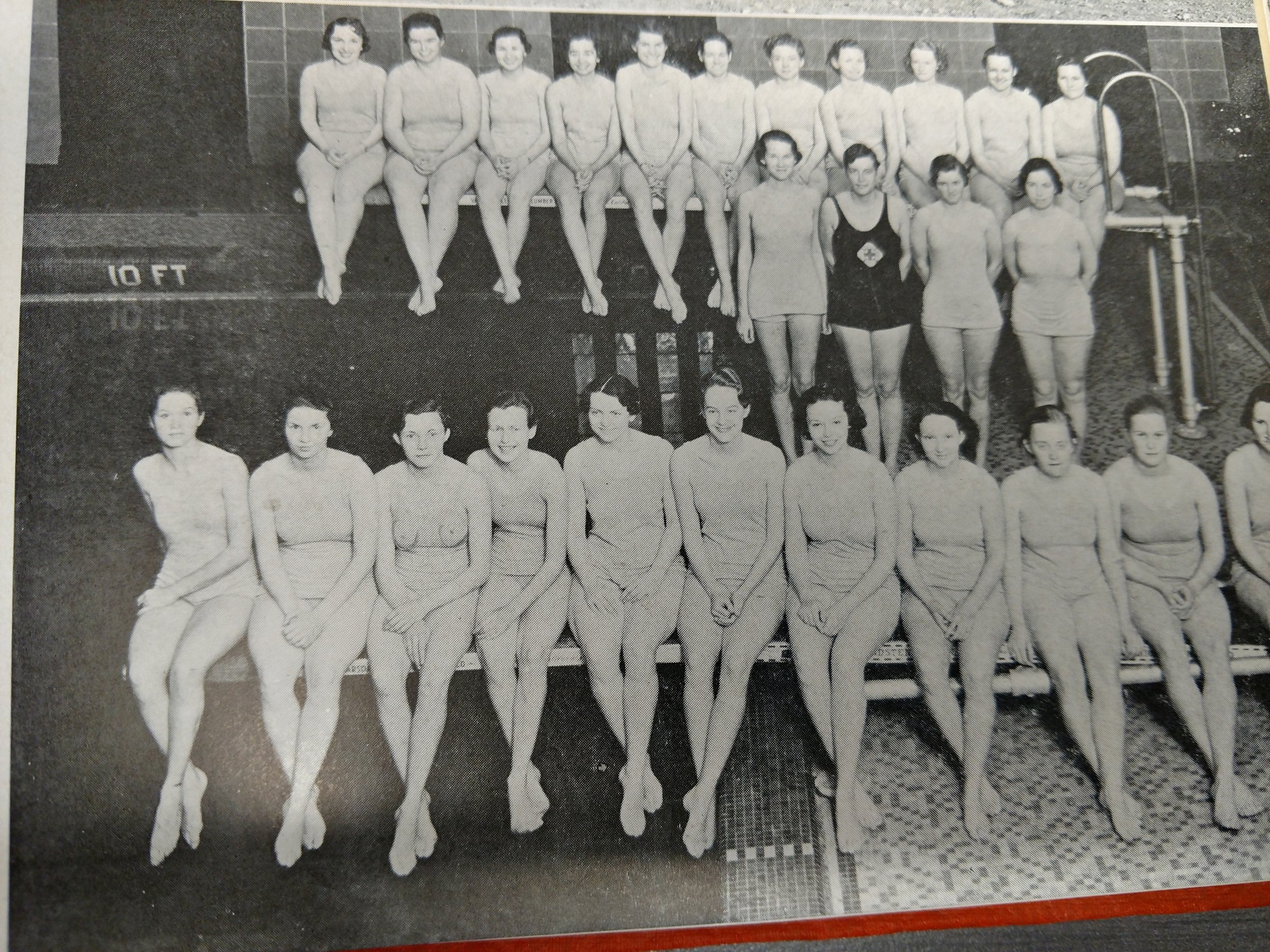
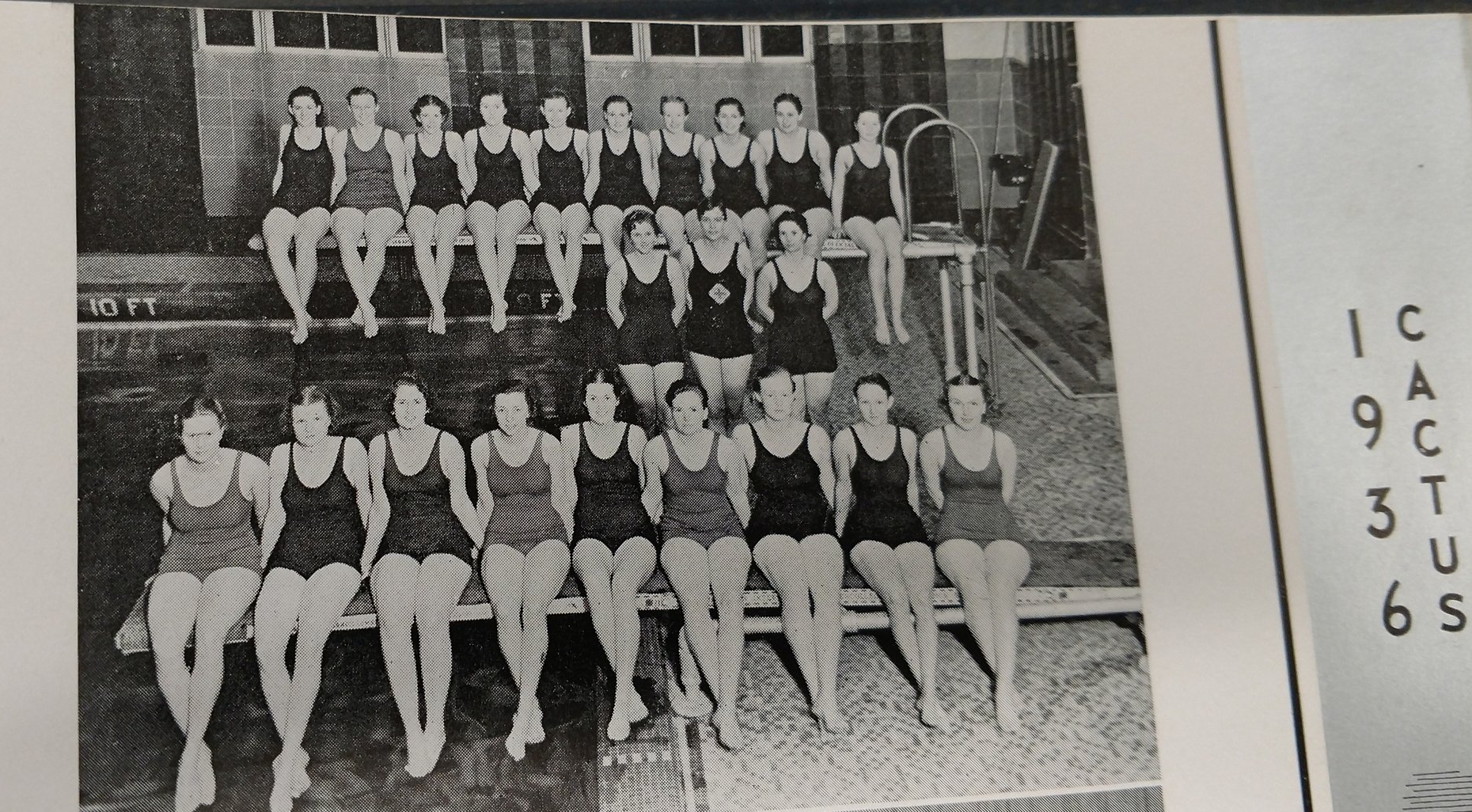
1936
However, The University Board of Regents member Jane Weinert Blumberg does not remember P.E. as being relevant to athletics. She says in the book “Texas Our Texas” compiled and edited by Bryan A. Garner
Physical education seemed almost unrelated to athletics to some of us. One semester I called sleeping PE course required me to get up in the morning, dress go to the women’s gym, undress and go back to bed for an hour. I wasn’t dissatisfied as sleeping was preferable to disporting myself and green rompers on the field next to the engineering building . The next year I took an archery class and it was enjoyable.
In 1936 Tex Robertson raised money for the UT men’s swim team by charging admission to attend a traveling aquatic show and a beauty pageant. (no women’s swim team in 1936.)
1937
Tessa Nichols states in her thesis that “physical educators” abhorred the emergence of women’s city and industrial sports leagues because ” they were run by men, who emphasized intense competition….., and were produced for economic profit.” Cahn says, “They” (physical educators) classified the industrial and city leagues – composed of “…. working-class, rural, and black youth clubs, industrial, and semiprofessional athletics – as unladylike and unnatural for women”. Hiss’s definition of ladylike in female sports champions the “middle class,” not the formation of industrial and city leagues.
Hiss published an article titled Girls Basketball Leagues; What About Them -and Our Responsibilities. According to Tessa Nichols, Hiss wants to reshape the women’s city and industrial leagues to conform to the Universiti’s definition of women’s sports. Hiss “urged her colleagues to pursue involvement and opportunities of affiliation that would enable us to assist in these league tournaments” Hiss’s goal is to “infuse leagues with optimal standards” and “minimize exploitation of women by men.”
Incredibly, Hiss decides to add a “posture” contest to the portfolio of women sports.
1937 Betty Jameson enters UT, and Harvey Penick gives her golf instruction. Betty is the first woman to ever qualify for a men’s varsity high school golf team in the state of Texas. In 1938 Betty Jameson wins the intramural golf championship at Texas.
Betty Jameson and three other women from the LPGA are the first induction class to the LPGA Hall of Fame.
1937-1938
Jane Dillard trains with Tex Robertson and sets the American and world records in the 100 breaststrokes.
A slide show of Longhorn women sports is below.
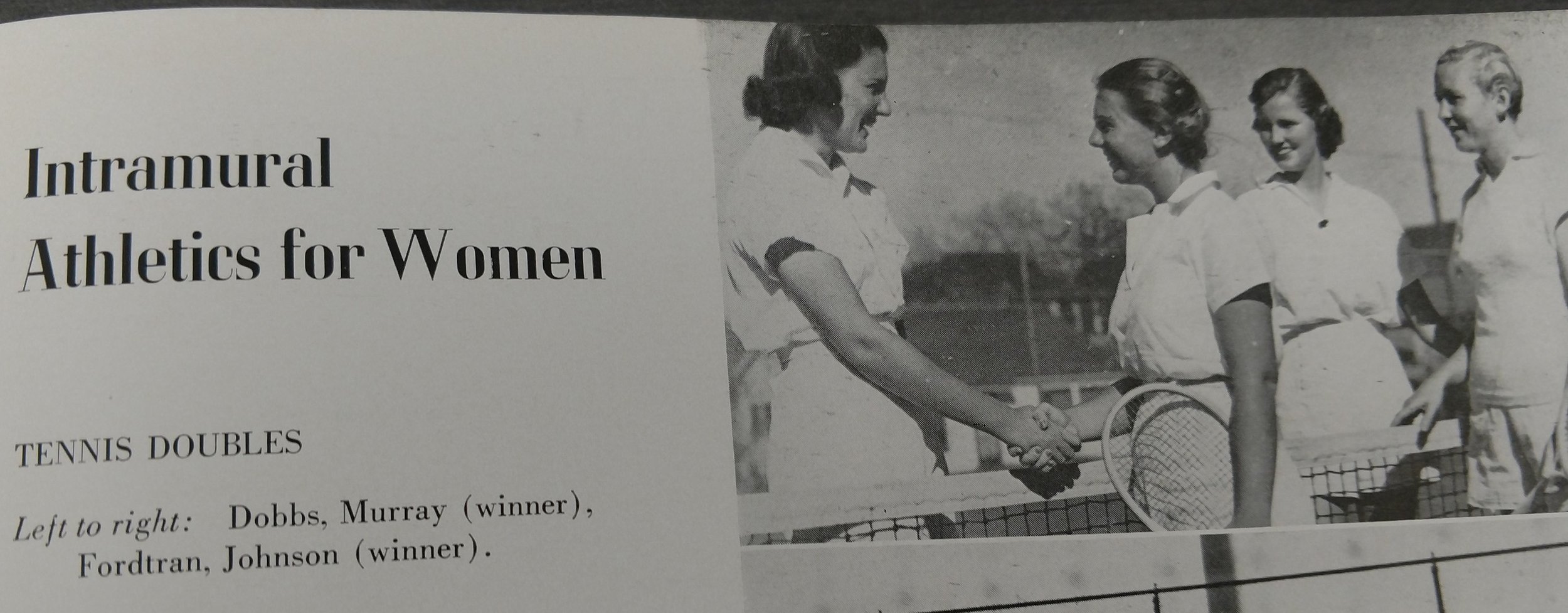
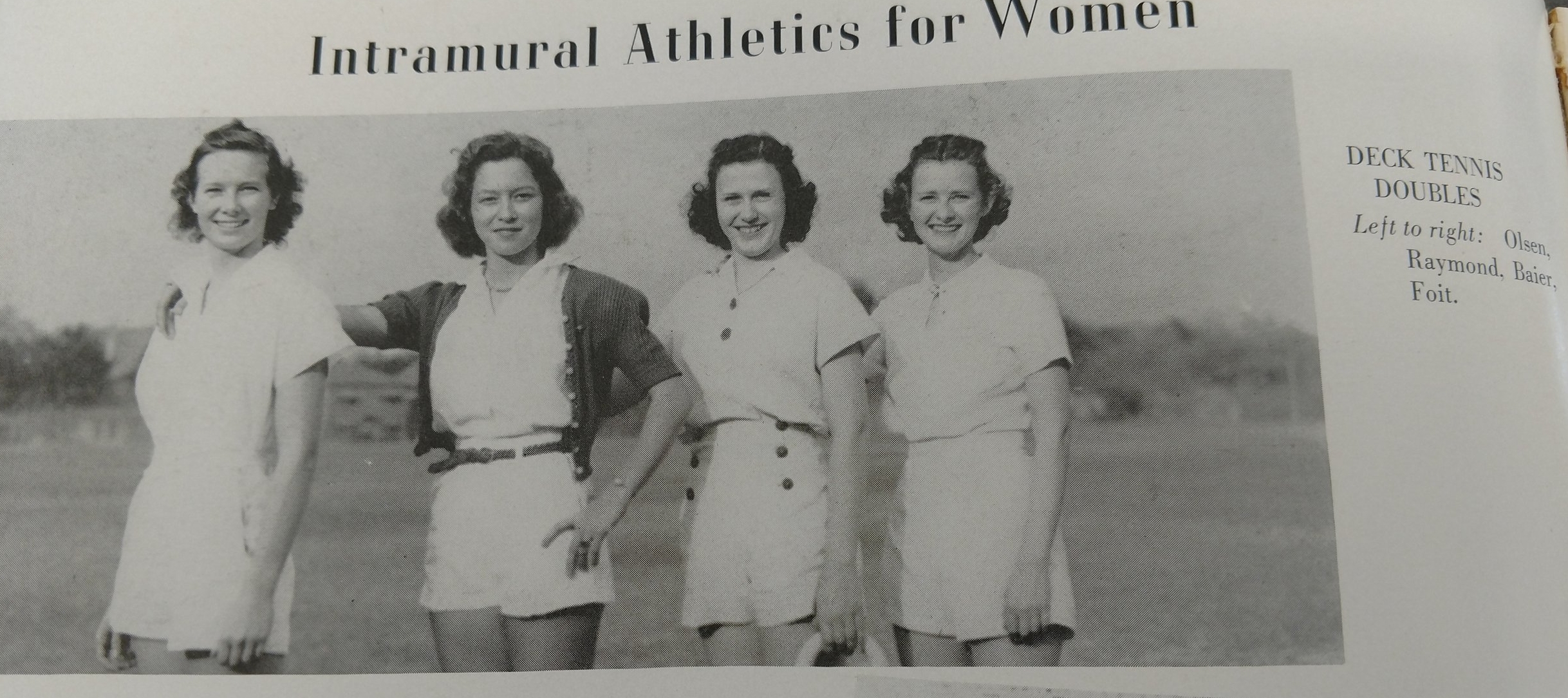
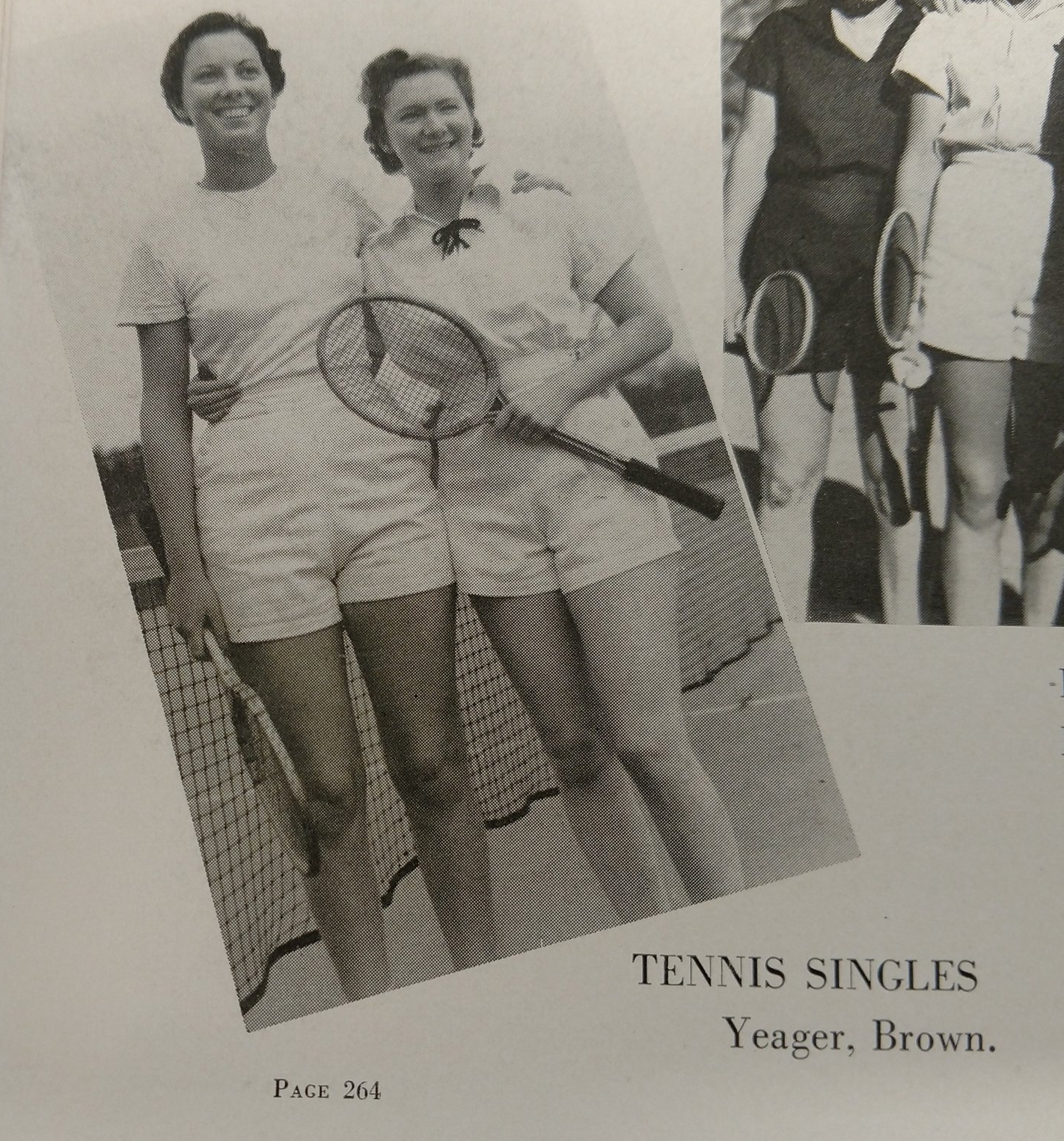
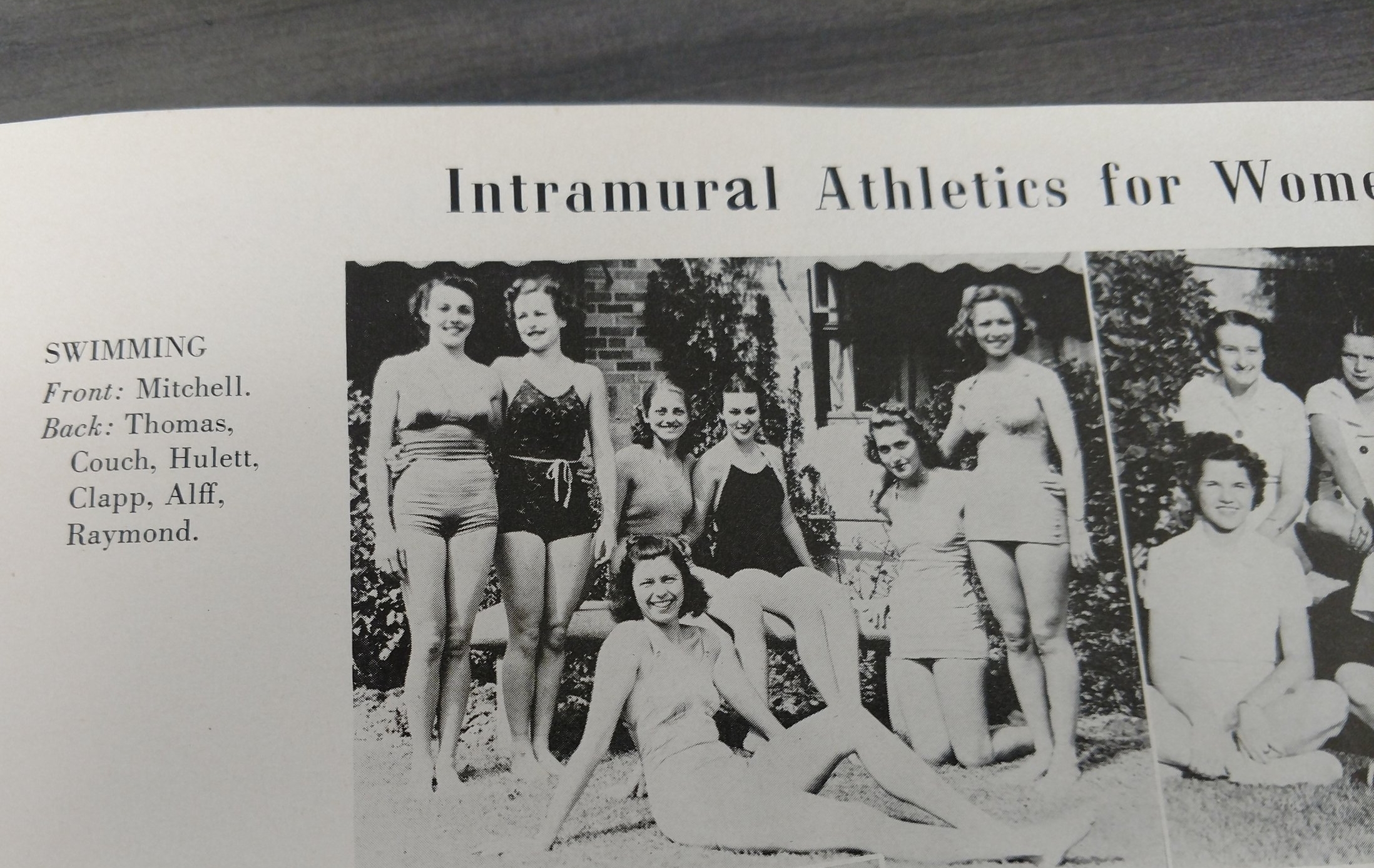
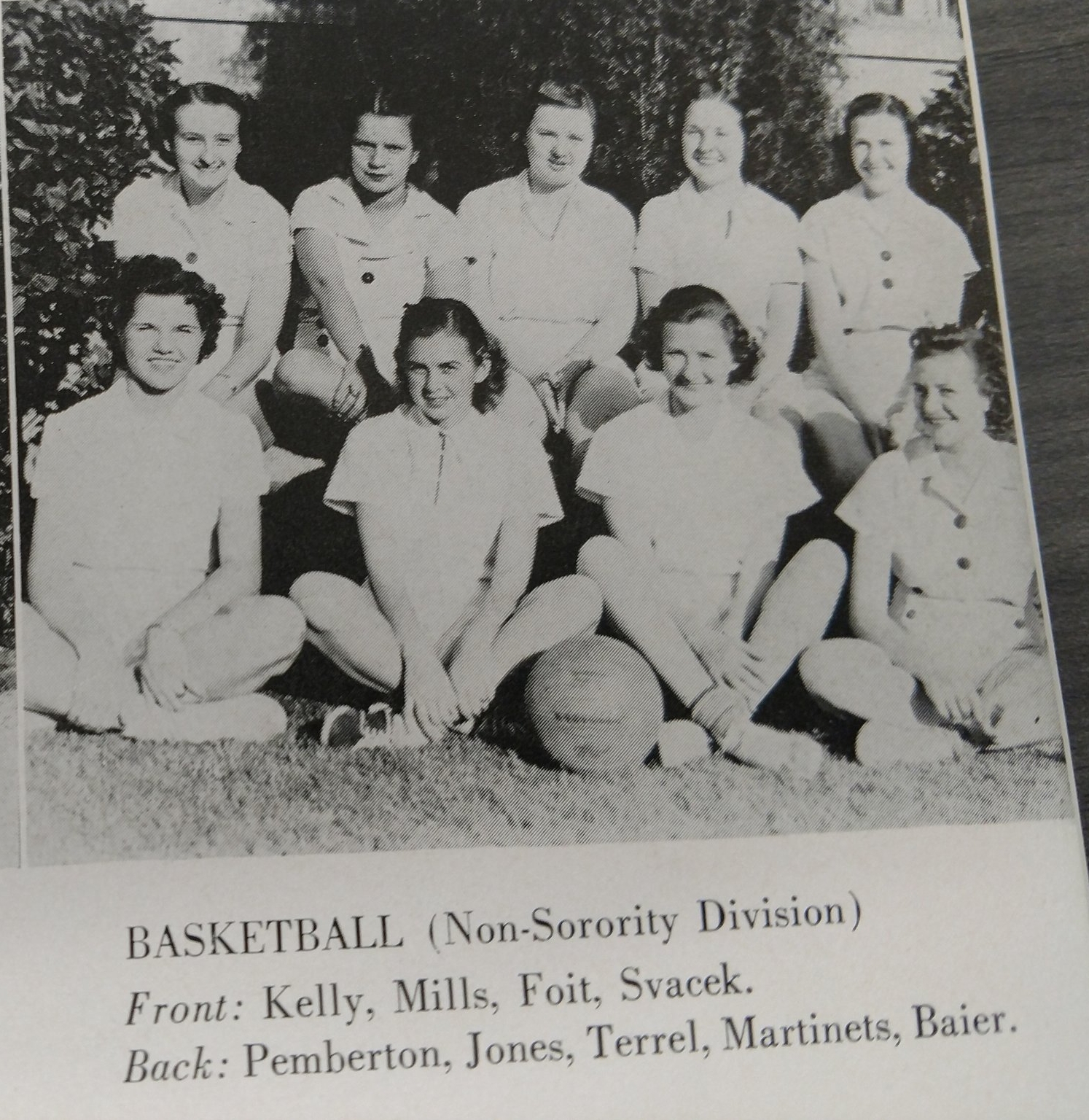
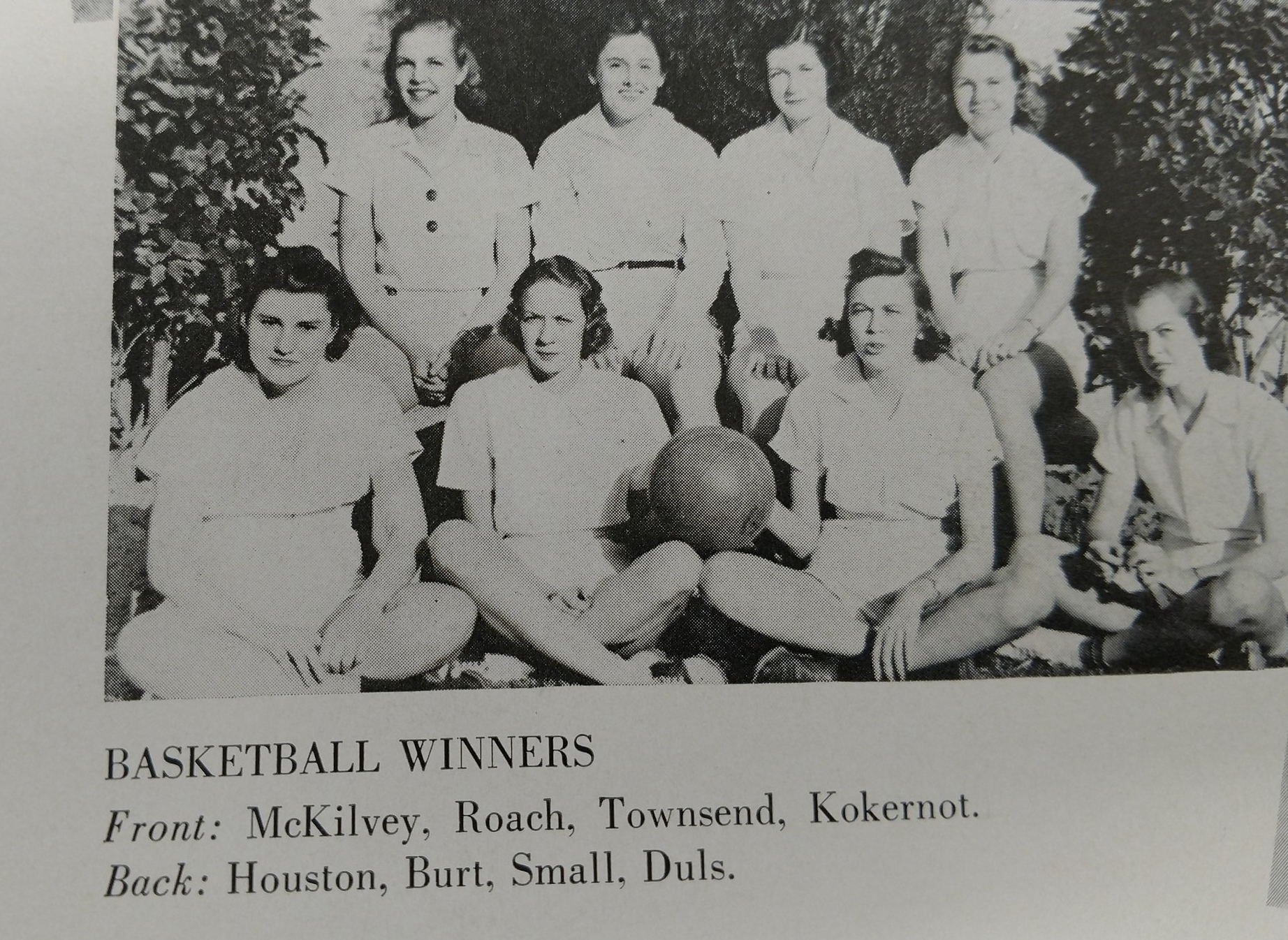
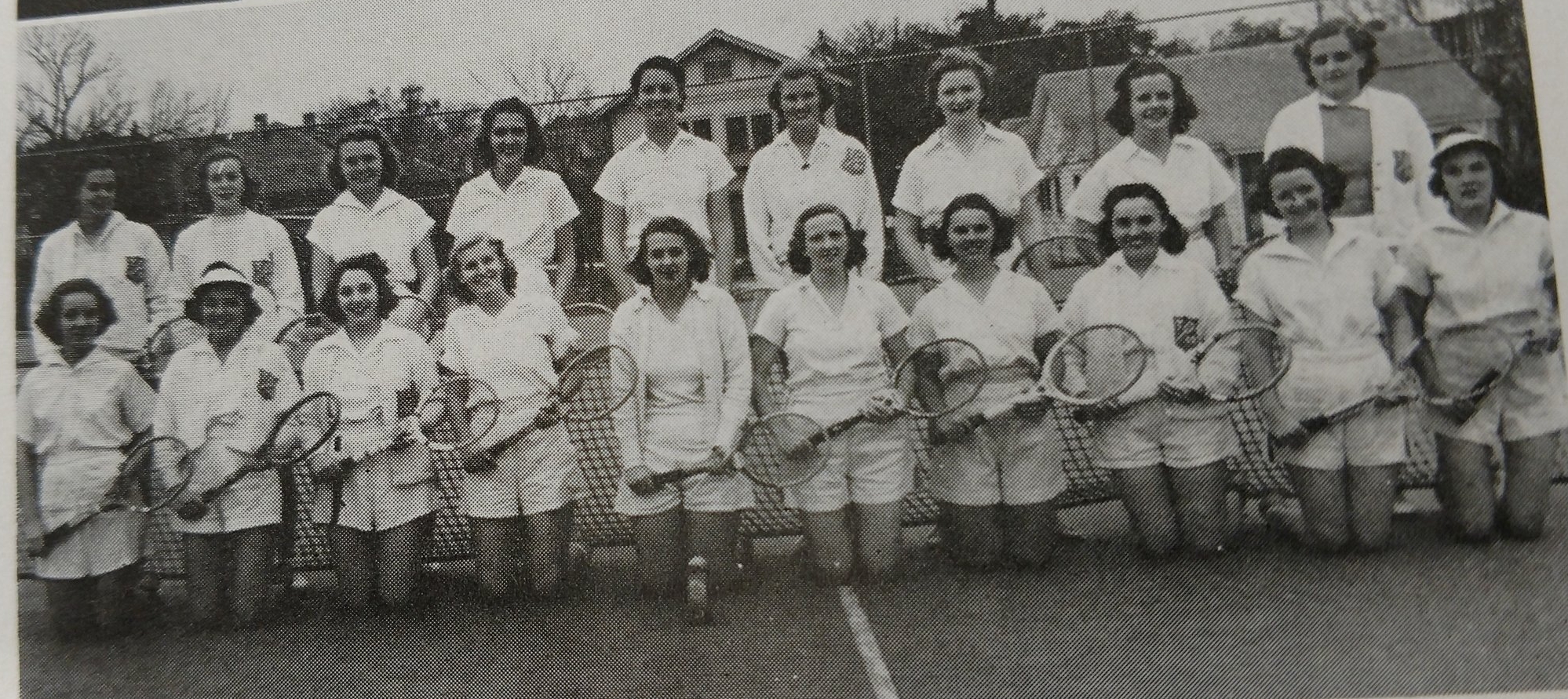
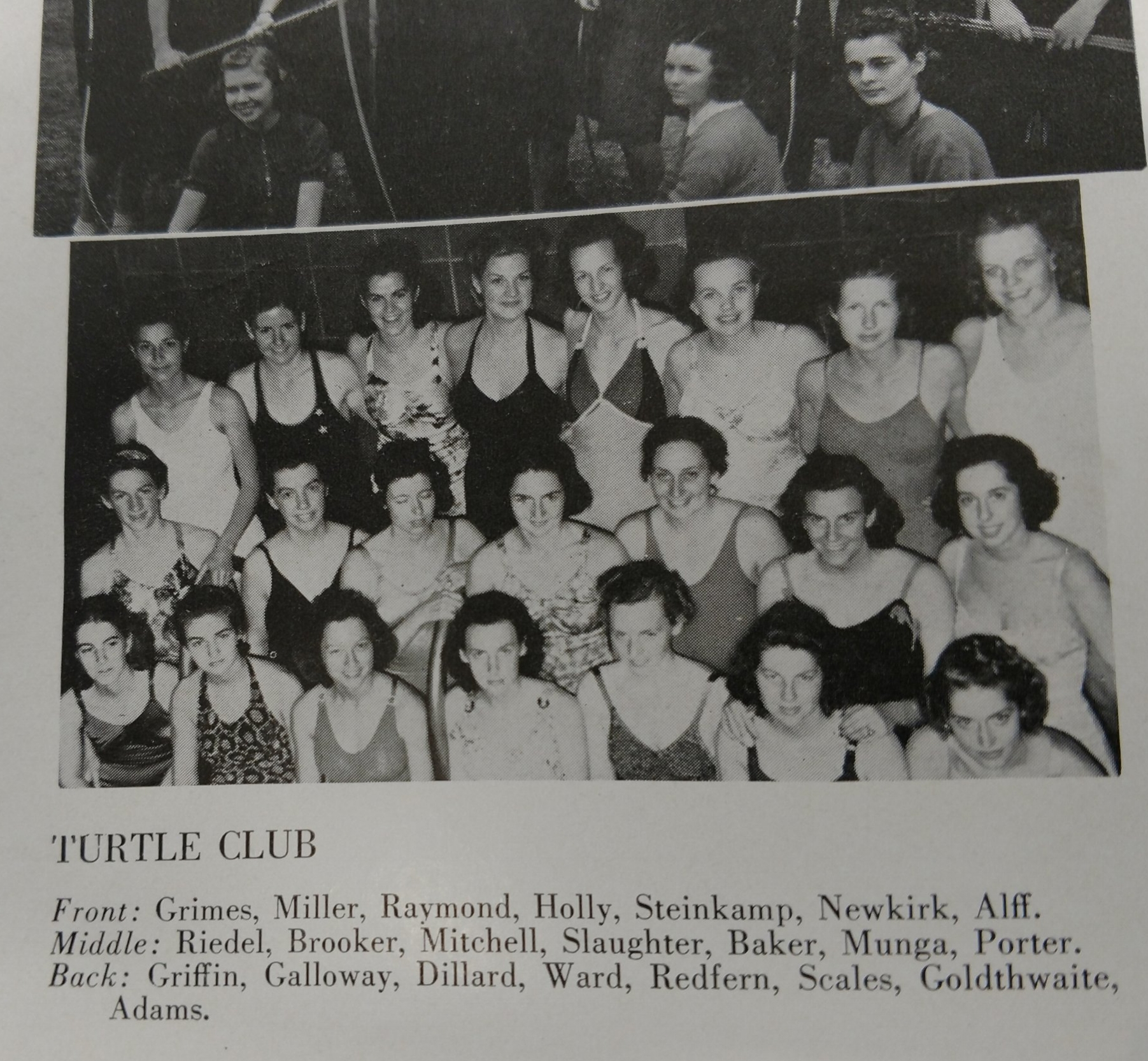
1940’s
Basketball champs
1940’s- Recreational programs continue to expand. Intramural champions are crowned in multiple sports, and various club teams are available.
1943 – Women’s professional baseball replaced men’s professional baseball during the war
1945 Trophy Night for women
University of Texas Sports Association
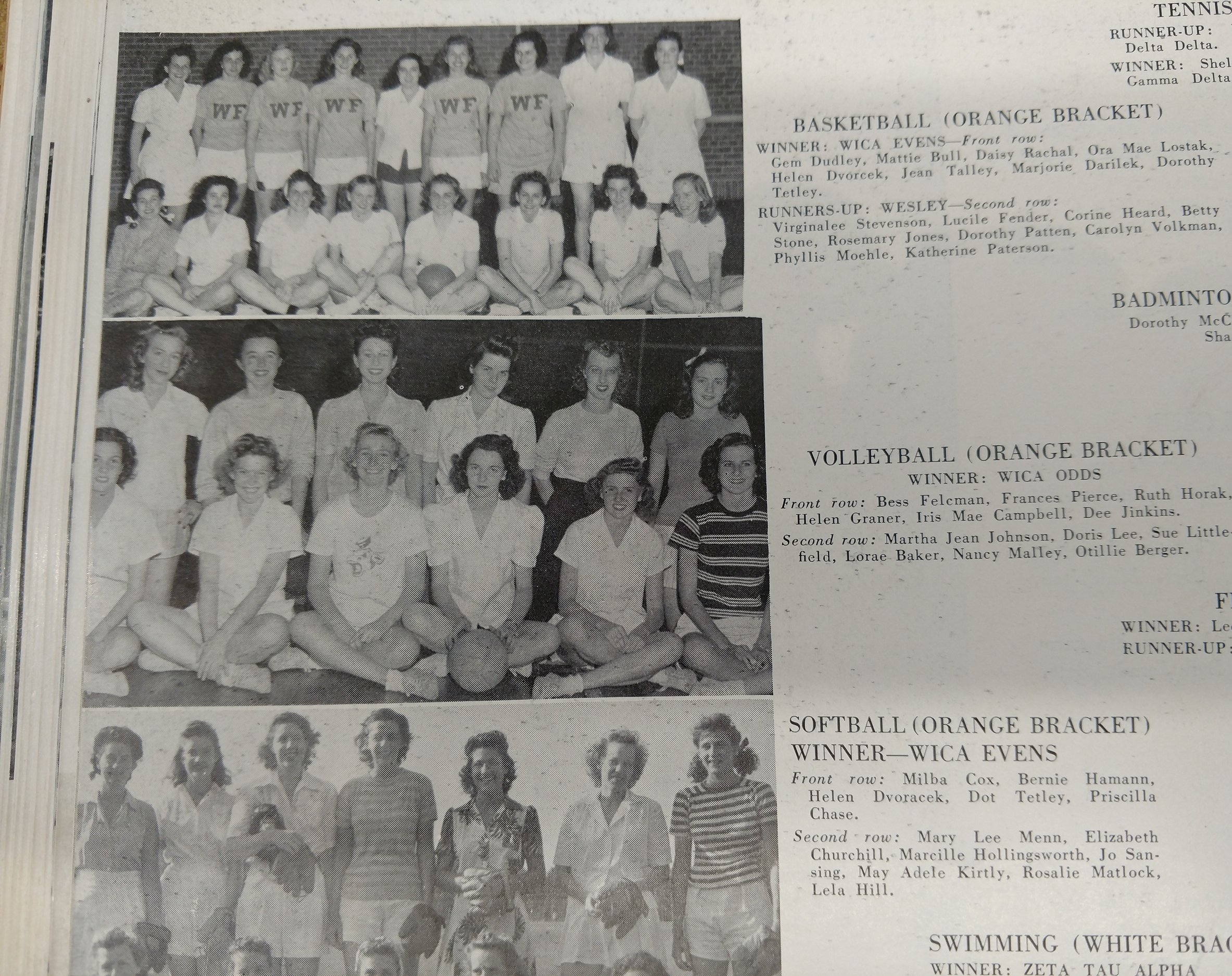
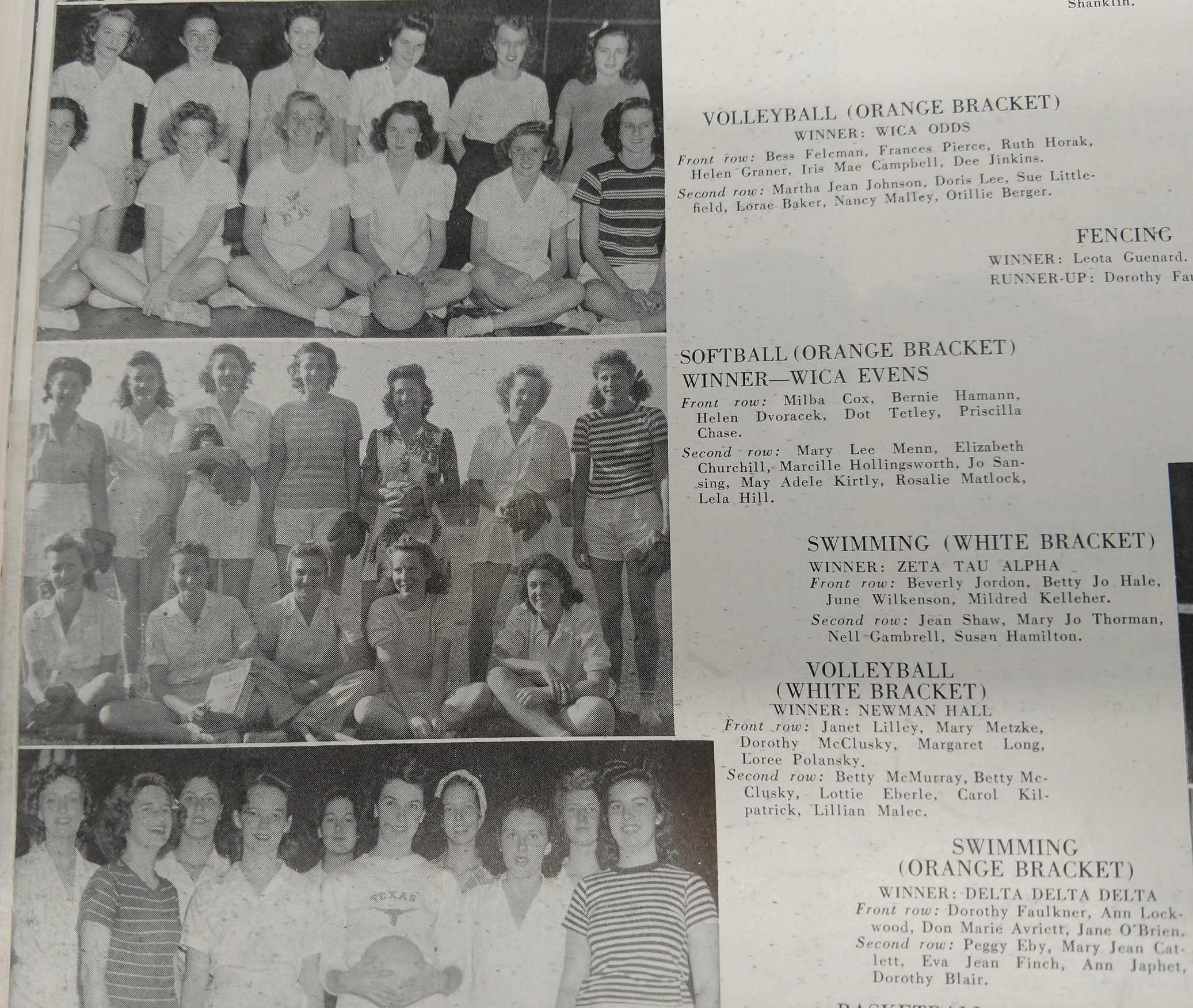
Jane Patterson is a pioneer in women’s aquatics and is the first Texas female to wear a tank suit. Undefeated from 1947-1955, she held every major state record when she retired.
Jane is inducted into the Texas Swimming Hall of Fame for her contributions to the sport as a swimmer, coach, and supporter of swimming in Texas.
1949
Professor Hiss is awarded an honorary doctorate from Boston University.
Top of the Charts 1949
The high school physical education association decided to get involved with women’s basketball by supervising the competitive activity. Rules were established for women’s basketball, and a playoff system was organized and sponsored for Class A and Class B high schools.
In Reflection
1914 Anna Hiss enrolled in Sargent School (Boston University. She was elected president of the student government and editor of the first yearbook. Through the years she also studied at the University of Colorado, University of Wisconsin, Mills College, Stanford University, and Columbia.
1918- joined the faculty at Texas advanced from instructor to associate professor, to associate director, and in 1941 full professor.
1919- Honorary degree of Doctor of Science in Physical Education.
1923 organized the state Association of the Athletic Federation of College Women that was affiliated with the National organization
Introduce women’s athletic rules and policies
Chairman of University Recreation Committee – she directed the intramural Athletics for Women and eventually held the role of faculty advisor of the Texas Sports Organization.
Organized the state Association of Physical Education for college women
1914 -Organized with Dean of Extension, Statewide recreation conference in 1914 followed by the Governor’s Conference on Recreation.
Contributed materially to the work of the National Education Association.
Helped develop programs for Health, Physical Education, and Recreation.
1920= Evaluated facilities for the building, equipping, and furnishing of women’s gymnasiums, and for the development of the women’s athletic field and all-weather tennis courts. Written for “Modern Trends in Physical Education for College women.
She has written articles for the Alcalde, Interscholastic League, Texas Outlook, Journal of Health, Physical Education and Recreation,
1931- Anna was involved in the construction of the first gym for women.
1935-1936 wrote “A Study of Women’s Athletic Associations in Colleges and Universities” under the National Amateur Athletic Federation women’s division
Co-authored “The child of the Texas one-teacher School”. In 1936 Anna received a B.S. degree from Columbia University.
1937 Collaborated with Dr. Frank Lloyd of New York University on the Physical Education section of Health in Colleges.
1948- Honor Award Fellow, elected by the American Association for Health, Physical Education and Recreation for college women
1949- Co-Chairman of the International Congress of Physical Education for girls and women in Copenhagen, Denmark.
1949 Professor Hiss is awarded an honorary doctorate from Boston University.
A member of the Southern Association of the Directors of Physical Education for College Women- “The Freshman program of Physical Education in the General College.”
Received honor award by the Texas Association of AAHPER
Member of the Alumnae Advisory Cabinet of Sargent College of Physical Education of Boston University.
Listed in American Women. Volume 2- Leader in education” and in Who’s Who of American Women.
Women’s Sports History 1896-1921
Anna Hiss Favorite quote “A Sport for Every Girl and every girl in a sport”
Most of the research for the history of Longhorn women’s sports was derived from books written about Longhorn sports including the “Cactus” which has great photos of the history of Longhorn sports. All of the books are listed in the credit section on this website.
In addition to these books there is one study and one thesis that discuss in detail the evolution of Women’s sports at the University of Texas. Miriam Richards writings delivered as part of the Capstone project in 2012, and Tessa M. Nichols, B.A. thesis written in 2007 titled Organizational Values and Women’s Sport at The University of Texas, 1918-1993 add much needed professional depth to the the history of women’s sports at UT Austin. Tessa Nichols thesis is one of the first attempts by any individual to historically and empirically discuss the influence of the Longhorn Women’s sports leaders Anna Hiss, Betty Thompson, and Donna Lopiano. Miriam Richards link and a summary page of Tessa Nichols thesis are in the credit section and their comments are incorporated into the History of Longhorn sports on the TLSN site.
This link takes you to Miriam Richards insightful work on the history of Longhorn women’s basketball. The link is on the the Lutcher Stark Center web site- http://www.tiki-toki.com/timeline/entry/33089/An-Evolution-Texas-Womens-Basketball/
It is stated in a report titled “A History of Women in Sport Prior to Title IX” Submitted by Richard C. Bell, Ed.D., J.D., that prior to 1870, ‘s women sports were recreational rather than competitive. It was believed that each human had a fixed amount of energy. If this energy were used for physical and intellectual tasks at the same time, it could be hazardous (Park & Hult, 1993). Horseback riding for pleasure, showboating, and swimming became fashionable, but women were not encouraged to exert themselves. Such physical activity for a woman was thought to be especially hazardous during the time of the month she was “periodically weakened.” In 1874, as women were beginning to gain access to higher education, Dr. Edward Clarke published Sex in Education, or, A Fair Chance for Girls, which sparked a tenacious and acrimonious debate about the capacity of women for physical activity. He stated that “both muscular and brain labor must be reduced at the onset of menstruation” ( p. 102). Manipulating science to reinforce established dogma prevailed for many years in spite of repeated examples of women who were perfectly capable of performing physical feats and intellectual tasks. Many early opportunities for women to engage in physical activity were thwarted as a result of this dogma (Park & Hult).
1896 Stanford and Cal Berkley basketball teams compete for the first intercollegiate championship
The 1900 Summer Olympics in Paris introduces women’s events, offering golf, tennis, and croquet.
The history of Women’s Sports at the university of texas
1900
Pearl Norvell is Directress of gymnastics.
On January 13, 1900, Pearl Norvell organizes the First Women’s basketball game at UT. Miriam Richards writings at the Stark Center state that “Ideson and Whitis coed teams played four rudimentary 10-minute quarters in the basement of the old Main Building. Whitis won by a final score of 3-2. This first game set into motion the emergence of basketball as a popular sport at UT, especially among women.”
1901- Women’s Basketball chooses different rules than men’s basketball
-
In 1901 the men’s basketball game was considered too rough for women, so different rules are established. The players were assigned to one of three sections (see diagram), and once a player is designated a position, she cannot move from that section. Only three dribbles per individual are allowed, and the player can only hold the ball for 3 seconds. Full court sprints or fast breaks were not part of the women’s game.
-
These rules were implemented to reduce too much exertion, which in the early 1900’s many thought could “break something” that might hurt a player’s chance of being a mother. It is thought that too much exercise “weakened” the womanly functions.
-
Dr. William Howard cautions, “no girl with a nervous temperament should go into any athletic contest” because sports place a strain on the nervous system.
1902-Coach Norvell
Competition for Coach Norvell’s Longhorn team consist of high school teams and the Austin YMCA. Women are instructed to not seek Individual recognition for their athletic skills.
Tennis Club
Miriam Richards says that “At the end of the 1902 season, The University’s chose the first “all-star” team. The team receives recognition from the Texan, Cactus, and University Record publications as the varsity squad. Pearl Norvell serves as the coach and has eight players compete against the “Town Girls.” The UT all-star team wins 7-4, with observers paying a 10-cent admission fee. However, men are not allowed to watch so many peered through the windows of the gym and cheered.”
Miriam Richards states “With enthusiasm for playing basketball growing, Director Aden and the Dean of Women -Helen Marr Kirby- keep a close eye on developments of basketball at UT. Basketball teams are not allowed to play off campus and several contest are cancelled due to unidentified “unfortunate incidents” in the inter-class games.
1903
In October 1903, the Woman’s Building opened as the University’s first residence hall for women. Many lawmakers were opposed to spending $50,000 on construction of a dorm for women thinking that college women needed more supervision therefore should stay with Austin families. A tie vote in the House required the Speaker to cast the deciding ballot to approve funding.
In The basement of the Woman’s Building was a gym with a pool, exercise area, dance classes, basketball, and running track.
1904
Louise Wright replaces Pearl Norvell as Director of Physical Training. She helps organize a student-run Women’s Athletic Association to coordinate all UT women’s sports.
She is instrumental in starting the tradition of awarding letters to Tennis players in 1904 and basketball players in 1906.
Texas women host their first out of town competition. The Texan promotes the game as a contest between Baylor and Texas ,but the game is actually against Belton High School. Texas wins 12-6.
Physical training at U.T. becomes a requirement for all women students.
Louise Wright is instrumental in starting the tradition of awarding letters to qualifying women Tennis players.
1905-1921- Eunice Aden
Eunice Aden is named named Director of Physical Training
Eunice Aden is instrumental in building an outdoor basketball court and the women’s gym. She also continues to build on the tradition that recognizes players’ accomplishments with “T” sweaters and blankets.
Miriam Richards’s research states that “Under the guidance of the Director of Women’s Physical Education, Eunice Aden, recreational activities expanded”” Basketball teams are formed for each class (freshman, sophomore,… etc.) During this period, basketball was the only sport with an intercollegiate component, but it is still primarily an intramural and inter-class event. “T” pins, letter sweaters, and a “Texas blanket” are awarded to those students who achieve the highest levels of participation based on a point system which is considered a significant achievement for female athletes on campus.”
1906
“Letters” are approved for Women’s basketball
1907
The Texas women’s basketball team plays Its First Intercollegiate Game Against Southwestern University On Feb. 18th, 1907. Texas Loses 19-18.
1907 basketball
1907 Tennis Club
1908
Image of the 1908 women’s varsity team is from the Dolph Briscoe Center
1909 and 1910
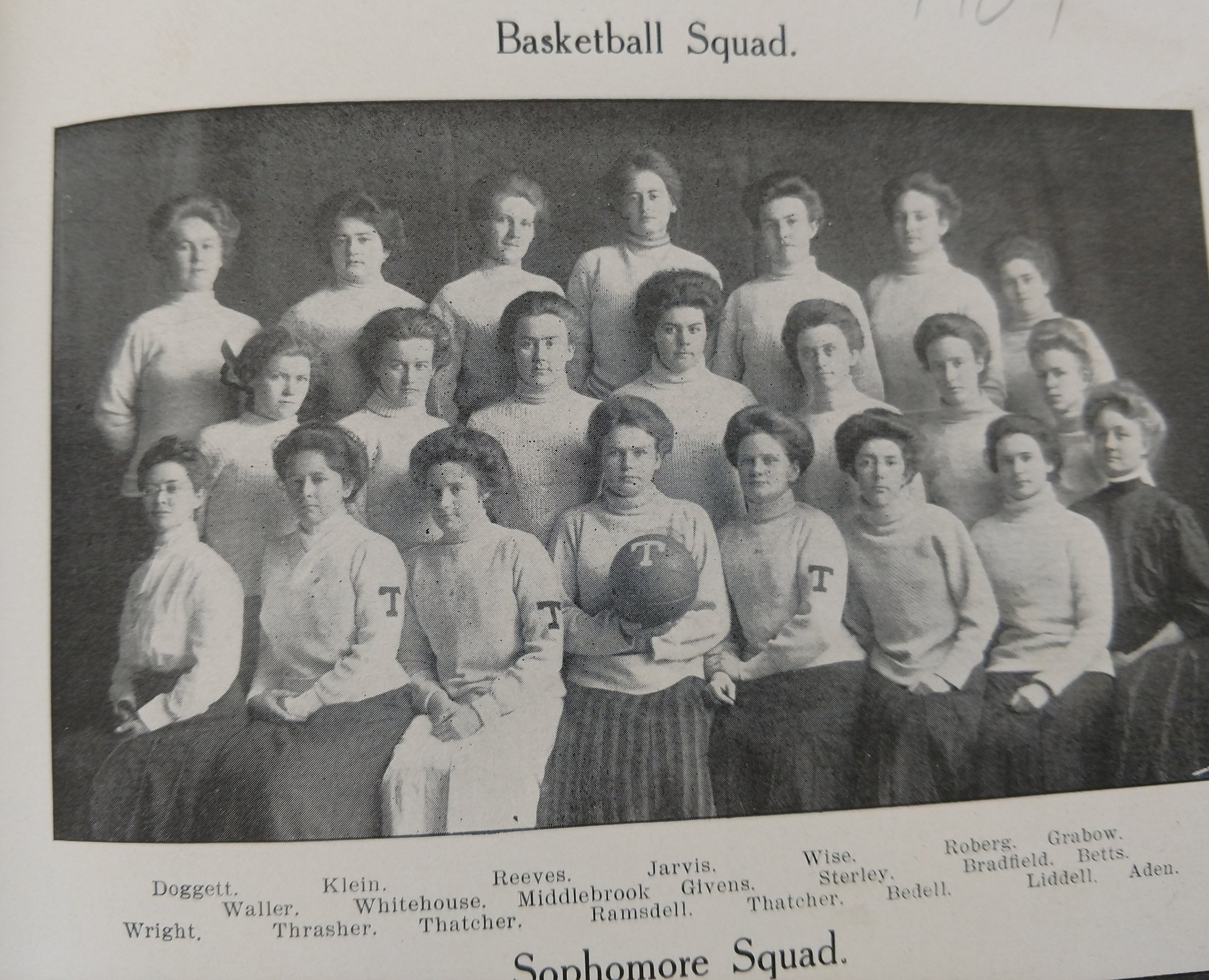
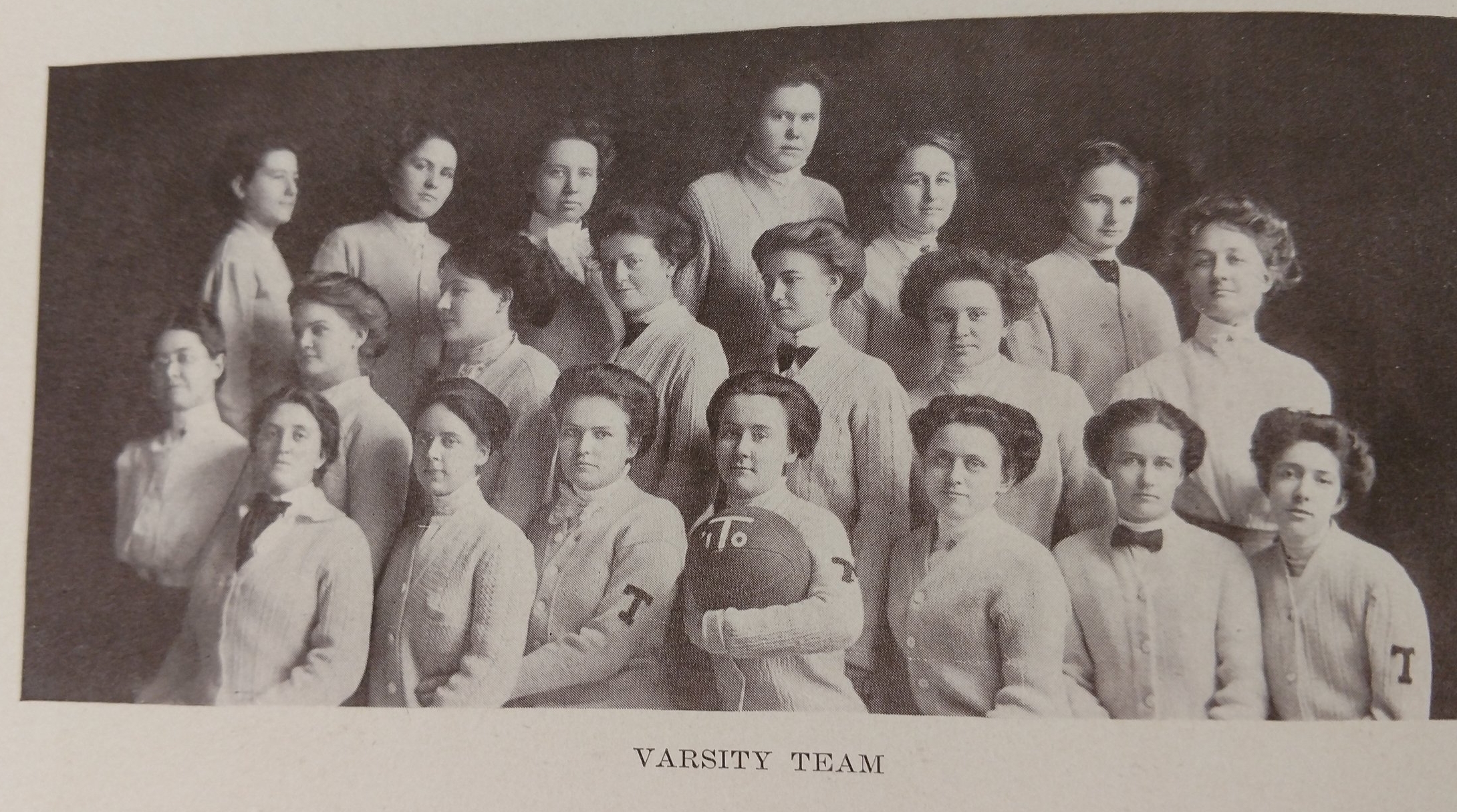
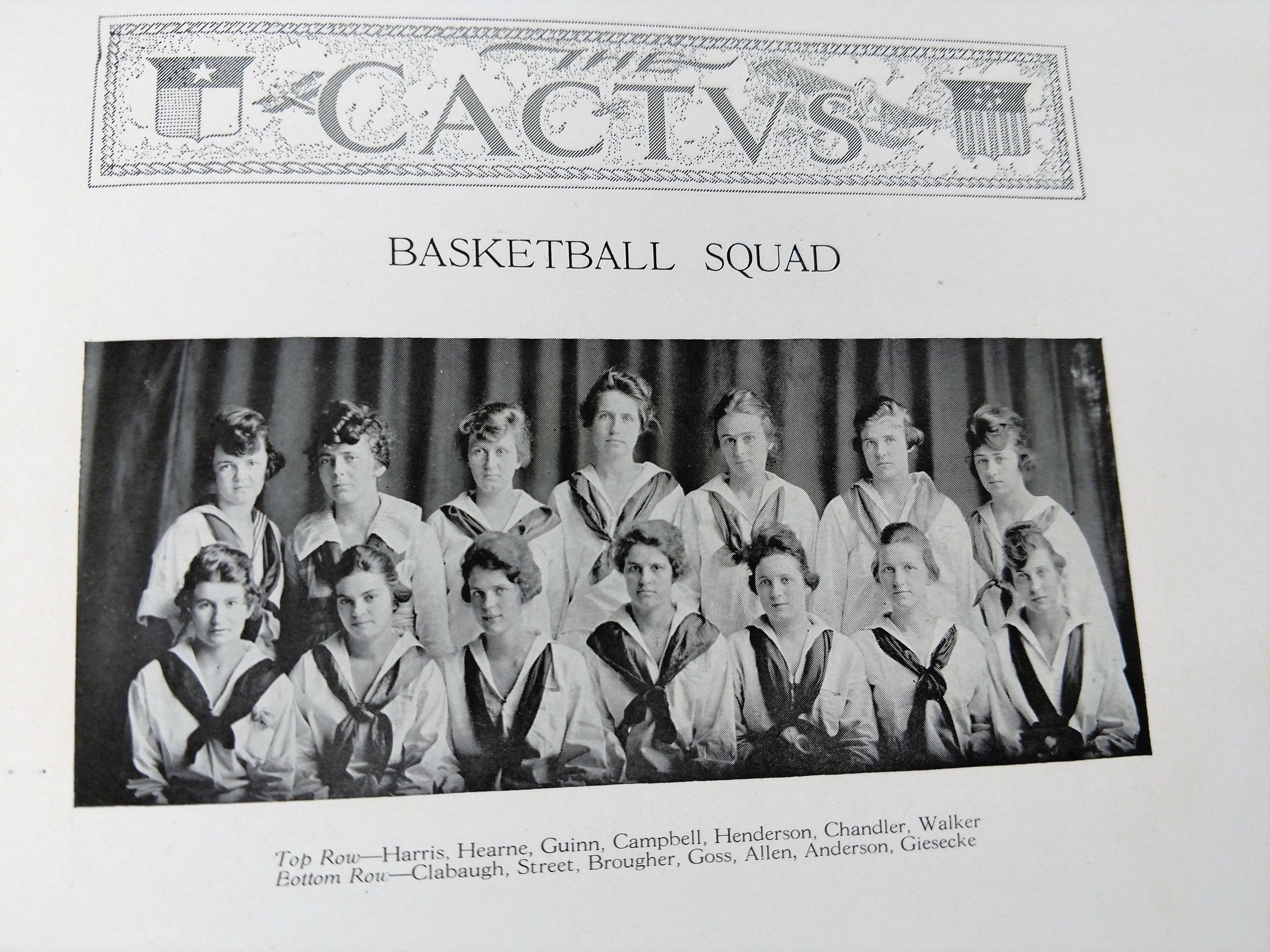
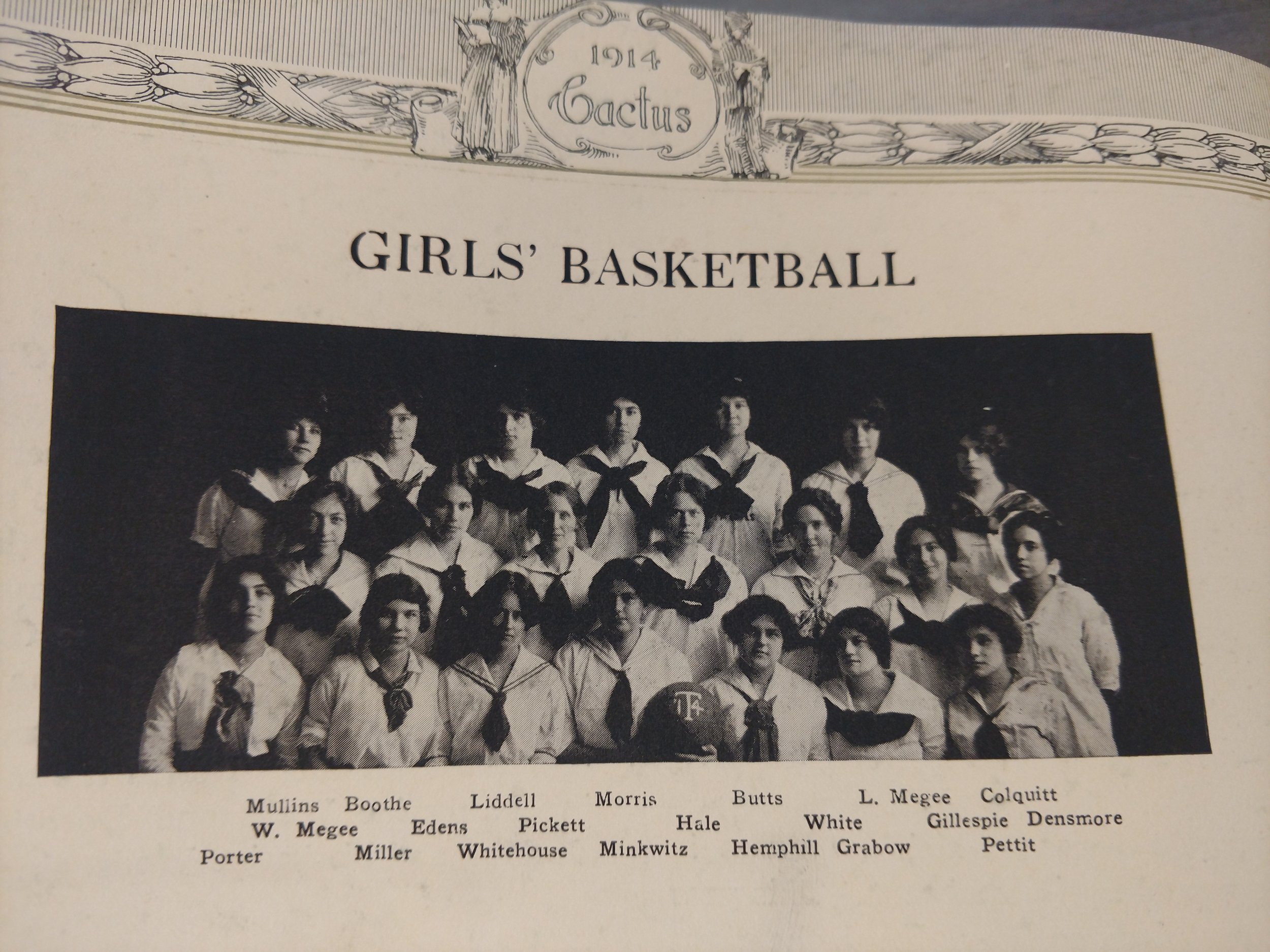
1912
Basketball 1912
1914- North Hall for Women’s athletics
N. Hall known as the “shack” was acquired for women’s athletics. Here is where the UT women’s basketball players practice and play for over 15 years. Staying true to the ideals of the time, N Hall has little standing room for spectators- particularly men.
In the early 20th century there was a reform in women’s active wear. ” The impractical clothing that modesty required impeded andy kind of physical activity. In the case of swimsuits, the impracticality was also dangerous.” ” The weight of the wet swimsuit posed real dangers of drowning.” Quote is from a picture hanging in the LBJ Library titled ” Dress Reform and Sports“.
1916 Longhorn women challenging the status quo.
Until 1916 It was considered “unladylike” for coeds to get too rowdy so they only watched the football rallies. Yell leaders directed the group (sorry, ladies – men only!) in cheers. “Texas Fight!” and “Go, Horns, Go!” were not among them. Instead, one of the most popular was the Rattle-de-Thrat Yell. The program included rousing speeches by the head coach and team captains, UT president, and several deans. Students performed skits that often poked a little fun at the faculty.
But in 1916 the “unladylike” tradition started to change. Coeds were catching the football fever. A 100 or so girls were bold enough to participate in the halftime snake dance at one of the games.
Thru the mid-1920s women were expected to dress fashionably and only allowed to clap, sing, and wave pennants. Yell leaders led only men in cheers. Any women caught “yelling” brought swift condemnation from the Dean of Women. Except for one day in 1916
One day in 1916
1918
1918 tennis
1920 Longhorn Sports
“The suffrage movement and passage of the 19th amendment in 1920 renewed the emphasis on women’s freedoms resulting in modest gains for women in sports. The onset of the Great Depression in 1929 negated most of those gains. Millions of Americans were unemployed, and there was a push to keep women at home and out of the workforce. Not until WWII would women again enter the public sphere in large numbers. ” Quote is from a picture titled “Education and Athletics” found in the LBJ Library.
In 1919 and 1920 Anna Hiss supports the creation of the W.A.A. a student let Women’s Athletic Association. Tessa Nichols states in her thesis that “the promotion of student involvement in the governing bodies of women’s collegiate sport was one of Hiss’s strongest and most commonly overlooked convictions.”




